7 Dec 23 by James Elson
Winter Downs 200 2023 Preview
We are extremely excited to kick off the inaugural edition of the Winter Downs 200 - our first ever 200 miler - next Wednesday 13th December. After 13 years, 55 x 100 milers, 38 x 50 milers and a dozen or so additional events, this is new ground for us and it feels like an exciting new step forward.
The journey the participants will undertake is a 200 mile circuit of the North and South Downs, linked together by the Vanguard Way in the east, and the Wayfarers Walk and St. Swithuns Way in the west. The ciruit on the map looks either intimidatingly huge, or an incredible opportunity to traverse the best of Southern England - depending on your vantage point!
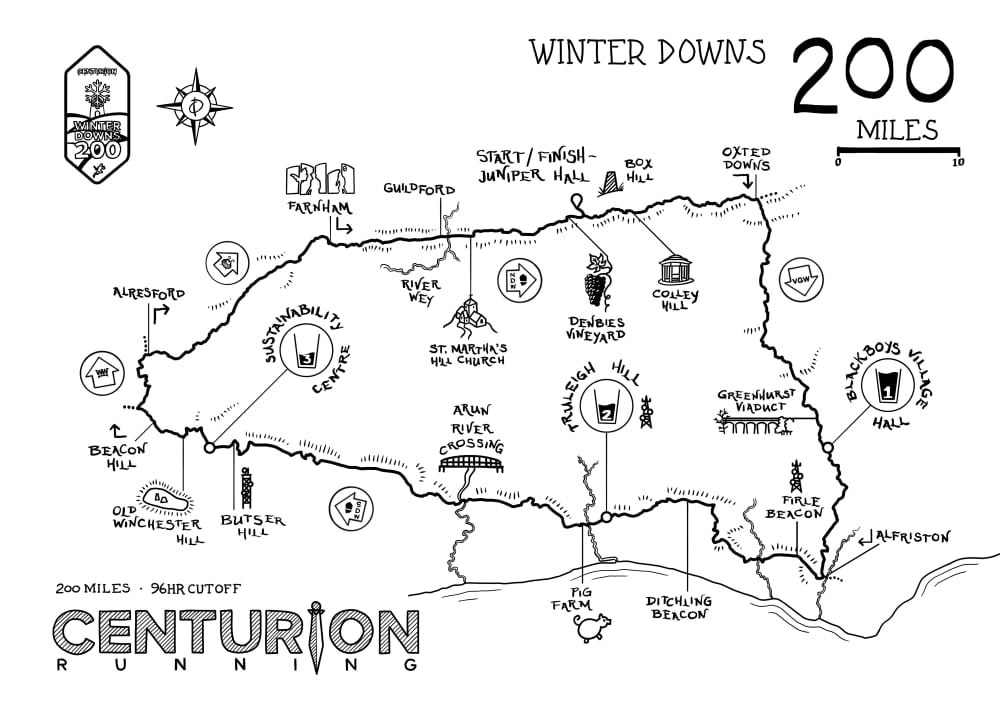
A sell out field of 100 runners will toe the line at this first edition. All applications were individually vetted for experience with minimum standards including 100 mile race finishes and/ or winter & mountain experience so the line up is full of some of the most experienced runners from our events but from further afield too. But as we turn to look at what could happen at the sharp end of the fields out on course, those who have gone beyond 100 before (especially in winter) and know how to manage the multi-day impacts of sleep deprivation, fueling, long sections without support, navigation and 16+ hours of darkness each day - are the ones to keep an eye on as the race moves into the latter stages.
21 women are amongst the 100 starters which is a higher proportion of female entrants than at events such as the NDW100, which whilst low is still notable and excellent to see.
But above all of this it is important to note that runners are allowed to run crewed, partially crewed or unsupported. That is entirely their choice. There are no separate categories but of course, those who choose to have a crew will have a very significant advantage in terms of options on changing clothes, nutrition & hydration needs and getting rest too. Only 20% of the field are choosing to run uncrewed and from what we know all of the potential front runners have support.
Before we have a look at the likely overall contenders in both the womens and mens fields, there are one or two special cases we need to mention....
Live tracking for the race is available from 0800 Wednesday 13th December via the tracking page here.
We will also be covering the race with regular video highlights so stay tuned to our instagram and YouTube Channels for more.
LEGENDS
Not a term to be thrown around lightly in this sport but there are two athletes we need to draw attention to.
Ian Maddieson: At the age of 81, Ian becomes the oldest person ever to toe the line at one of our in person events. This year, he finished the Jackpot 100 in 37:15 and then went on to cover 241km in 72 hours at the Six Days in the Dome event in the US. British by birth, Ian lives out in New Mexico and during his extended stay in the US clocked up no less than 15 finishes at Western States amongst well over 150 other ultras including scores of 100 milers.
John Fanshawe: At 77 John is the second oldest runner in the field. He is however, much like Ken Fancett a few years his junior, a world class runner. He is the current V75 12hr, 24hr (180km) and 100 mile World Record holder with a time of 20:33. He is running internationally in his age group at the marathon distance clocking a 3:55 in 2022.
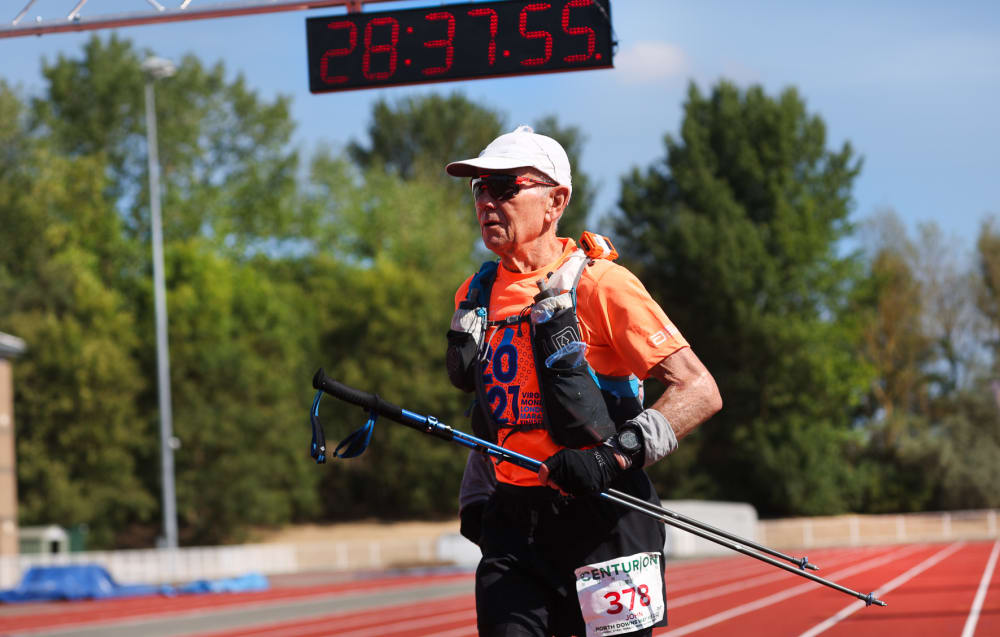
John Fanshawe (Photo c/o Stuart March)
WOMEN
Edwina Sutton: ******Edit 10/12/23 Eddie has withdrawn from the start list for 2023***** Eddie Sutton first came on to the Centurion scene back in 2013 when she had her first tilt at the South Downs Way 50. A career in Iron distance triathlon had preceded that, and she quickly became part of both our Ultra Team and our Coaching Team - roles which she still holds today! Although that first race didn't end well, she came back the following year and ran 7:09 on the course for a win and a course record that would stand for a long time. After some time out around the birth of her third child Evie, Eddie came back to win the Chiltern Wonderland 50 and finish second in the British 100km Champs in 2016. Since then she has raced a variety of distances and formats, running her first 100 at the Autumn 100 in 2019 where she finished second. Earlier this year, she ran the Spine Race and finished third in a time 125 hours, adding substantially to her resume in the process.
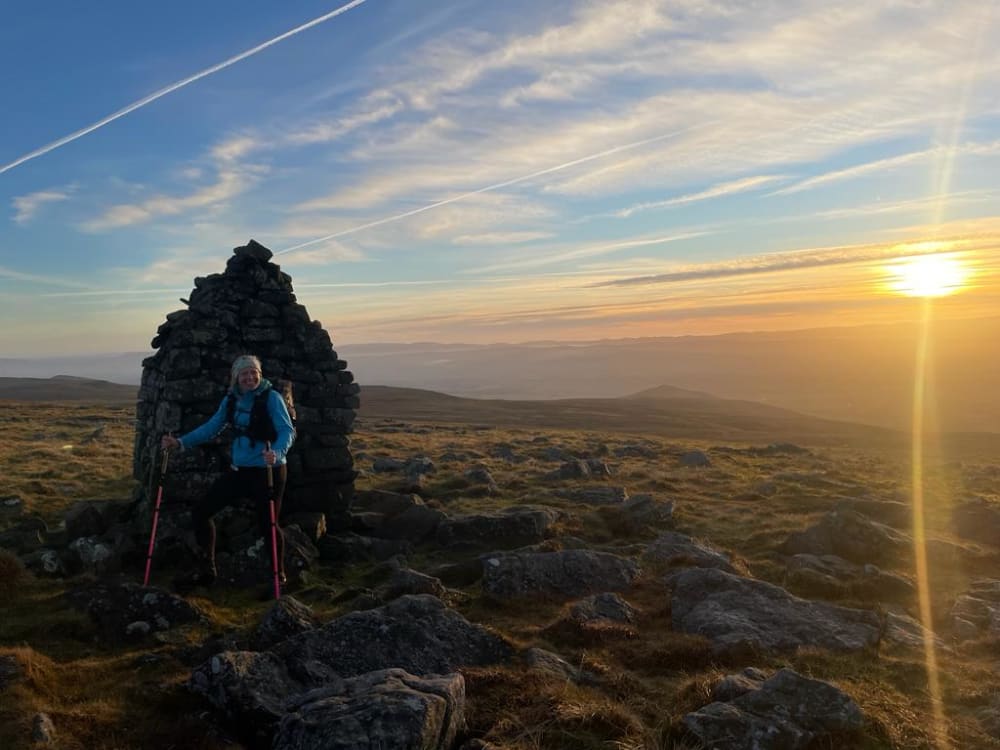
Edwina Sutton on Cross Fell (Photo: James Elson)
Laura Swanton-Rouvelin: Laura is one of the more experienced winter and long distance racers in the field, but coupled with her speed and success over a variety of distances will mean she will be one to watch here. She began with us in 2017, finishing third at the NDW100, before running the Grand Slam of 100s in 2018 - where she finished on the podium at all four, including a win at the fourth and final race - the Autumn 100. In 2019 she won the Arc of Attrition. In 2020 she placed second there in another fine run. Meanwhile she picked up a course record at Chiltern Wonderland and won the Ridgeway Challenge. More recently she has gone longer. With a fourth place at the Winter Spine in 2022, followed up with a second at this years Summer Spine and top ten finishes at races like Lakeland 100 and the West Highland Way Race along the way.
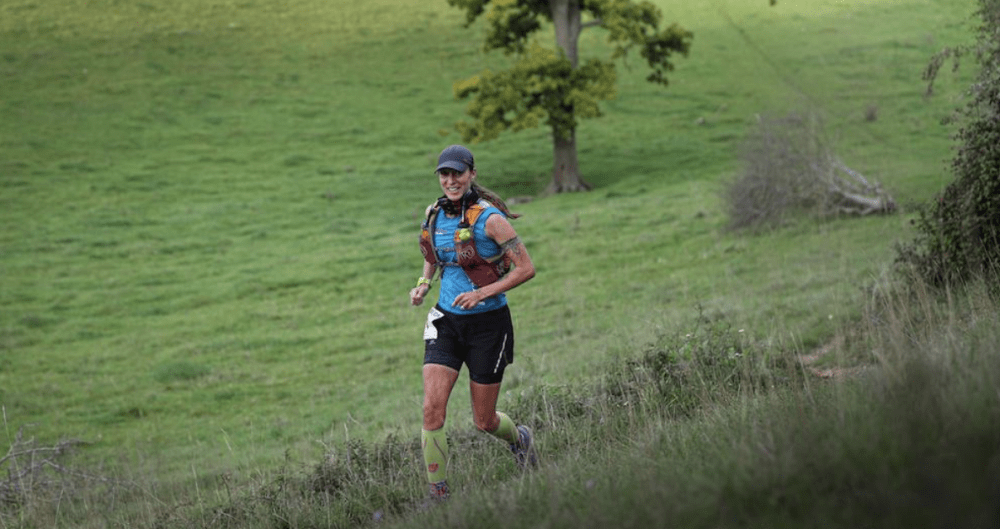
Laura Swanton-Rouvelin on route to her CW50 course record (Photo c/o Stuart March)
Ally Whitlock: Ally's ultra career began with the NDW50 in 2017 and since then she has gone on to steadily improve at a range of distances over time with some super results. More recently she has raced on different terrain and run winter events with success too. Fourth at the SDW50 and SDW100 in 2021, she was then fifth at the TP100 in 2022 before running her best result to date, a second at the Autumn 100 in 18:27. This year she finished third at Wendover Woods 100 and had top ten finishes at both Arc 50 and the Summer Spine Sprint distance.
Rebecca Lane: Another Grand Slam 100 mile finisher, in 2019, Rebecca has a raft of wins and podiums at long distance events, some of which will stand her in very good stead here in terms of both course knowledge but also conditions and terrain. Stand out performances include third at the SDW100, a win at the Chiltern Way Ultra (214km) in 38 hours and third at Winter Spine Challenger in 40 hours in 2020.
Sarah Place: Sarah has built up her resume from 50-100km in 2017 (her best finish with us was an eighth at the SDW50 in 8:44) , through her 100 mile debut at the TP100 in 2018 and on to more recent finishes at the next level of events in terms of difficulty including UTMB, Arc of Attrition and Madeira Island Ultra Trail.
Danielle Harris: Danielle ran our Grand Slam of 100s last year, nipping under 24 hours in all of them with the exception of the NDW100 and postin gtwo top ten finishes along the way. This year she's already finished two of the tougher 100 milers out there, the Arc of Attrition and Wendover Woods 100. Livlng locally to the course, her knowledge of the route and past race experience will set her up well.
Sophie Bennett: Sophie finished her first 100 miler at Wendover Woods 100 this summer, alongside Danielle - a very impressive debut. Then went on to a fifth place at UTMR - Mischabel 100km in September. Last year she came home twelfth at the Dragons Back too.
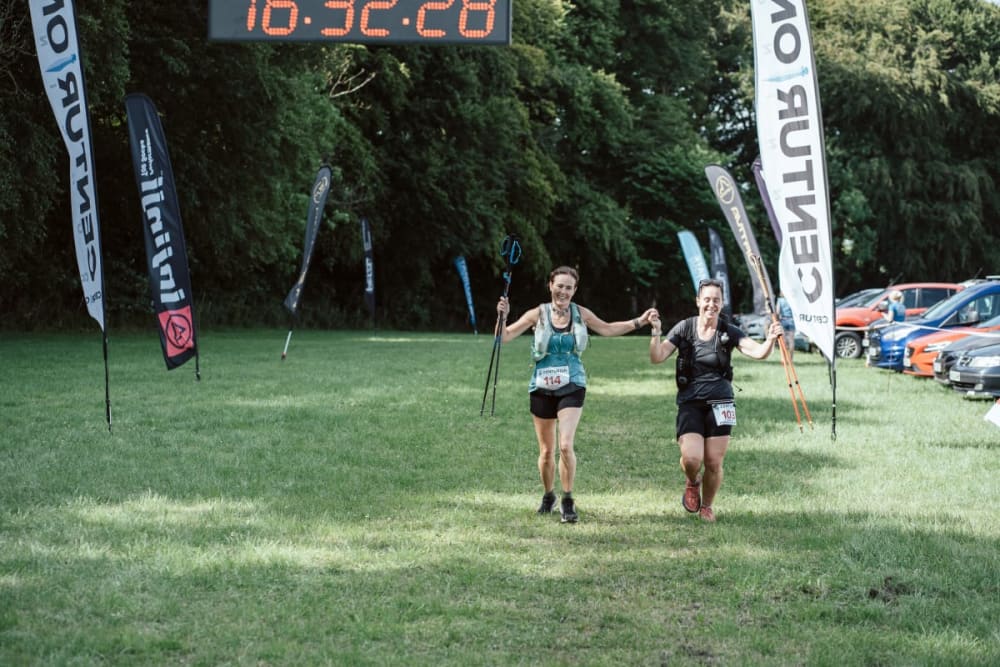
Sophie Bennett and Danielle Harris finishing Wendover Woods 100 in July (Photo c/o Pierre Papet)
MEN
Mark Darbyshire: *****Edit 10th December - Mark has withdrawn from the race with a positive covid test this morning***** Our Centurion Ultra Team man is at the top of the tree when it comes to UK 100 mile racing. After several solid runs at the Beacons Ultra he burst onto the longer scene at the NDW100 in 2019 where he ran home for a huge win and course record that still stands - 15:19. In 2021 he shattered the seemingly untouchable Lakeland 100 course record by 40 minutes, winning the race in 19:10. He also won several other races that year including UTS100km. In 2022 he then took the Arc of Attrition record down to 19:12, a time that still stands 45 minutes faster than anyone elses. Third at Penyagolosa. 19th at UTMB where things went wrong (!!!) and second at Ultra Trail Atlas Toubkal all followed amongst a raft of shorter race wins and podiums. This year he ran home for an Arc 50 record to kick start the year. Then won the Lakes Traverse and then took the win at the inaugural 13 Valleys 180km race around the Lake District by a mere 7 hours.

Mark Darbyshire (Photo c/o: Steve Ashworth Media)
Ry Webb: Ry has been around Centurion events since the very beginning, he ran the inaugural NDW50 in 2011! Since then he's done a host of different events around the world but always seems to come back to include one or two of our events each year, along the way. He joined our team and our coaching team a few years ago and promptly went and won the NDW50 in a course record time (since broken by a tiny margin this year). That followed years where he ran the 50 mile Slam, landing on the podium at all four events. Ran a 100 mile PB at our Track 100 of 13:24. And won the competitive Lakes in a Day ultra. As he stepped up onto the international scene he's had some great results but none better than his fourth place at Leadville Trail 100 this past summer.
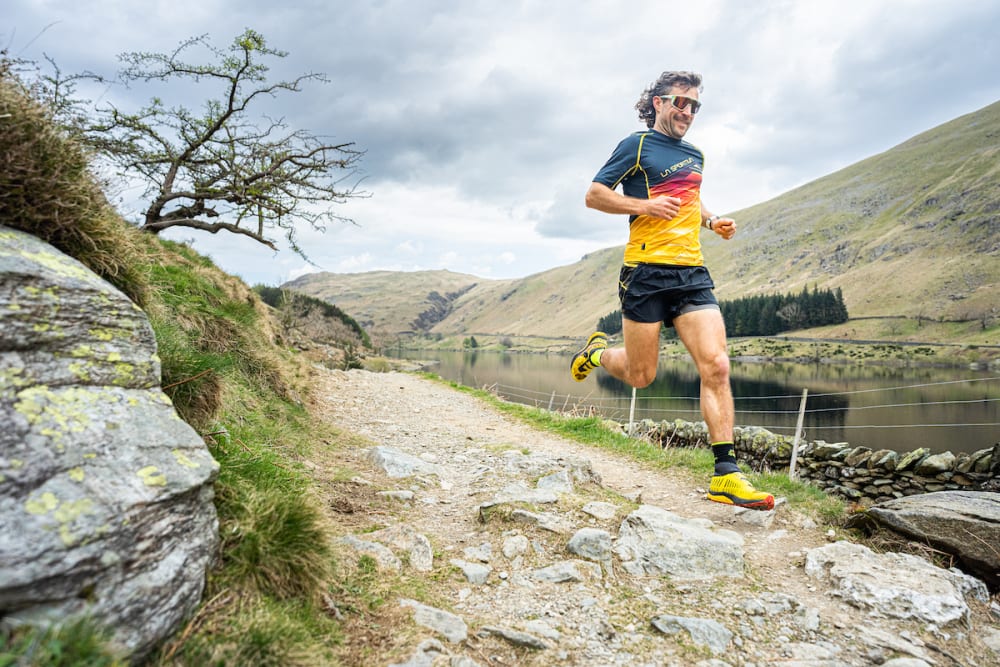
Ry Webb (Photo: Steve Ashworth Media)
Sam Skinner: Sam has had a great 2023 with an eighth at the Arc Of Attrition and a fifth at Lakeland 100, both in the 22-23 hour range. Prior to that he took fourth at the Dragons Back 2022, second at Race to the King and third at Race Across Snowdonia amonst many other solid finishes.
Nicholas Smith: Had an oustanding run recently at the Self Transcendence 24hr in Battersea where he set a new 100 mile PB of 14:06, stopping there rather than pushing on for the full 24. That followed a second at WW50 in the summer and a sixth at the NDW50 in May. In 2020 he won the Robin Hood 100 in 17:23.
Sebastian Betouret: Our 2021 Wendover Woods 100 Champion. Seb has done a lot over the years and specialises especially of late, in doing the very toughest of races out there. He finished PicAPica this summer - the race with possibly the steepest profile of any 100km+ ultra (aside perhaps Barkley), and then backed that up with a run out at a 24hr track race! In the past he's done well at some of the biggest races including Grand Raid Reunion, Tor Des Geants and UTS100 amongst many many others. Picking up good results at shorter races along the way too. Just two weeks ago he was second at Copthorne 100km around Box Hill.
Fumiaki Imamura: A prolific racer, Fumiaki has so far in 2023 clocked up at least 9 ultra finishes including wins at Stort 30 and Essex 100 mile. But has also gained experience in the super long, finishing Northern Traverse and UTS 100 mile too.
James White: James was 16th at the Winter Spine Race in 2023, in a time of 117 hours. In 2022 he was 9th at the Autumn 100 in 17:09 and has previously finished well at both Tor Des Geants and Swiss Peaks 360. He has more experience than most in the 200 mile+ arena.
David Pryce: David ran our inaugural SDW100 in 2012. Since then he has come and gone from regular racing but somehow always seems to be able to turn out great results. Some may remember he even won the Piece of String Fun Run back in the day! In 2023 he has already won the Devon Coast Coast Ultra over 112 miles. Last year he had a solid run out at Autumn 100 with an 18:30 finish. Prior to that he won the Chiltern Way ultra (214km) twice and even ran home second at the Thames Path 100 in a 100 mile PB of 16:56 back in 2014.
Once again:
Live tracking for the race is available from 0800 Wednesday 13th December via the tracking page here.
We will also be covering the race with regular video highlights so stay tuned to our instagram and YouTube Channels for more.
Good to luck to all of our runners!
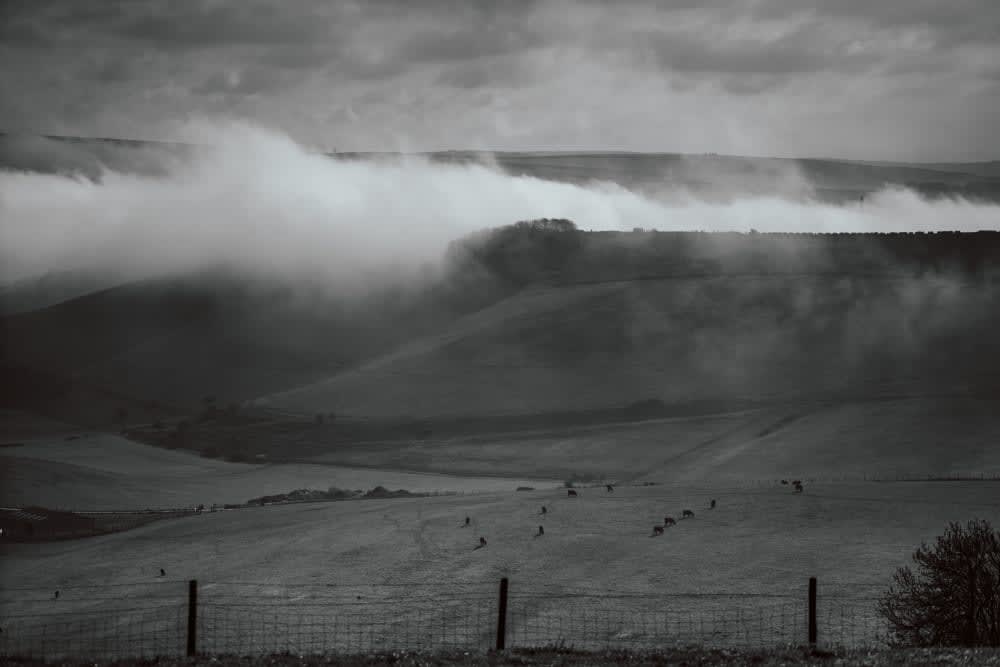
10 Oct 23 by James Elson
Autumn 100 2023 Race Preview
This is the twelfth edition of what is arguably our fastest trail 100, and possibly the fastest in the land. Four, 25 mile out and backs utilising both the Ridgeway and Thames Path National Trails make this a super race for runners and volunteers to enjoy together, with the camaraderie and community feel at the heart of this low key, end of season celebration.
Within the field of 250 runners, 18 are hoping to complete their 100 mile Grand Slam, the current standings are here. But one even more special achievement is in the offing, with Ken Fancett looking to complete his tenth Grand Slam, 42nd 100 mile race with us, his 61st all time Centurion event and 100th liftetime 100 mile race finish. You can listen to a podcast with Ken discussing his career from just last week, here.
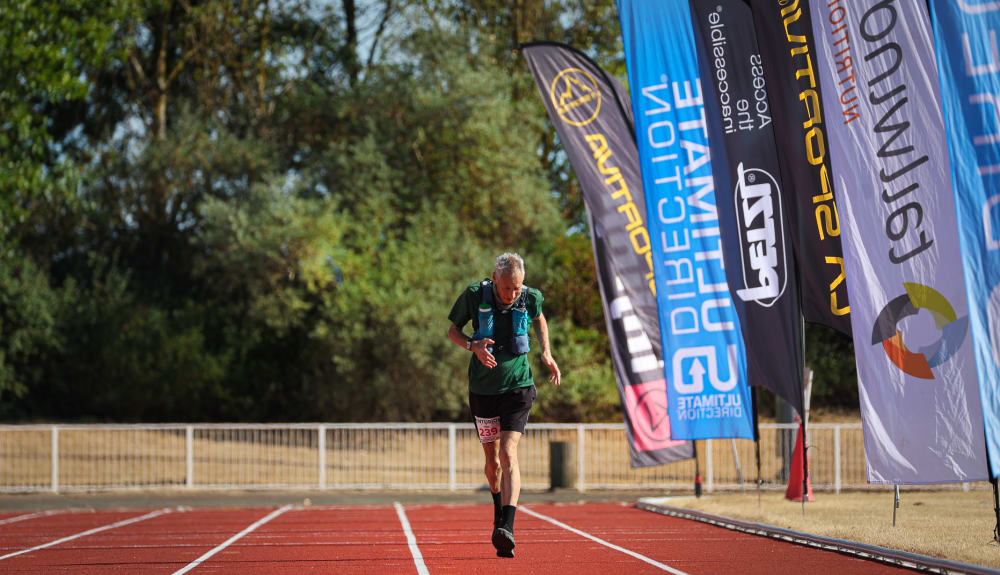
Ken Fancett
Here's a quick look at the likley leading contenders for the overall positions on the day.
WOMEN
Sarah Page: Winner of our SDW100 earlier this year, a breakout result although she also took top honours at the Ultra X Spring Series 75km earlier this year.
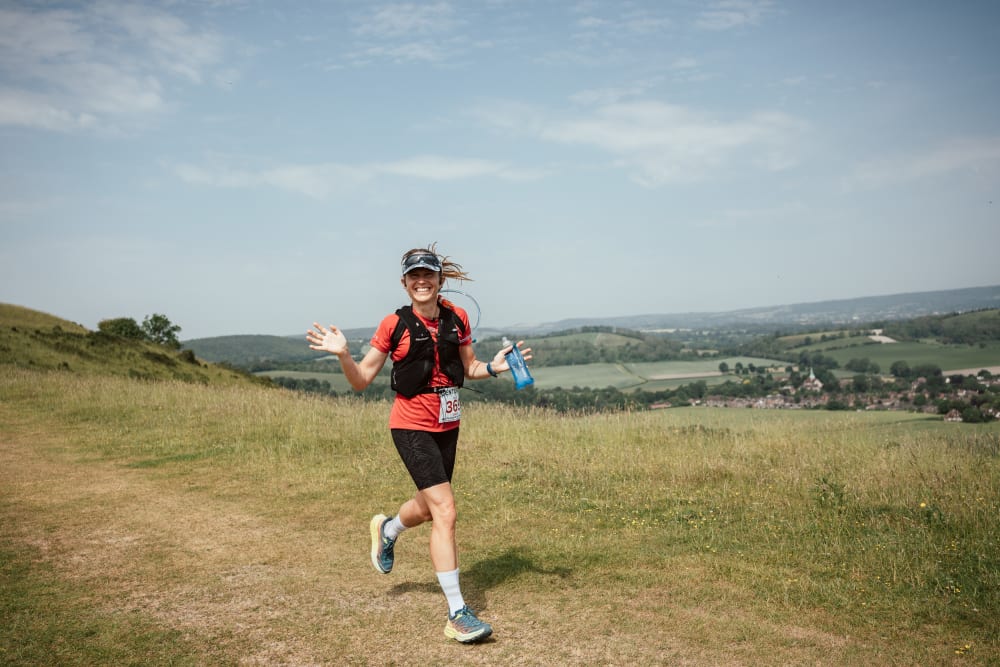
Sarah Page at the 2023 SDW100
Alex Marshall: Alex has wins at literally dozens of lower key ultras but going long, over the last year has a 16:39 for 100 miles on the track and a 17:23 100 miler at the Essex 100 on trails amongst many other achievements.
Melissa Montague: A prolific racer, Melissa placed second at this years Wendover Woods 100, before taking third at the Kennett and Avon Canal Race just three weeks later! She was fifth here in 2022, and has won or podiumed at many other ultras over the years, with stand outs amongst those at GUCR and the Ridgeway 86.
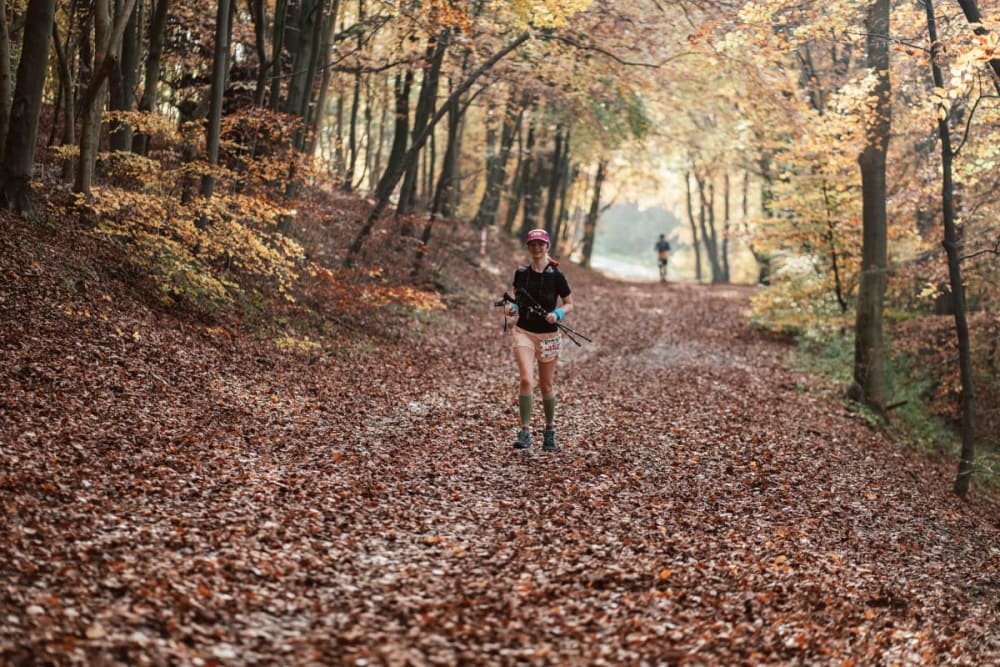
Claire Kanja
Claire Kanja: Claire has finished this event three times, with a best of second place in 2020, in a time of 20:06. This year she already has a fourth at SDW50 and a fifth at WW50 to her name.
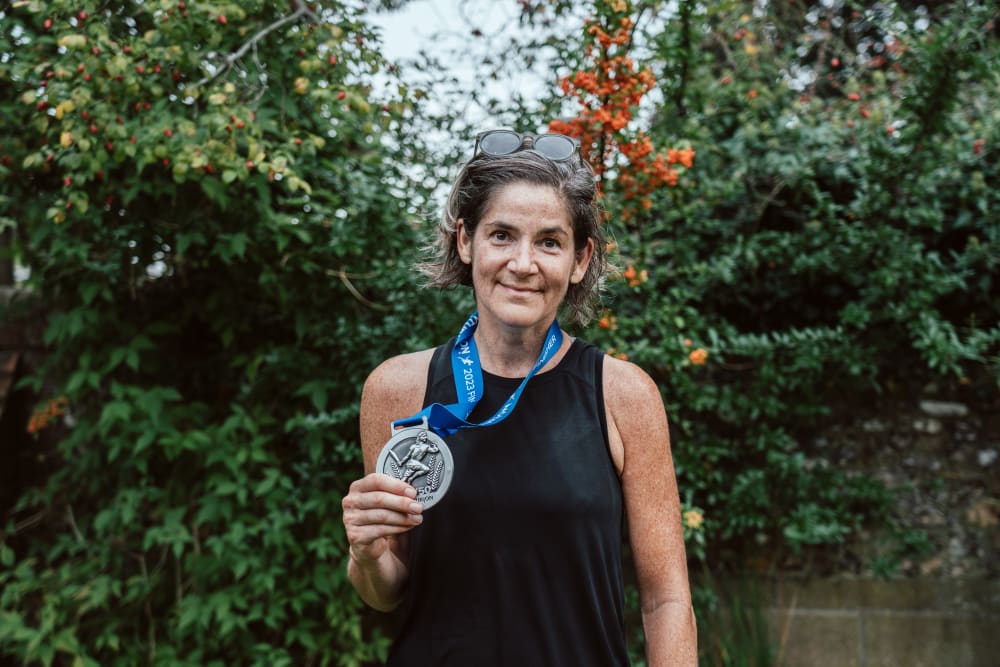
Laura McGill
Laura McGill: Laura picked up second place at the Chiltern Wonderland 50 just four weeks ago in this same area and that followed a sixth at the SDW50 earlier this year. Last year her longer flatter effort at the TP100 resulted in a ninth place finish.
Ruth Hawkins: 2020 SVP100km winner Ruth went on to second place at the Thames Trot in 2021 in a time of 7:02 for the win.
Annabel Cremin: Winner of the Spine Challenger all the way back in 2015, she is no stranger to long hard events. She finished sixth at the UTS 100 mile this year.
MEN
Peter Windross: Pete heads up the 2023 Mens Grand Slam standings and is going for his fourth Grand Slam finish. He was second here in the second fastest time ever back in 2020 - 13:59, missing out on the win by 10 seconds. He's won or finished second at all of our 100 milers in the past and this year has a 14th, an 8th and a 4th behind him so far.
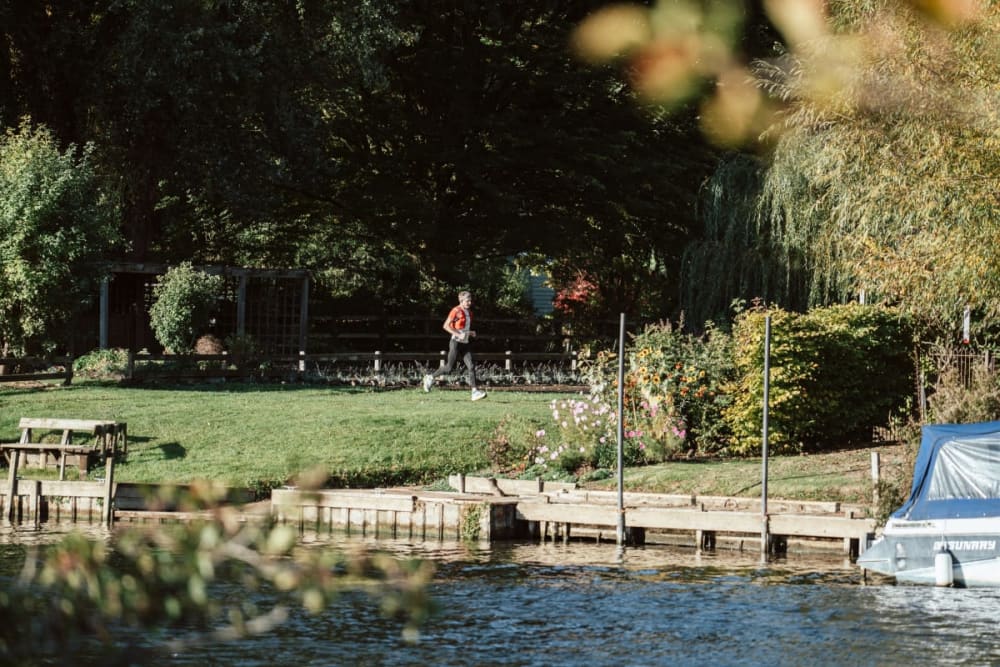
Pete Windross at the 2022 A100
Geoff Cheshire: Geoff won the TP100 earlier this year in 14:18, which considering the conditions may have been his best run to date. He ran 14:31 here for second in 2019. Past wins include the Chiltern Wonderland 50 and Race to the Stones. This year he was also seventh at Lakeland 100.
Rob Forbes: Third at this years Lakeland 100, in a sub 21 hour finish putting him amongst the fastest ever on that course. Rob has enjoyed success at a range of distances and formats over the years from the desert to the trails and back to the roads. Course record holder at Cotswold Way Century, winner of Race to the Stones, a second at the SDW50 and a Top Ten at Ultra Trail Cape Town are stand out results.
Justin Montague: Justin won the Kennett and Avon Canal Race in a scorching 24:30 back in July, having had to drop out of the WW100 with injury. He was second at this race last year in 15:13 and is running as well as ever, which is saying something as this man has been competing at the top end in ultras for 14 years, with more wins and podiums than you can shake a stick at.
Matt Gallagher: Very consistent over our 100 milers in recent years. This year finished fourth at the TP100 in 15:34. Last year, seventh at this event in 16:34 and fourth at the NDW100. The year prior, seventh at the TP100.
Andrea Fraquelli: Outsider role, but a 2:29 marathon indicates he has some speed to mix it up a little.
Follow the race live from 0900 Saturday 14th October via the link here.
12 Sep 23 by James Elson
Chiltern Wonderland 50 2023 Race Preview
Another glorious weekend awaits with the eighth annual Chiltern Wonderland 50 upon us. 250 runners will descend on Goring on Thames to see if they can complete this stunning trail 50 mile loop and it's circa 6000ft of climbing to make it back inside the 13 hour cut off.
Below is a quick look at the likely leading contenders. Live tracking will be available as always from 0830 on Saturday 16th September via the link here (will be updated to the CW50 table just before race day).
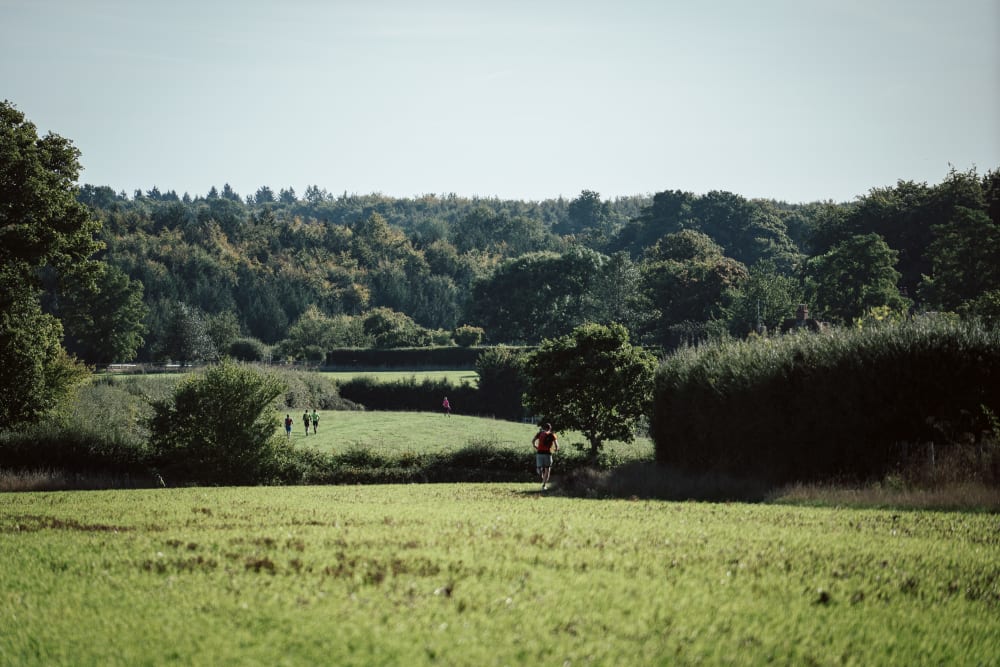
WOMEN
Sam Amend: Needs no introduction. Twice Track 100 winner with two British 100 mile records set with a best of 14:10 for 100 miles. Other Centurion wins include NDW50, TP100 and WW50. Has represented GB at all ultra distances on the road and track 50km, 100km and 24hr.
Sophie Biggs: Last years champion finished in 7:55 for her debut Centurion win, after a third place at the NDW50 earlier in the year. Sophie was sixth at the Hundred Hills 50km back in March and has since gone on to a win at Maverick X Ultra - Peak District and a third at the Serpent Trail 50km.
Amy Sole: Amy leads our 2023 Grand Slam 50 mile standings with an eighth, a fifth and a third at the previous three 50s so far this year. Second at the Arc 50 in 2022 as well, she is incredibly consistent over this distance on trail.
Laura Mcgill: Laura was third here in 2022 and finished sixth at the South Downs Way 50 earlier this year.
Tamsin Neale: Fourth here last year, she then went on to finish sixth at the 2022 Autumn 100. This year she kicked off with a fifth place at our Hundred Hills 50km.
Stacey Sangster: Second at the 2022 South Downs Way 50 and later fourth at the Wendover Woods 50.
Emily Newton: 10 ultras already in 2023 alone, including 3 wins and 8 podiums. 7:24 for 50 miles at Manchester to Liverpool 50 mile a stand out time.
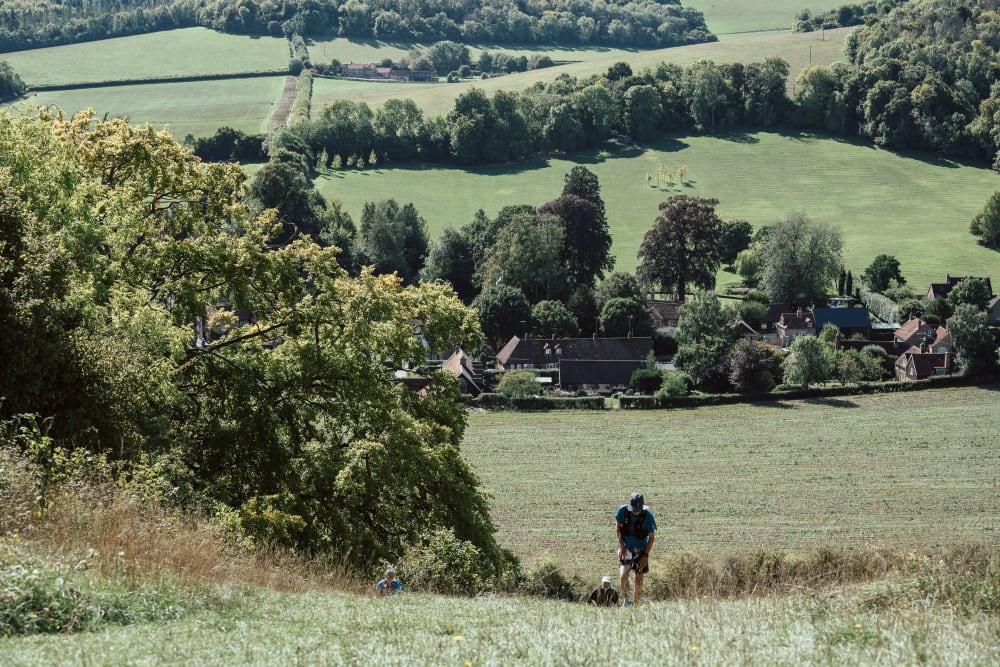
MEN
Gatsby Fitzgerland: Our 50 mile Grand Slam leader has come home sixth, third and fourth in this years' preceeding 50 milers with us. Incredible consistency.
Allan Clarke: Third at SDW100 in June, which followed a fifth at the Lakes Traverse 100km earlier in the spring.
Ciaran Mcaneny: 16:17 at our Track 100 earlier this year and previously ran 80km in 6 hours on the track as his qualifier for that event.
Ash Varley: Ash has been getting faster year on year, with 2022's results including a 7:05 for seventh at the SDW50 and then top tens at the TP100 and SDW100. Previously second place at the NDW100 back in 2020. He was also top ten at Wendover Woods 50 this past July.
Rob Feline: Fifth at the NDW50 earlier this year. Winner of the Fox Ultra and Weald Challenge Ultra in 2021.
Tom Hedges: Going for a third finish here, was a way back in 2022 but started this year with a strong fifth at Hundred Hills 50km.
25 Jul 23 by James Elson
NDW100 2023 Race Preview
This years North Downs Way 100 is the 13th edition of our original event and our 103rd all time ultra. Traditionally the most challenging of the 100 milers that make up our Grand Slam, in 2023 a diversion to avoid the Medway Crossing which is closed to foot traffic for the rest of 2023, makes the course around 2 miles shorter and gives all of the runners a slight break - none more so than those chasing the cut offs towards the back.
Here's a quick look at the likely contenders for fast times and overall positions.
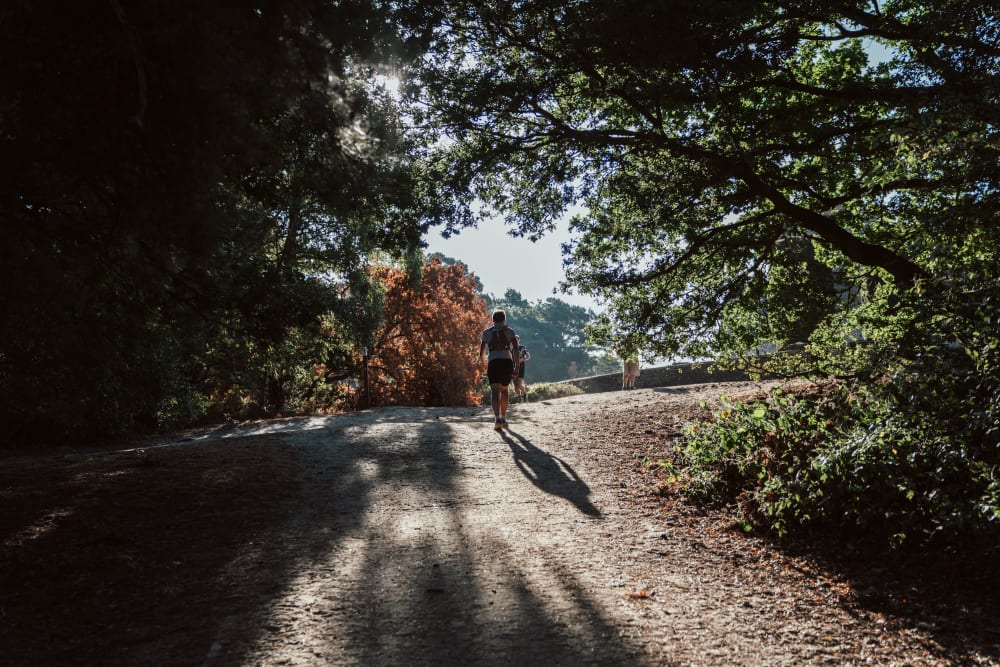
WOMEN:
Jen Wood: Jen was second at the SDW50 earlier this year in a superb 7:29. She's won three of the other five ultras against her name on DUV and has a superb 12hr PB of 130km.
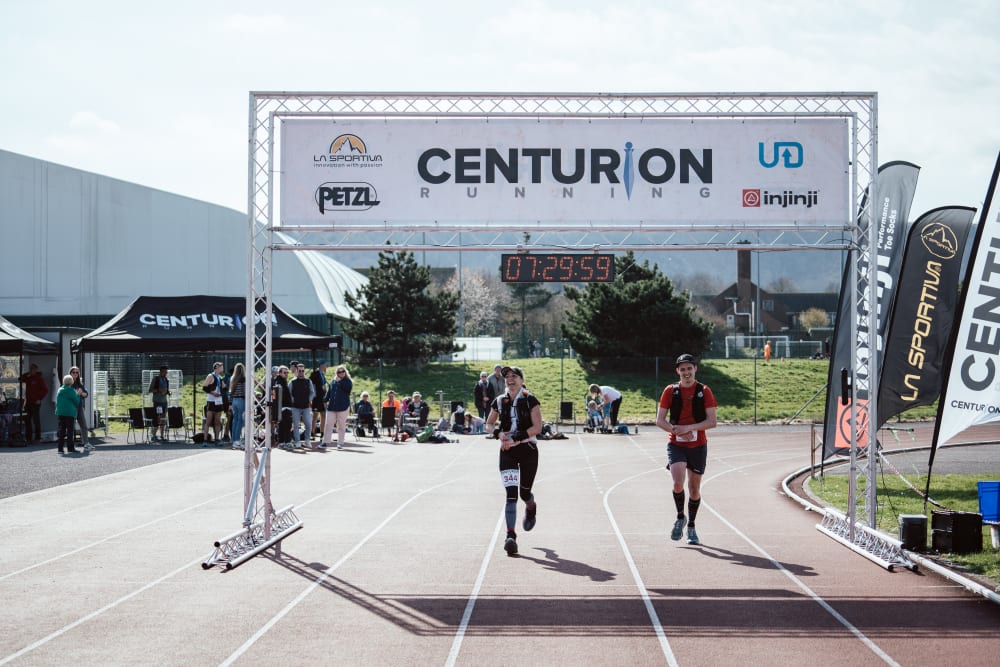
Jen Wood finished second at the SDW50 earlier this year
Susie Whatmough: Suzy won our Wendover Woods Night 50km last year, but had fine performances at Lakes in a Day (fourth), and the Beachy Head Ultra (second) too. This year she finished seventh at the hugely competitive Six Foot Track in Australia as well as second at the Kong Lakes Ultra Long Course in June.
Laura Watts: Regular Centurion runner Laura won the Leeds Liverpool Canal Race last year - 130 miles in a little over 28 hours. She's also previously won the Kennett and Avon Canal Race. In early July this year she finished 12th at Badwater, her second finish there in as many years so she will need to bounce back fast!
MEN
Pete Windross: Pete is going for his seventh finish here and his 23rd Centurion 100 mile finish in the process. He's won the TP100 and SDW100 but not this one.... yet. So far he's gone 64th, 10th, 4th, 5th, 3rd and then was 2nd last year. He's also dropped out having led the race. It feels like surely this is his moment, after a solid 4th at the SDW100 in June.
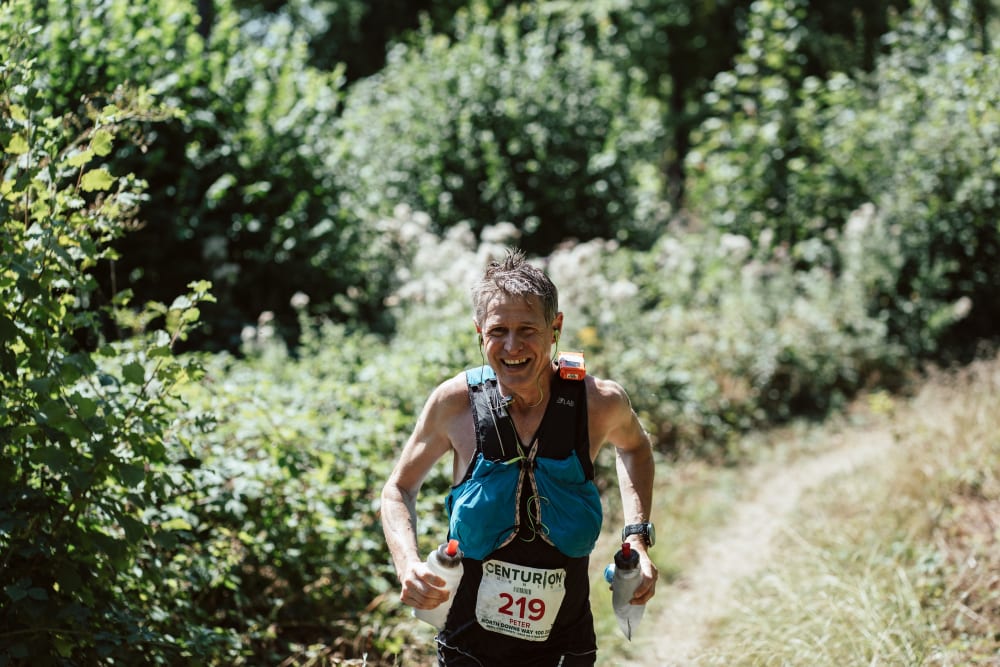
Pete Windross is back and will be looking for that elusive win
Matt Gallagher: Fourth at the TP100 earlier this year followed a fourth at the NDW100 in 2022 and a seventh at the Autumn 100 last October - all in superb times.
Ryan Whelan: The Hong Kong based athlete has done really well at events out there over recent years as well as a few on UK soil. Notably, third at the Hong Kong Four Trails earlier this year, undoubtedly one of the toughest events anywhere in a little over 56 hours. He was also Fifth at Trailwalker earlier this year,
Ben Goddard: Fourth at the NDW50 in 2022 and fifth at the SDW50 earlier this year. He has just tuned up with a sub 5 hour finish at the Wendover Woods Night 50km.
Benjamin Hall: Second at the Pilgrim Challenge on this trail earlier this year, a race he has won in the past. Previous top ten finisher at the SDW50.
Follow all of the action live via the tracker availabe on the homepage from 0700 on Saturday 5th August.
4 Jul 23 by James Elson
Wendover Woods Weekender Preview
The Wendover Woods Weekender is upon us and we are set to welcome possibly the biggest in person gathering of our community that we've ever had.
The events form the backbone of the weekend, but we also welcome guest speakers and brands as well as hosting workshops and guided runs. The Centurion Running Pop Up Store will open throughout and there are food and drink options available too.
In the running, distances range from the kids race and 10 mile / one lap event on Sunday morning up to our ultra distance races. The Night 50km returns overnight Saturday into Sunday and with a start time of 2200 there is always some amazing fun to be had running through the woods under cover of darkness. All three of the shorter events are open for entries on the day. The 50 miler which forms part of our 50 mile Grand Slam and the 100 miler are closed and the entry lists are looking competitive, particularly in the womens 100 mile which should be incredible to watch.
Wendover Woods 100
The 100 miler kicks off Friday at 1000 and runs right through until Saturday at 1800 - a 32 hour cut off. 33 brave souls are aiming to add themselves to the list of just 38 finishers of this race to date. Amongst them is returning womens champion from the last edition in 2021 - Magda Strycharska. She will face strong competition in the form of several other leading ladies. Rachel Fawcett won the 50 here in 2021 in an impressive 9:08, improving on her second place finish the year before - she is also a two time champion of the Chiltern Wonderland 50. Ally Whitlock's most recent long effort was a second place at our 2022 Autumn 100. Melissa Montague who finished fifth at that same race and who has a huge back catalogue of wins, podiums and top tens at ultras of all distances.
In the mens race, Justin Montague must go in as favourite. An ultra career spanning 12 years to date, he ran our second ever NDW100 back in 2012 and finished second. Last year he finished second at the Autumn 100 in a hair over 15 hours. Much like his wife Melissa in the womens race, he's had success at distances from 50km to the super long. Adrian Busolini was a late entrant, he finished fifth at the SDW100 just three weeks ago. A notable mention to Tom Hayward aiming to make it three out of three finishes at this event.
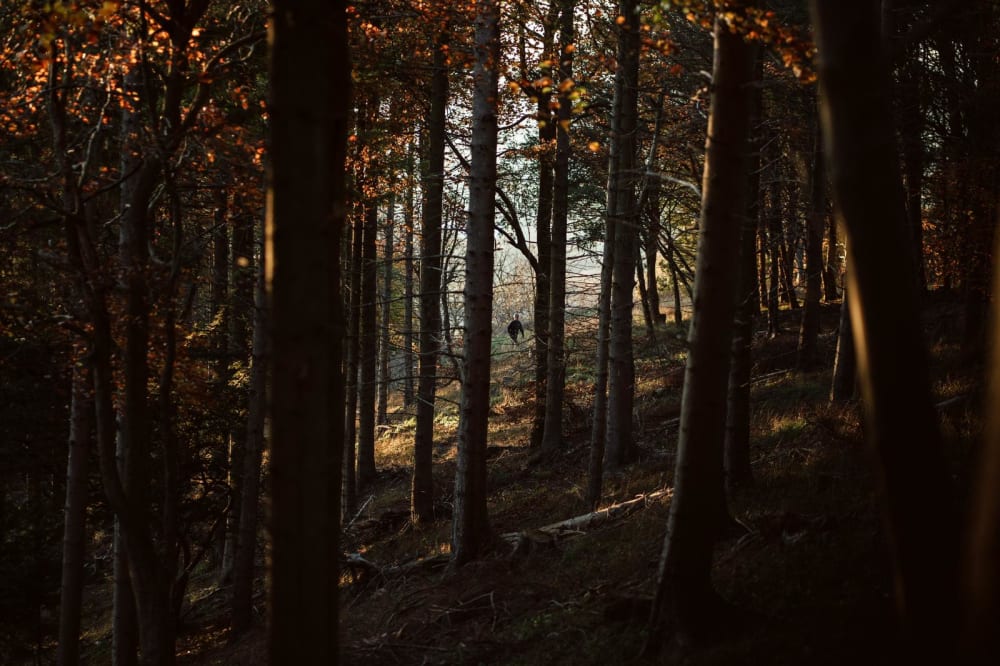
Wendover Woods 50
The 50 kicks off at 0930 on Saturday, offering the 100 milers some company through their latter stages! With a 15 hour cut off, this one usually has runners coming home all the way to the wire. In the womens race, Amy Sole runs, she currently leads our Grand Slam 50 mile table. Samantha Lloyd, fourth here in 2018 and previous podium finisher at the SDW100 goes up against her.
In the mens race, stand out runner is GB 24hr international Rob Payne who was second here in 2019. Jack Oates also runs, he was an impressive 13th recently at the deeply competitive UTS50km - past winner of the Ben Nevis Sky Race and a host of lumpy 50km events. Gatsby Fitzgerald leads the mens Grand Slam 50 mile table from Matthew Selway and both run here of course.
Other Events
The weekend will also see host to a range of Guest Speakers, Workshops and Talks.
Our huge thanks to everyone involved, but especially our team of volunteers, many of whom will be up most of the weekend looking after the runners and campers.
Follow all the races live via the tracker here (link will be updated Thursday 6th July).
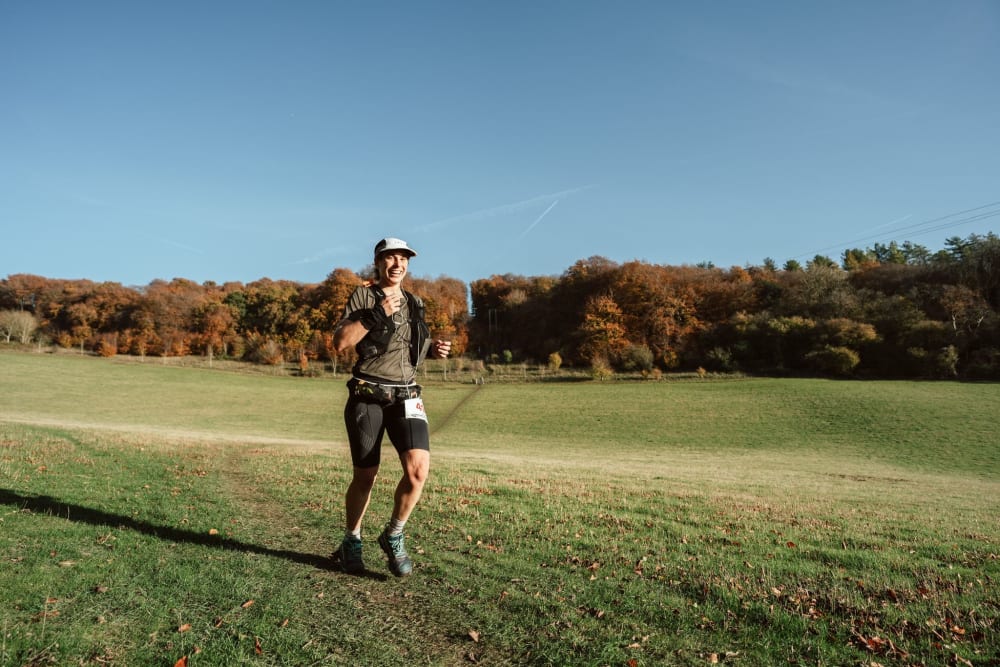
7 Jun 23 by James Elson
SDW100 2023 Preview
The 2023 South Downs Way 100 is upon us. Kicking off at 0600 this Saturday 10th June into what is forecast to be the hottest weekend of the year so far, 400 runners will take on the most stunning of 100 mile courses in an attempt to reach the track in Eastbourne within the 30 hour time limit.
Here's a look at the likely contenders for the podium positions in both the womens and mens races.
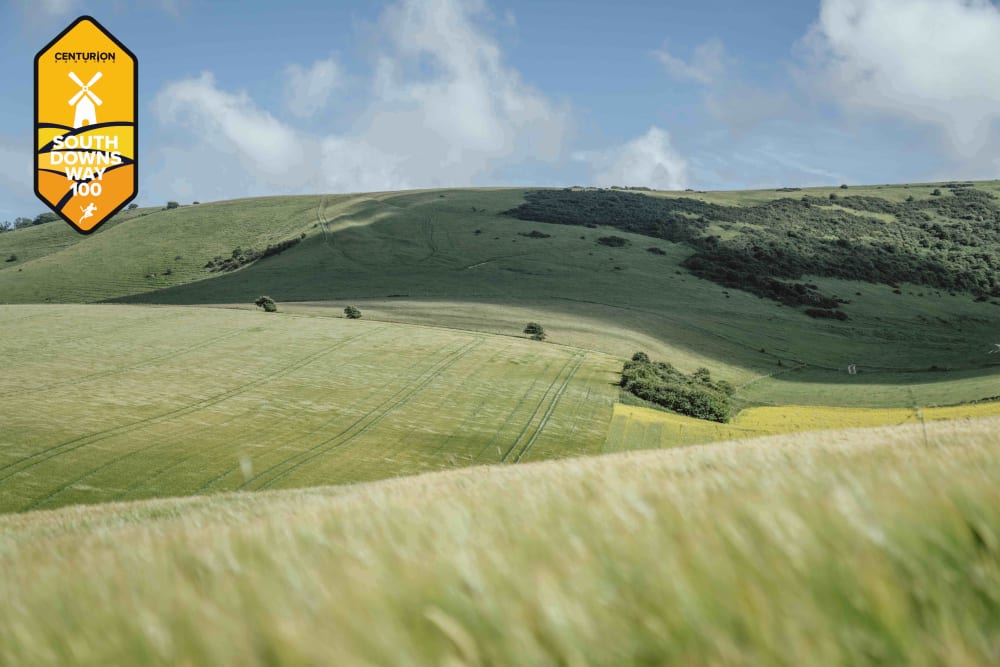
WOMEN
Cat Simpson: Cat has quite the running CV covering road, track and trail. She's been second here before all the way back in 2016 but she's achieved so much since. She's represented GB over 24hrs, run a 15:34 100 mile PB on her way to a win at Crawley 24hr, won the GUCR, finished fifth at Spartathlon and popped under 3 hours for the marathon amongst many other things. She is one of three Centurion Ultra Team runners taking on the womens race here.
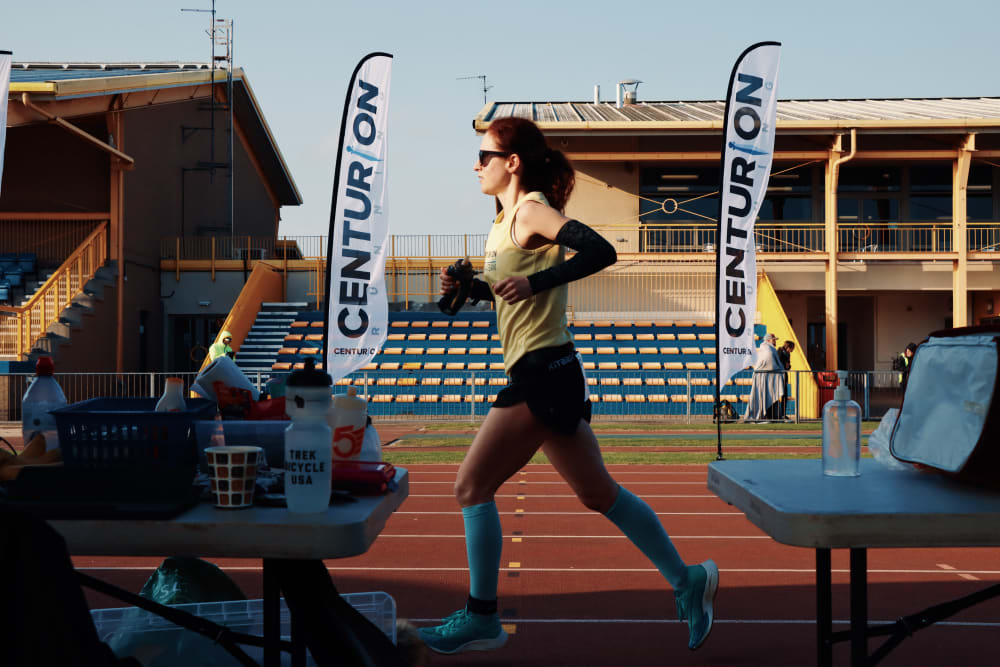
Cat Simpson (Photo: David Miller)
Eddie Sutton: Eddie is also part of our Centurion Ultra Team and much like Cat has a vast body of experience behind her. Eddie set the womens SDW50 Course Record at 7:09 back in 2014 at the second time of asking, this is her second attempt at the 100 after injury the first time around so based on precedent that bodes well for here. Since that time she has gone on to place second at the British 100km champs representing the England Team, won the Chiltern Wonderland 50, placed second at the Autumn 100 and performed highly in various Alpine ultras. She started 2023 with a bang finishing on the podium at the Spine Race.
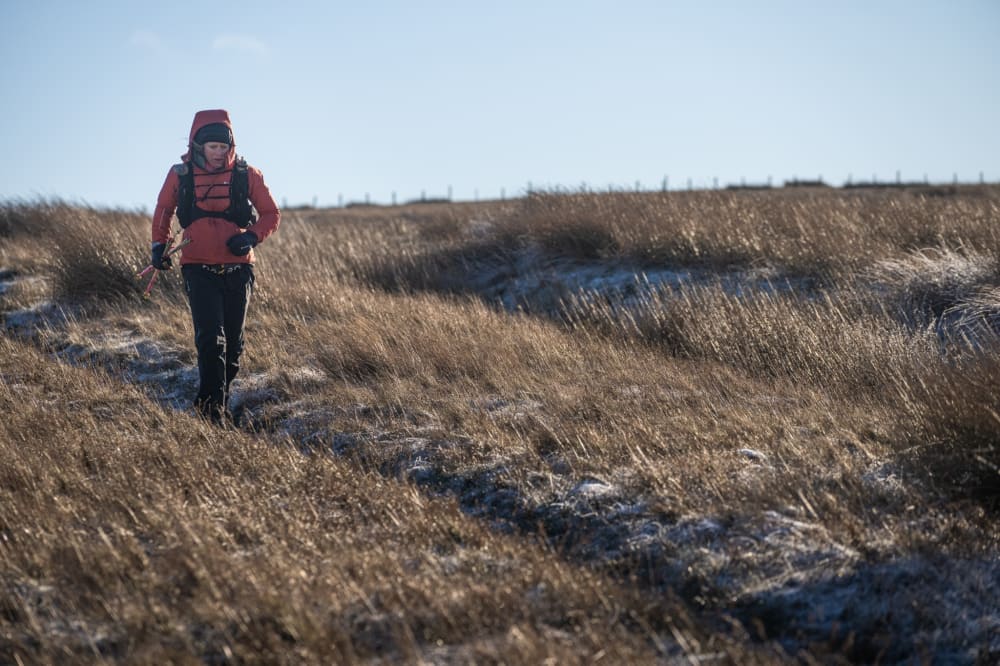
Eddie Sutton running this years Spine Race (Photo: Steve Ashworth)
Allie Bailey: Allie is also part of our Centurion Ultra Team and comes into this fresh off of the back of a win at the Wildhorse South Wales 200. She has finished this event twice before, once as the final part of the 2020 Grand Slam of 100s but she has progressed immensely since then and it will be great to see what she can do here.
Aoife Ni Mhaoileoin: Aoife has already raced three times in 2023 with fantastic results. 214km at Crawley 24hr for third, a second at the D33 ultra and fourth at Donadea 50km. She has plenty of ultra experience behind her over a wide range of distances and terrain types so this race should suit her.
Teresa Reason: Fifth at Wendover Woods 50 in 2021. In 2022 went on to second at Chiltern Ridge 50km, third at Serpent Trail 100km and fifth at Hurtwood 50km. She recently finished eighth at the inaugural Hundred Hills 50km.
Rosalind Wilson: Rosalind finished third at the Classic Quarter down in Cornwall last year and then fourth at EnduranceLife's Dorset Ultra. She is a 3:11 marathoner but this looks to be her first 100.
Sarah Page: Sarah won the Ultra X Spring Trail Series 75km in April of this year.
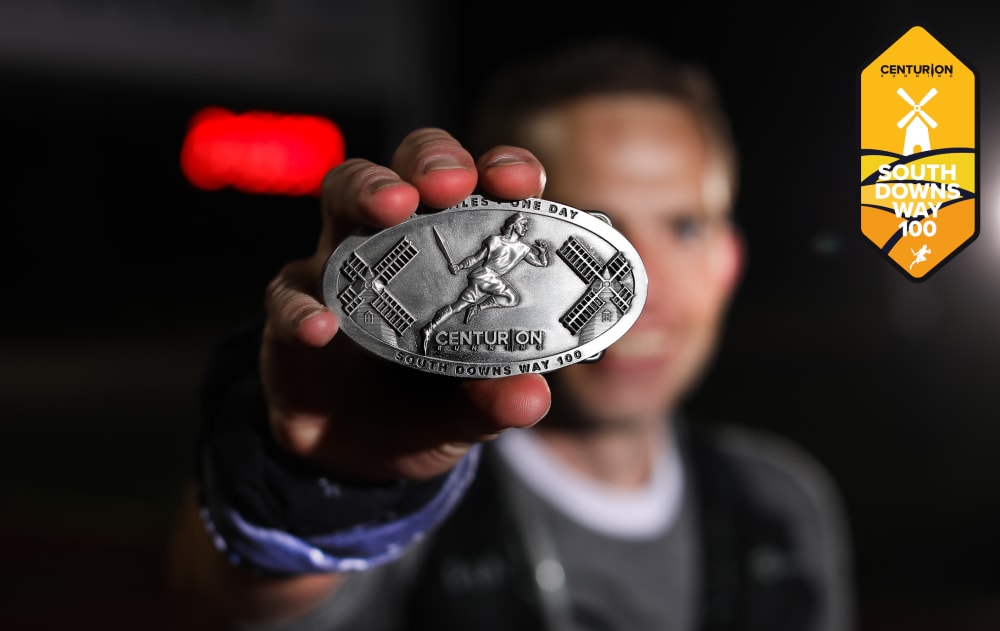
MEN
Pete Windross: The ultimate consistent performer at our events. He has finished the race five times, he won it in 2021 in 15:30 and then bettered his time last year to come home in 15:05 but missed out on the win to Richard Mcdowell, by just 16 minutes. Previous winner of the Thames Path 100, our Grand Slam of 100s (which he has finished three times) and second at the Autumn 100 in 13:59, his 100 mile PB to date. His previous 100 this year at the Thames Path didn't go quite as well as those from 2022 so he will no doubt be looking to bounce back here.
Henrik Westerlin: Danish 24hr Team runner Henrik has a background in ultras across a variety of terrain types and distances. With us, his best was a win at the Autumn 100 in 14:02. This year he's already started well, with a solid finish at Transgrancanaria and then a win at the Lake Zuri 100km in Switzerland.
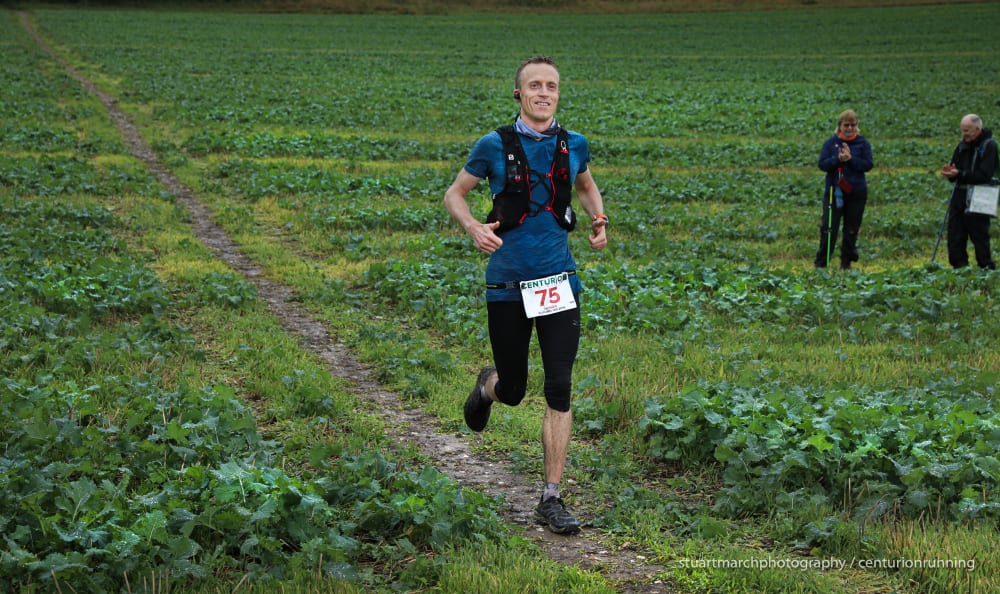
Henrik Westerlin
Jose Rodriguez: Comes in as a favourite after a superb win and course record at the North Downs Way 50 three weeks ago. His time of 6:33, the best we have seen in twelve editions of that event. He was fourth here in 2022 in 16:12 so he knows the course too. Will he be recovered enough to do it justice after just a three week lay off.
Matt Gallagher: Matt has had some really solid consistent results in our 100s in recent years. He began with seventh at the TP100 in 2021, a fourth and a seventh at the NDW100 and A100 in 2022 and then a 15:34 for fourth at this years TP100 - his best time so far. He's had some good wins and podiums at shorter ultras along the way.
Steve Speirs: Steve is an ex-pat originally from Wales but residing in the US. He was second here in 2017 in 16:37, one of many fine results he's enjoyed over the years. Despite being 57 now, Steve has still got great pace, recently finishing sixth at Rocky Raccoon 100, his seventh finish there - in 17:19. He has a whole raft of wins, podiums and top tens amongst his huge back catalogue of ultra finishes.
Jacob James: Jacob was second at the 2022 Chiltern Wonderland 50 and finished the year with a second at Hurtwood 50km. Recently ran a 2:37 marathon PB at London. This is his first 100.
Frederick Levy: Fourth at the SDW50 earlier this year in 6:52.
Alex Sawbridge: Alex was fourth at the SDW50 earlier this year in 6:53, improving upon his tenth place there last year.
Gatsby Fitzgerald: Gatsby was sixth at the SDW50 this year and then ran home third at the NDW50 last month, in 7:11 and 7:15 respectively.
Mike Bisson: Mike ran a strong 100 at our Track event in 2021, finishing in 14:43.
Follow the race live via the website here from 0600 Saturday.
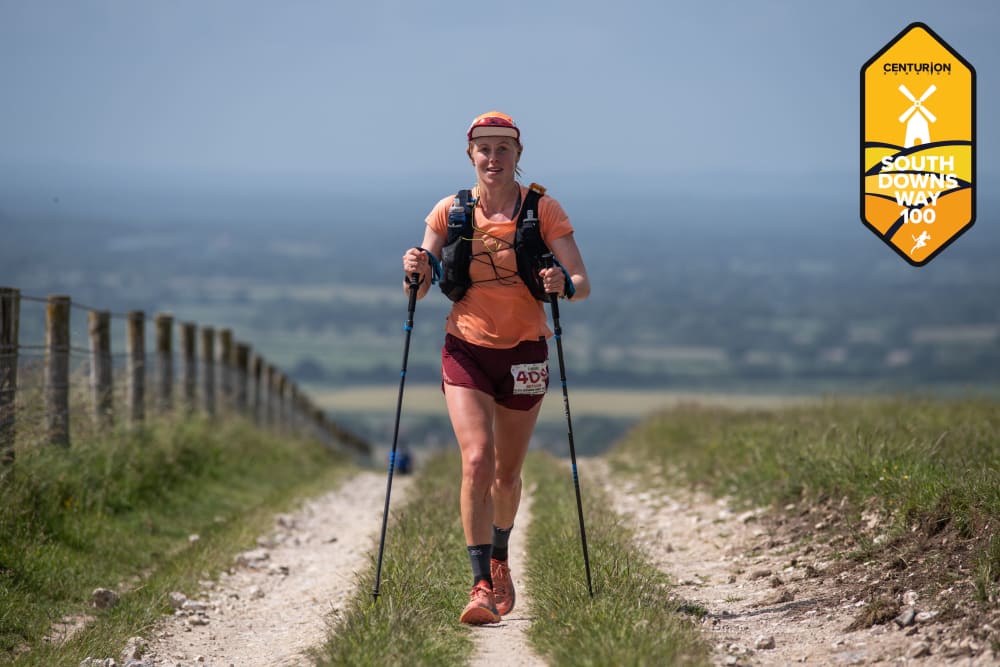
14 May 23 by James Elson
NDW50 2023 Race Preview
The North Downs Way 50 - our first event back in August of 2011, is back for the twelfth edition this coming Saturday May 20th.
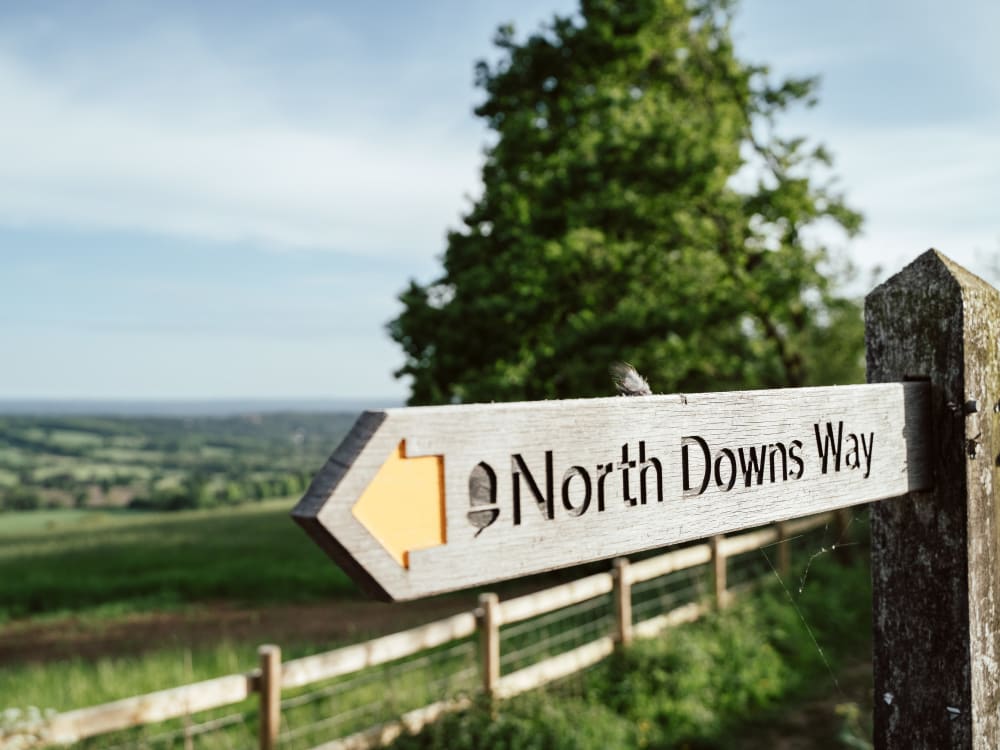
Below is a quick look at the likely leading contenders in our second 50 mile event of the season. A record field of 350 runners are expected to make the start line, with the first wave going off at 0700 and the second at 0800. All runners have 13 hours to make it to the finish, as usual. Fingers crossed we get a brighter day after the rainy TP100 two weekends back!
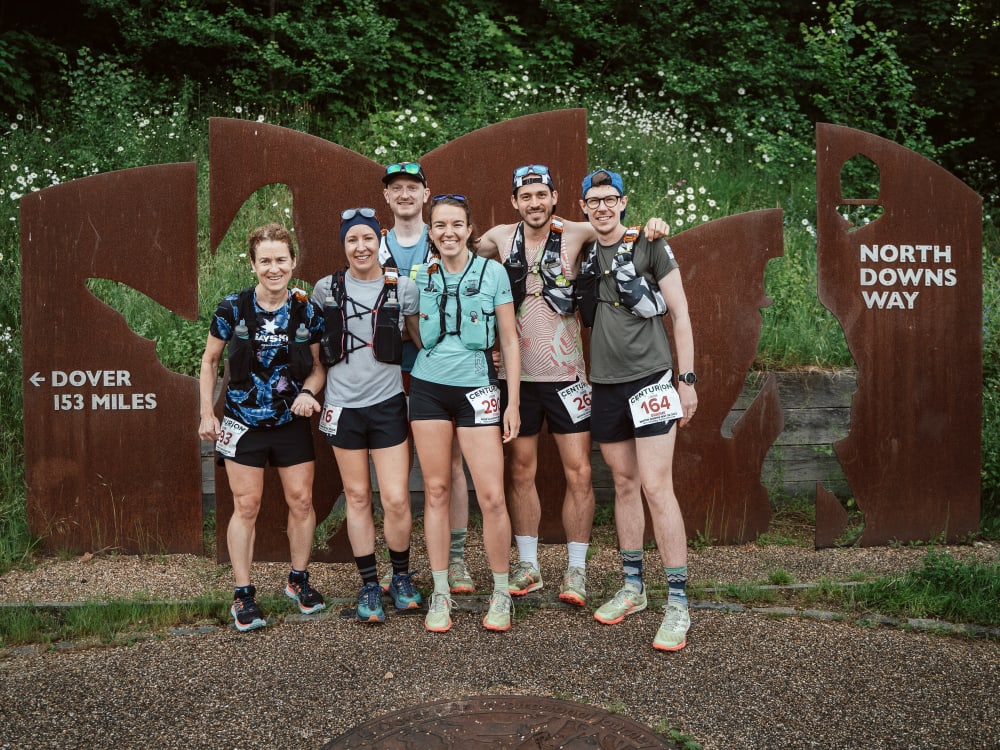
WOMEN
Amy Sole: Amy finished eighth at the SDW50 in April, previously second at the Arc 50 in 2022 and winner of the RAT 50km the year before that.
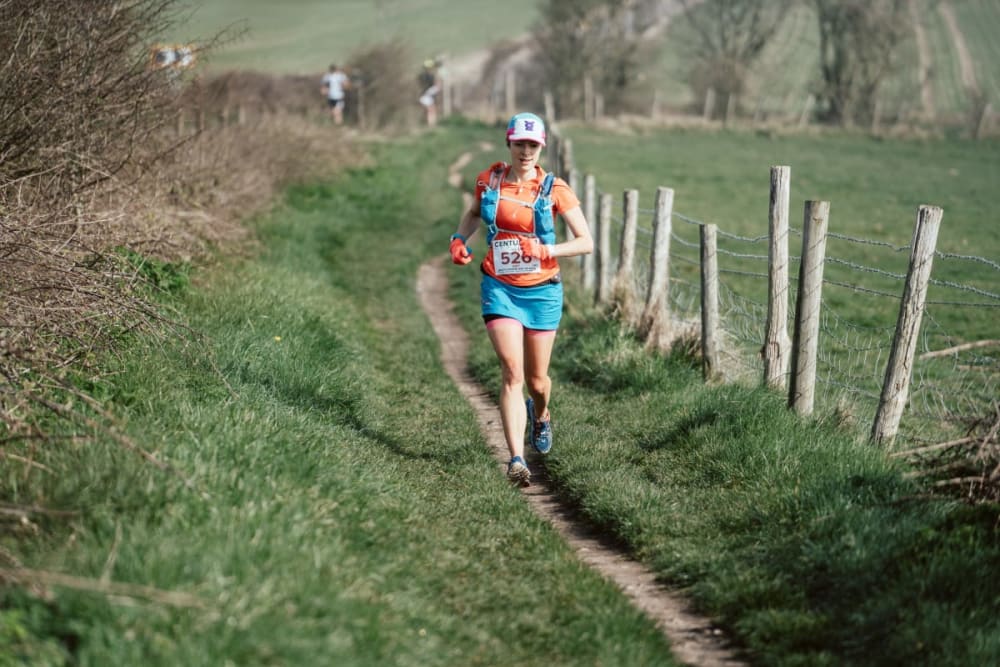
Amy Sole running the SDW50 last month
Dawn Godwin: Fourth at our inaugural Hundred Hills 50km back in March. Dawn finished 11th at this race last year.
Natalie Bunce: Ran a 2:57 at the Manchester Marathon in April.
Eileen Beach: Won the Maverick X Series Suffolk last year over 50km.
Meriel Holden: 3:01 Marathon and fourth at the Maverick X South Downs ultra last year.
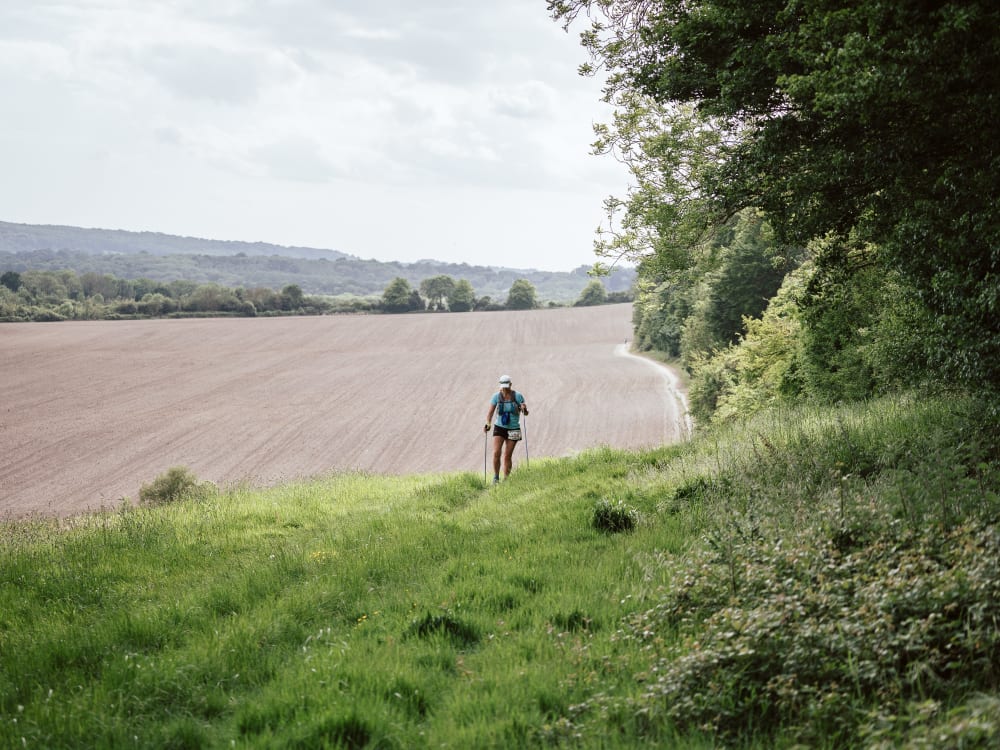
MEN
Jose Rodriguez: Jose ran home fourth at the SDW100 last year in a time of 16:12. He started this year by finishing second at the North Downs Ridge 50km, missing out only to Lewis Ryan who won our SDW50 back in April.
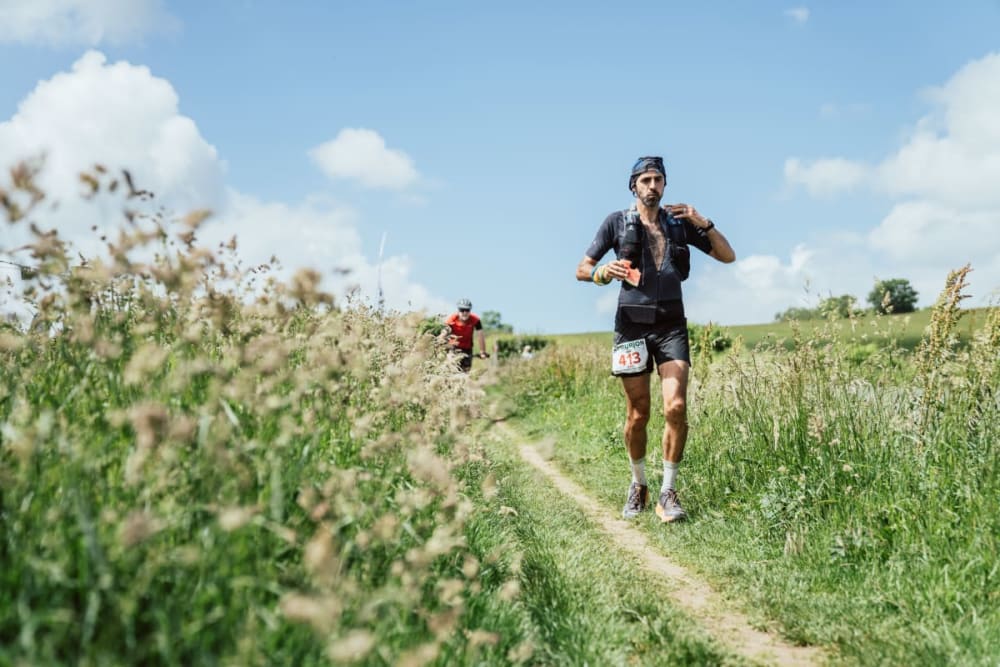
Jose Rodriguez finished fourth at last years SDW100
Joe O'Leary: Joe took third at the Spine Race in January in a little over four days. The Irish runner has also previously finished third at the Spine Challenger and twice podiumed at the Kerry Way Ultranite over 93km. This looks short for him!
Thomas Marchant: Third at last years Chiltern Wonderland 50 in 7:10.
Gatsby Fitzgerald: Sixth at the SDW50 in April in a time of 7:11. 50 mile PB of 6:33.
Jimmy Mould: Third here in 2021 in 7:16. Looks to have stuck to 50km races since then but has performed solidly in those making the podium in two.
Patrick Wightman: Fifth here in 2018 in 7:23 but does not look to have raced an ultra since.
Callum Job: 2:25 Marathon PB at London last month
Jono Wood: A couple of wins at the Copthorne 50km which takes place around Box Hill as well as a win at EnduranceLife's Exmoor CTS in 2021.
Join us live from 0700 on Saturday morning via the website here (Live Link will update to the NDW50 later this week).
2 May 23 by James Elson
2023 Thames Path 100 Preview
A record field of 320 runners is expected at this weekends' Thames Path 100 for the twelfth edition of the race.
The event attracts fast fields and recent winning times have been under 14 hours for the men and under 17 hours for the women. It's possible we will see a new level reached this coming weekend.
Conditions on the trail have been extremely wet through March and April, but as usual, things look to be drying out just in time - with the caveat that rain is expected to fall on Friday and Saturday though it shouldn't be too heavy.
You can follow the race live via the tracking page here. Start time is 0900 this Saturday 6th May and the final cut off is Sunday at 1300 - 28 hours later.
Here is a look at the likely leading contenders in both the mens and womens races.
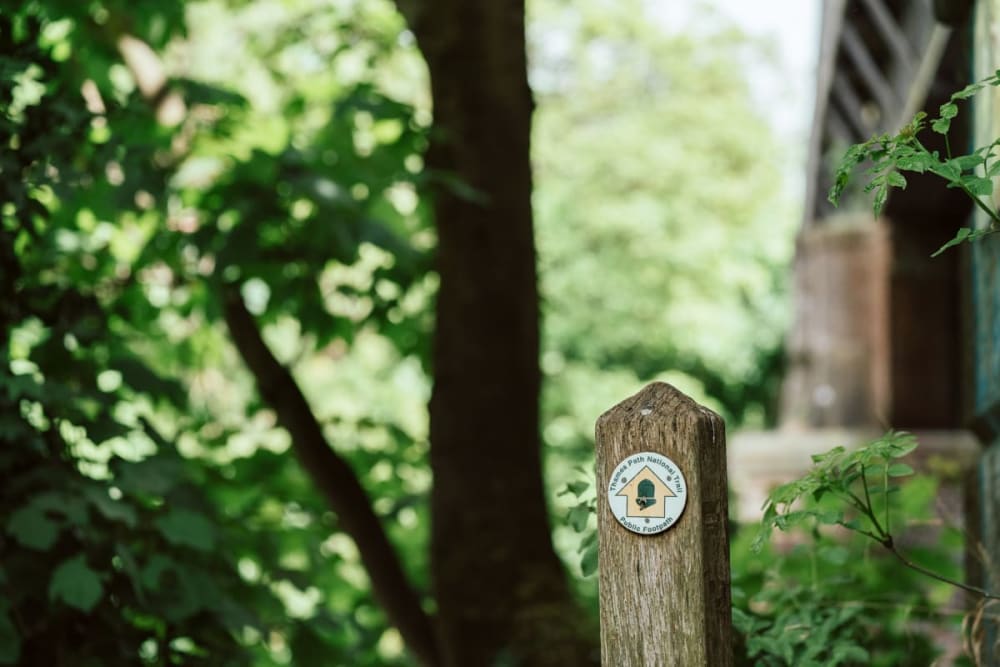
WOMEN
Melissa Venables: Melissa was our 2020 North Downs Way 100 Champion - a race that will live long in our memories as it was the first race after lockdown, in August of that year. British 100km Champion in 2016, Melissa has a raft of great results behind her, most recent being most applicable here - a win at the 145 mile Grand Union Canal Race.
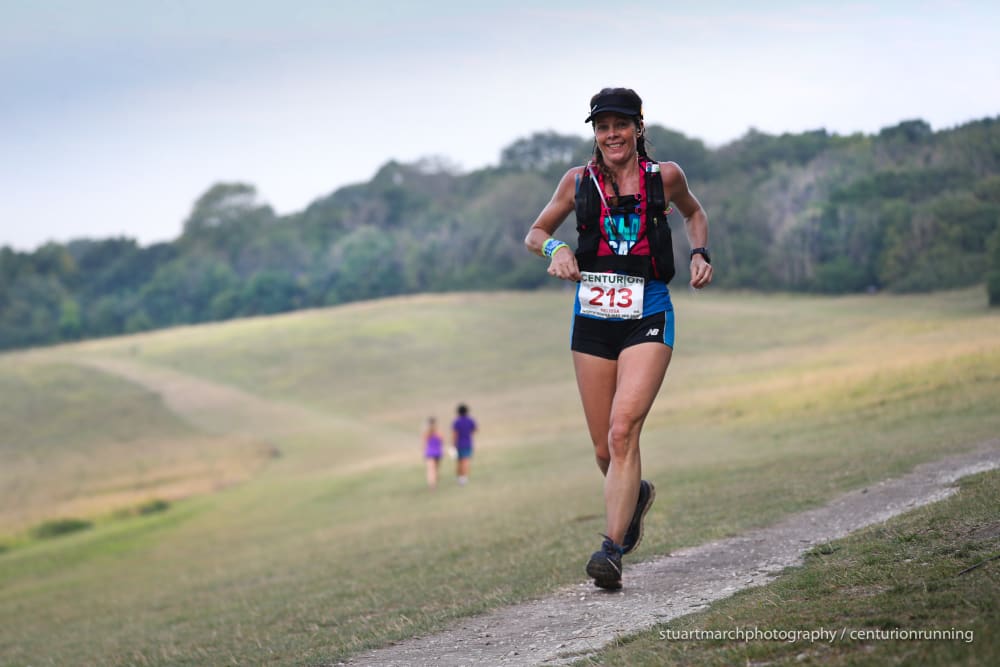
Mel Venables
Line Caliskaner: Ran a massive 243km over 24 hours in Barcelona in March of this year, for the win. A performance which puts her amongst elite company indeed. Her 100 mile PB is 16:00 flat which she set as a split on route to a 220km run at Bislett 24hr last year. She has experience on the trail too and could be capable of something special here.
Sharon Walker: Second at Race to the King in 2019 and third at Race to the Tower in 2022. This year she kicked off her ultra season with a seventh place at our inaugural Hundred Hills 50km.
Renee Haver: Renee was fourth here in 2021, before going on to a sixth place at the Autumn 100 later that year albeit in a faster time.
Emily Newton: Emily looks to be only three years into her ultra career but is off to a prolific start with 20 races in that time. In 2023 she has already run seven, recording six podiums and two wins. Amongst those a second at the Manchester to Liverpool 50 and her first 100 mile finish at the Arc of Attrition where she placed ninth.
Becky Atkinson: 2:55 Marathon PB and a regular sub 90 minute half.
MEN
Paul Maskell: Paul has been one of our most consitent Team GB 24 hour runners in recent years and his improvement is still coming. 265km in Verona in October with a 14:20 100 mile split was a PB for him. He has previously won many other classic ultras on trail too, however. Autumn 100, South Downs Way 100, GUCR, South West Traverse and the Arc of Attrition 100 amongst others.
Pete Windross: 2018 TP100 Champion, Pete has arguably been the most consistent 100 mile runner at our events over recent years. He has no less than 20 x 100 mile finishes to his name including six NDW100s, five SDW100s, five TP100s and four A100s. His PB came at the A100 in 2021 where he ran home in 13:59. In 2022 after setting some GB age group records at our Track 100, he finished second at the SDW100 and NDW100, before dropping with just the final leg to go in the A100. He is back for more!
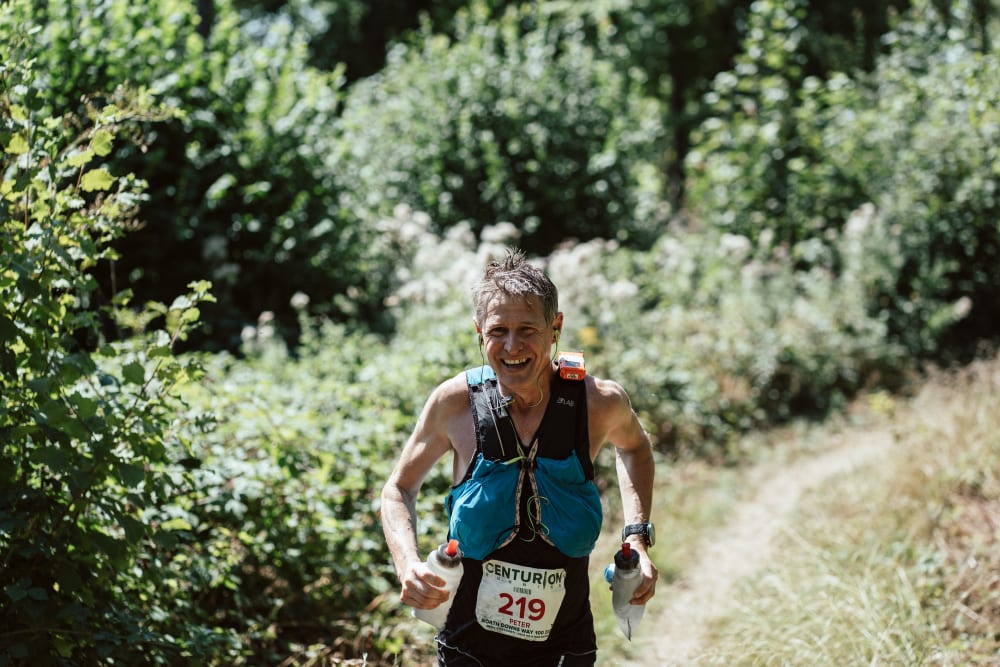
Pete Windross
Harry Geddes: Harry was Pete's nemesis at A100 last October where he came past him on leg three to win the race in 14:52. He was also fourth here in 2020 so knows the course.
Geoff Cheshire: Geoff was third here in 2020 in 15:22. That followed a second place at the Autumn 100 a year before where he ran 14:31. Prior to that he had already picked up wins at the Chiltern Wonderland 50 and Race to the Stones. In 2021 he ran home second at the North Downs Way 100 in a superb time of 17:07.
Brandon Talisesky: Brandon hails from the US, and has a number of race wins to his name from recent years, including at this distance, running 16:44 to take the crown at the Great New York Running Expo 100 mile. This year he has opened his account with a win at the Mid-Maryland 50km.
Matt Gallagher: Seventh here in 2021 in 16:21. In 2022 he finished fourth at the NDW100 before running 16:34 for seventh at the A100.
Kallum Pritchard: Winner of the Robin Hood 100 in 2021 in 15:31.
Peter Abraham: Peter won the Self Transcendence 24hr at Tooting Bec with a total of 231km in 2021, where his 100 mile split was 14:37. He was also third at the Autumn 100 in 2017.
Barry Bryant: After 8 wins in 8 finishes in his ultra career, Barry went off super quick at the 2022 Autumn 100. Whilst things did not go his way, to his credit he muscled out a finish in 17:36 for tenth place.
Alistair Fitch: The 2:38 marathoner (London 2021) was second at Race to the Tower in 2022.
20 Apr 23 by James Elson
Track 100 2023 Preview
This year marks the fourth edition of our Track 100 - the UK's only IAU Gold Label event. This race is really the only one of its kind, certainly in the UK and arguably globally. It attracts a very small, elite group of athletes looking specifically to set records - principally at the 100 mile distance but at other splits along the way including 50km, 6 hour, 50 mile, 100km and 12 hour.
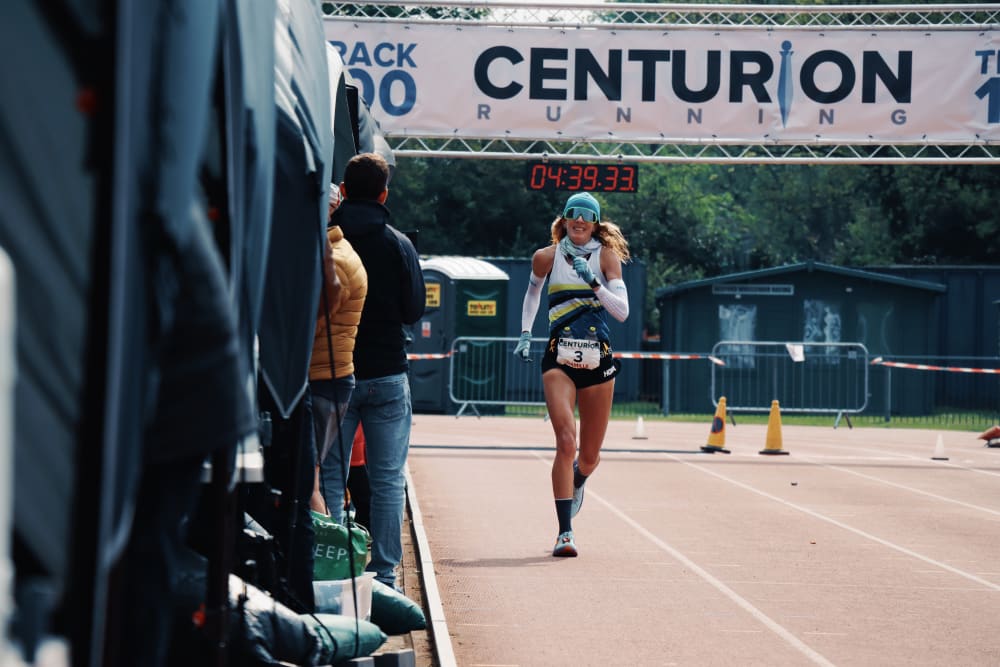
Camille Herron at the Track 100 in 2022 (Photo: David Miller)
In 2019, our first year, we weren't sure if the high standards and story behind the event would attract any interest at all, but eight athletes gave it their all. The mens race was won by Thomas Payn in 12:25 putting him 8th on the British all-time list. The womens race had only one finisher, Debbie Martin-Consani who pioneered the way for everyone to follow.
From there we decided to branch out. With several of our Centurion Ultra Team active members of the ultra set up with Team GB, we had the ability to reach out to other athletes in the 100km and 24hr disciplines to see if they wanted a shot at setting some National but possibly also Continental and even World marks.
We of course, lost 2020 to covid but got our second event away in April 2021, with a lot of covid restrictions still in place. And the event morphed into something much bigger. All of a sudden runners were shooting for open and age group records at various levels and in total, 14 new marks were set. Aleksandr Sorokin's laid down a new 100 mile mens world record of 11:14, before he decided to push on and set a new 12 hour record as well, running 170.309km in that time. And of course Sam Amend set a new British womens 100 mile record of 14:34.
In 2022, the ante was upped once again. This time we welcomed Aleksandr back to try to take on the world best 100km mark, having more recently taken the 24 hour world record too. And in the womens race, Camille Herron and Dominika Stelmach took each other on to try to shoot for several world marks, with Sam Amend back to try to improve her own British record. In the end, Aleks blew everyone away once again, running 4:53 for 50 miles he went on to break the 6 hour world record and then the 100km mens world record - coming home in 6:05.
For Camille and Dominika, it was a tough day, but Dominika was able to set a World FV40 50 mile record of 5:51 and a World Age Group 6 hour record too. Sam Amend did improve her British mark and won the 100 mile race in 14:10. The mens race was won by Alex Whearity but in a superb 12:42, but second was Mike Stocks who broke the World MV50 100 mile record in 13:41. We also saw a first as Claudia Burrough raced her wheelchair and set new World bests at every one of the six marks along the way.
So in 2023 with some late withdrawals, we welcome an elite field of six men and three women, once again all with different ambitions.
In 2021 and 2022 the focus from a number of athletes was on the lower distances and marks but this time almost all of the athletes are shooting for the big one, the 100 mile.
WOMEN
Ingrid Lid: Ingrid has a 100 mile PB of 15:10 set at Bislett in 2021. She finished second at last years TP100, a result she also achieved in 2019. Her target here will be the Norwegian record of 14:25 held by Therese Falk.
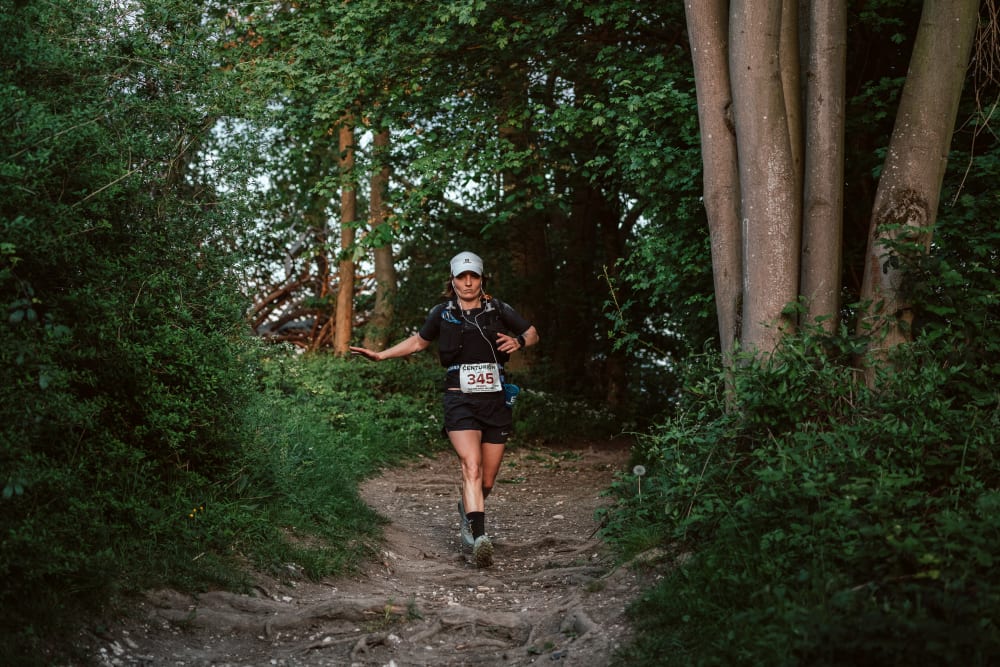
Ingrid Lid at the 2022 TP100 where she placed second
Chavet Hills: Chavet hails from Denver, Colorado and has been a prolific racer over recent years. Stand out results have been wins at the Prairie Spirit 100 (twice) and Pony Express Trail 100 where she came home in 17:31. Her 100 mile PB is 16:46 from Daytona 100. She has raced numerous 24hr races and had great results at that format including a win at FANS 24hr, but also plenty of shorter ultras too.
Sarah Sawyer: Sarah has taken on a wide range of ultras in her 10 year career, shooting at a range of different distances and racing in a variety of different environments and terrain types. On the road and track, her standout performances have come at Spartathlon where she was fourth in 2019 and her best 24hr in Germany in 2020 where she ran 208km. In 2021 she raced here and made good progress until the final few hours where her pace dipped just too much for her to make the final 17 hour cut off and she heartbreakingly had to stop within 5km of the finish. She finished 2022 by running a solid 17:40 at Daytona 100.
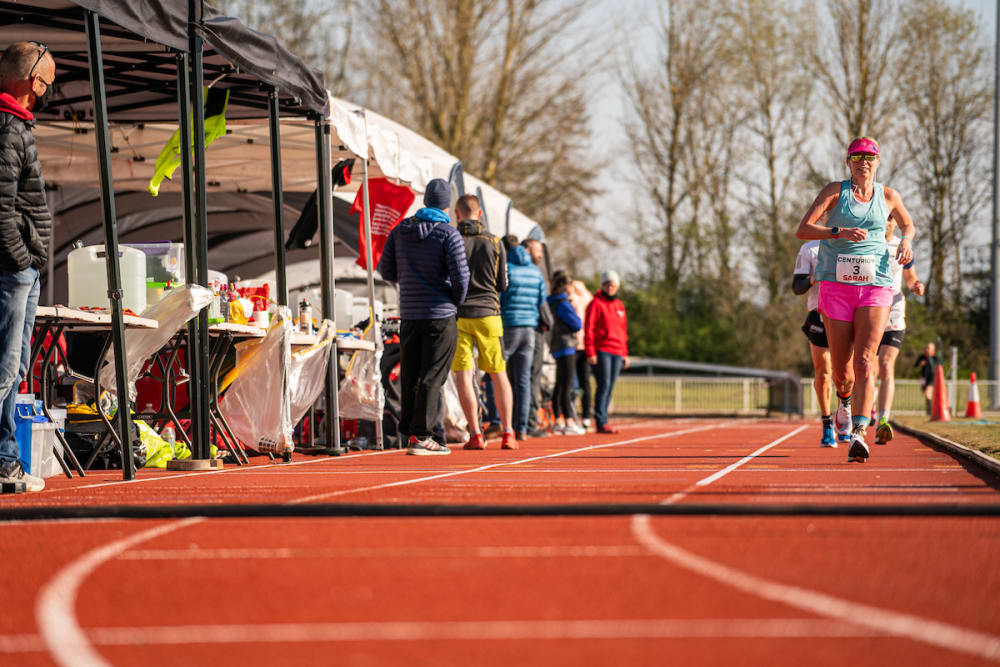
Sarah Sawyer
MEN
Dan Lawson: Perhaps the most consistent high level performer on the UK scene since the golden days of Don Ritchie, Dan really has done it all and at 50, is still getting quicker. In years gone by Dan has excelled at the long stuff and in formats most similar to this event, he was European 24hr Champion in Albi in 2016. But just last year he exceded his winning distance there by a whopping 12km, running 273km in Verona for fifth place in the same competition. His list of race wins and accolades are too long to mention really. Stand out wins and podiums some as course records on the road/ flat trail at Ultrabalaton, Spartathlon, Badwater, GUCR. He is no stranger to multi day either with his LEJOG record one of his most impressive runs of all. In the past year has has also brought his 10km, half and full marathon times down. A Vet 50 World Record will be the minimum aim and in reality he is capable still, of going for much more besides.
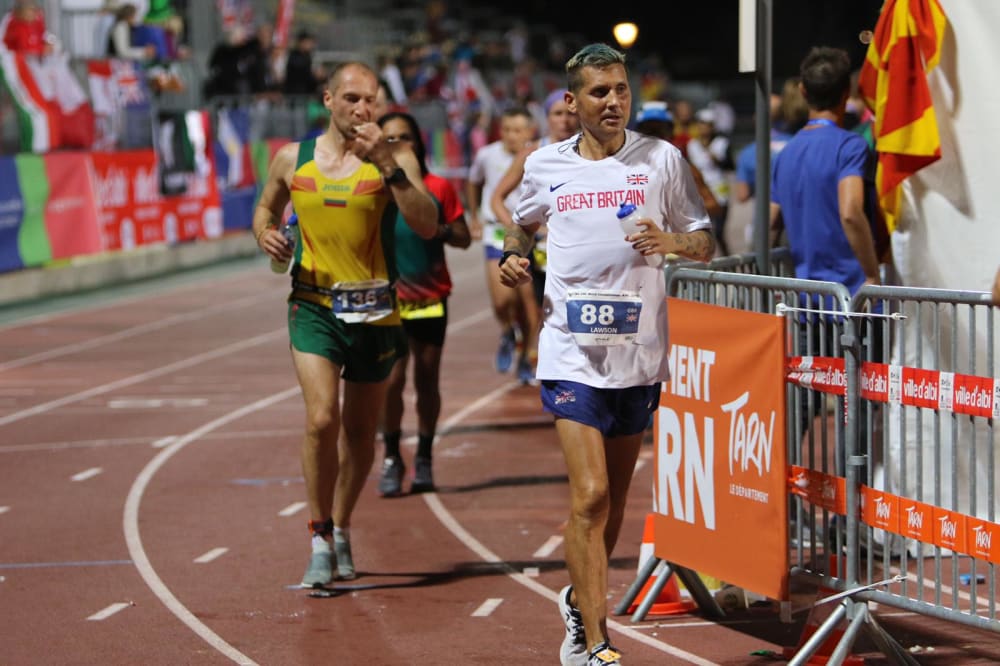
Dan Lawson
Robert Hajnal: Robert comes into the event as the only runner with a declared focus on the 100km distance, with his sights set on the Romanian National Record. He is a storied ultrarunner with incredible success dating back for a decade or more. 9th at UTMB in 2022 followed 7th at Laveredo and a win at 100 miles of Istria. He has countless wins behind him and top ten showings at many of the worlds most competitive long trail ultras. On the road and track, he has a 50km PB of 3:08 and in March he covered 87km in 6 hours in Barcelona as part of his preparation. The Romanian record and time to beat is 6:41:07, from Iulian Filipov back in 2021.
Mark Innocenti: Mark ran 12:34 at the 2021 event in what was a supremely well executed run, that on any other day would have received all of the plaudits, had he not been beaten by a world record run by Aleksandr Sorokin. The Tring runner has steadily brought his marathon best down to 2:27 in London, 2022. This year he's already run 54:09 for 10 miles too. So the speed is all there, but he has accrued much ultra success now too. A 3:02 50km PB, plus wins at the Autumn 100 and Race to the King are stand outs, as was a 7:00 flat 100km performance at the British Champs in 2022.
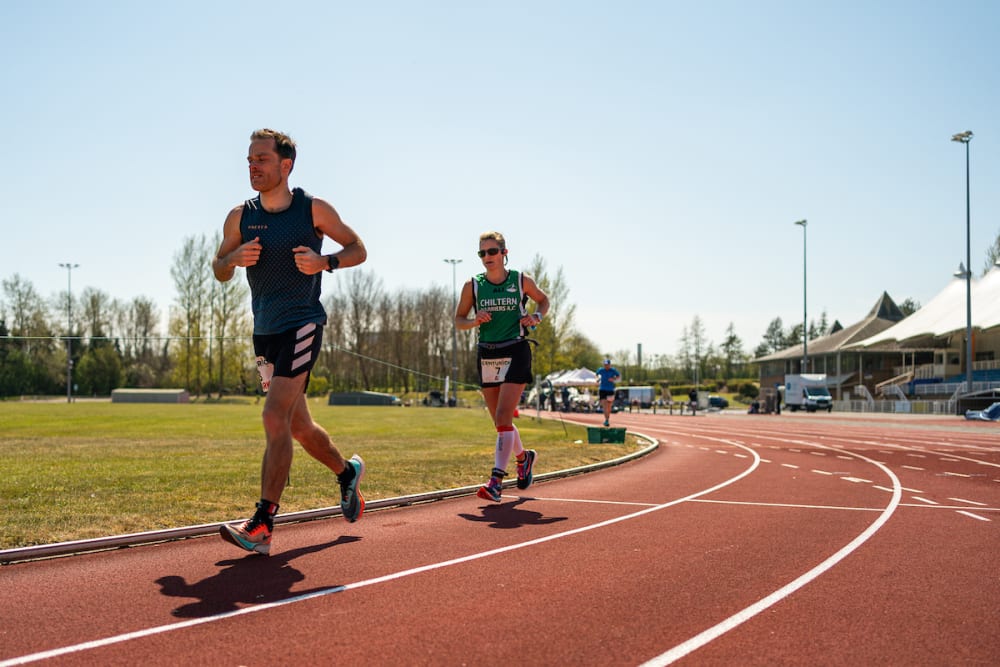
Mark Innocenti
Tristan Stephenson: Centurion Ultra Team runner Tristan, set the Thames Path 100 alight in 2022 when he ran home a clear winner in a second fastest all-time performance of 13:59. He has a second and third place at the Arc of Attrition 100 behind him. As well as wins at the South West Traverse and Serpent Trail 100km. His only other ultra distance track event ended early at Gloucester in 2021 but he is already off to a solid 2023 with a win at the EnduranceLife North Cornwall 50km and a big bank of training behind him.
Luka Videtic: Luka is truly a man of the road and track and has improved vastly over recent years. His 2022 season included a break through 265km performance at the IAU European 24hr Championships for 10th, where he recorded a 100 mile split of 13:39 along the way.
Ciaran Mcaneny: Relatively new to ultrarunning, Ciaran qualified for the event after running 80km in 6 hours on the track in 2022.
To follow the race live head over to our Live link here. Lap splits and a live feed will be available from race morning.
4 Apr 23 by James Elson
2023 SDW50 Preview
The 2023 South Downs Way 50 is the eleventh edition of our traditional season opener. This year it was preceeded of course, by the Hundred Hills 50km and it was great to see so many building up to the longer races there.
Last year the womens race yielded the fourth fastest time ever, by Bethan Male who went on to set a new SDW100 record two months later. The mens race was closely fought but won in a time over an hour slower than Tom Evans' course record of 5:44. As we have seen, anything can happen here on what is truly a runners course. If the weather stays dry throughout the week and with a forecast of bright sunshine on the day, the recent wetter ground will largely dry up, leaving conditions good for fast racing.
Here is a look at the likely contenders in the womens and mens events.
WOMEN
Rebecca Di-Luzio: Winner of the UTS 100km in 2022 and took 9th place at Transgrancanaria Advanced earlier that year. Previous winner of Endurancelife CTS Sussex, on and around the SDW50 course.
Dani Battersby: Third here last year in 8 hours flat and went on to finish fourth at the SDW100 a few months later.
Jen Wood: Ran 129.7km in 12 hours at Gloucester in 2021, putting her seventh on the British Female List.
Amy Sole: Second at the 2022 Arc 50 and past winner of the RAT 50km, with several other podiums to her name at the Classic Quarter and Hurtwood 50km.
Alex Coomber: Second here all the way back in 2015 it is fantastic to welcome the Olympic Skeleton Bronze Medalist back to the race. Her most recent ultra result looks to be a second at the Serpent Trail 100km in 2021.
Rachel Dench: Rachel's third run here, but her first since 2017 when she finished fifth. She has lots of experience behind her, with several wins at events around this length. And she looks to be in good form off of a 2022 season where she won both the North Downs Ridge and Epping Forest 50km events.
Laura McGill: Finished third at the Chiltern Wonderland 50 in 2021.
Meriel Holden: 3:01 marathon PB, ran a 3:08 in London in 2021 and has a couple of more recent shorter ultras to her name.
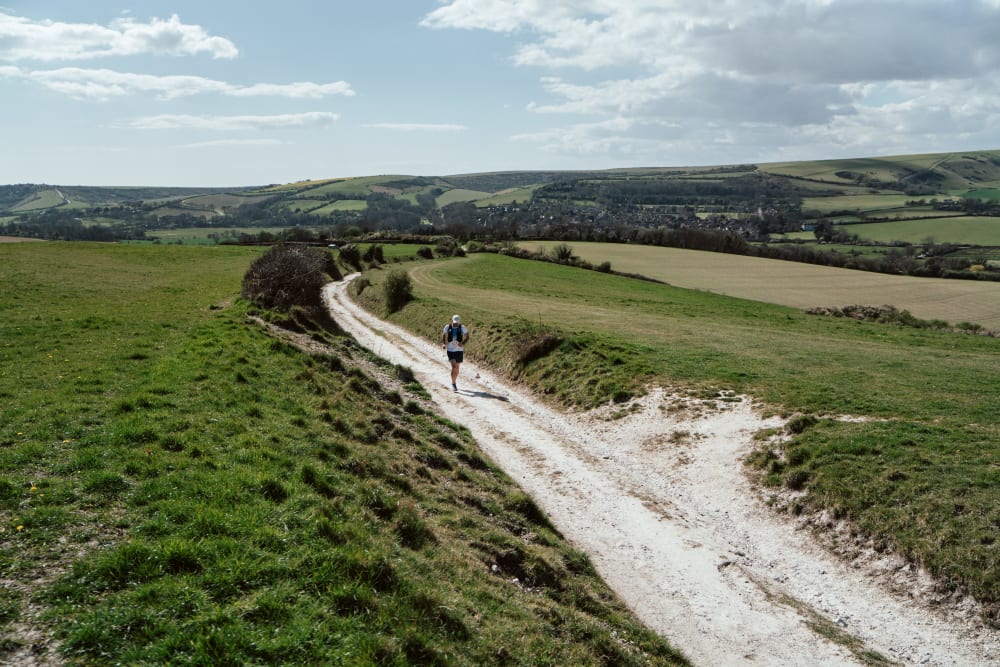
MEN
Paddy Hamilton: Won the Pilgrims Challenge on the North Downs Way earlier this year. Race to the Stones winner in 2021. 2:23 marathoner though that was from Dublin in 2013.
Lewis Ryan: Lewis is a man with genuine pace, but also a good range. He has won races from 50km up to 100 miles, his most recent coming at the North Downs Ridge 50km a month or so ago where he ran home in 3:30. Marathon PB of 2:35.
Ben Goddard: Fourth at the NDW50 last year, the previous two time winner of the Fox Ultra looks to be the second fastest marathoner in the field with a PB of 2:26. Ran 2:34 at Rome just a few weeks ago.
Liam Mcintyre: A 2:29 marathoner (Manchester, 2022), his only ultra looks to be a win at Race to the Stones 100k, in 2018.
Gatsby Fitzgerald: Third at Manchester to Liverpool 50 last year in 6:33.
Marius Posa: Best performance of second at Country to Capital (44 miles) in 5:28. Has recently run a 2:39 marathon (Valencia) and a 75 minute half.
A huge thank you to the volunteers who will make this event possible, numbering almost 100 over race weekend. And to the South Downs National Park and all of our landlords for allowing us to come back each year.
Follow the race live over Saturday via the link here (this will switch over to SDW50 later this week).
15 Mar 23 by James Elson
2023 Hundred Hills 50km Preview
This Saturday we welcome 375 runners to the inaugural Hundred Hills 50km. Named after the area the race takes place in, one of the three Chiltern Hundreds, the course makes it way through some quintessientially beautiful and remote English Countryside. Starting and finishing in the spectacular Stonor Park, the first of two loops takes runners through Ibstone and Skirmett before dropping them back to Stonor at half way. Then on and out to Hambleden and Bix before coming back to Stonor to finish the 50 kilomotres of classic trail running.
Live Tracking is available via the website here. But as always we like to have a look at the likely contenders in the overall races so read on for more.
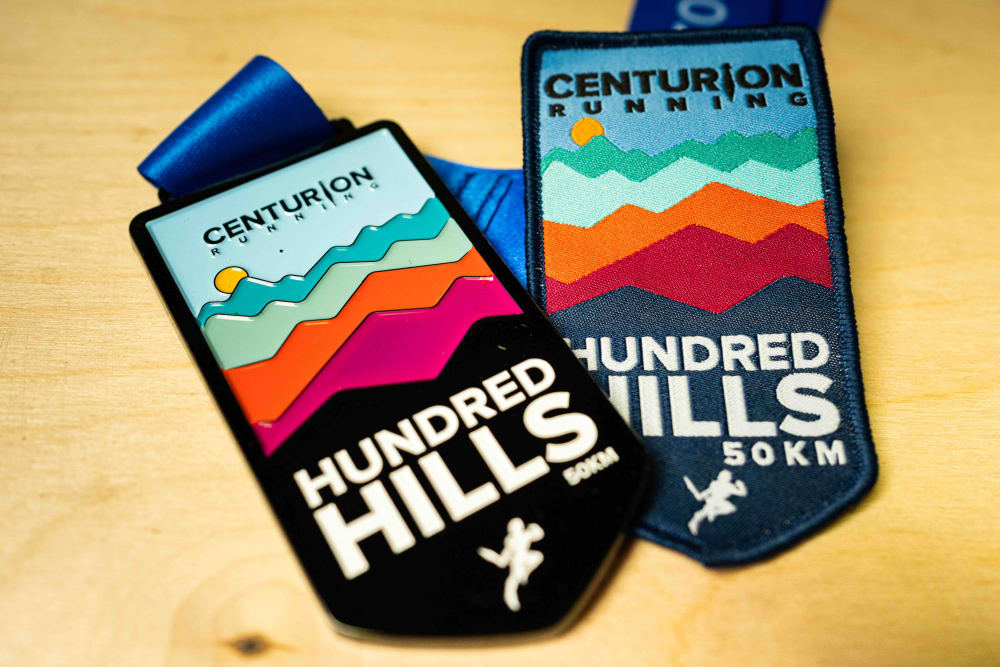
WOMEN
Amy Jo-Clarke: Last years NDW50 champion. Previous wins include Race to the Stones and Hurtwood 50km, both in 2021.
Sophie Biggs: 2022 Chiltern Wonderland 50 champion, she also placed third behind Amy-Jo at the 2022 NDW50. In 2023 she already has a second place at the CTS South Devon Ultra back in Feb.
Tamsin Neale: A collection of fine results in 2022 including top ten finishes at the Autumn 100, Chiltern Wonderland 50 and Race to the Stones.
Celia Waring: Second at UTS50km in 2021, third at the North Downs Way Ridge 50km in 2022.
Dawn Goodwin: Eleventh at NDW50 in 2022 and fourth at Serpent Trail 50km. Faster road runner with a 3:07 marathon in 2022.
Teresa Reason: Fifth at Wendover Woods 50 in 2021. In 2022 went on to second at Chiltern Ridge 50km, third at Serpent Trail 100km and fifth at Hurtwood 50km.
Sharon Walker: Second and third at Race to the King and Race to the Tower in recent years.
Gemma Buley: Sixth at our CW50 and ninth at the SDW50 both in 2022.
Paula Williams: 2021 Grand Slam 50 mile finisher, collecting fifth at the SDW50 and sixth at CW50 as the pick of her results that year.
MEN
Dan Weller: Dan recently ran home third at the Arc of Attrition 100 back in January. Previous winner of the Beacons 50, Grand Tour of Skiddaw and the Lakes Traverse. He was second at our 2022 NDW50 in 7 hours flat.
Craig Holgate: Our Ultra Team runner is making a come back after some time away from the sport. Craigs accolades run deeper than any in the field including running for GB Teams in the trail, 100km and 24hr formats. Amongst many other victories he has previously walked away winner and course record holder of the NDW50 and TP100 both twice and has a PB for 100km of 6:53.
Julien Cazorla: Prolific runner with some superb performances behind him. Pick of those a 15:02 for third at the 2021 Autumn 100. 15:56 for second at the 2022 TP100. Has also finished second at the CW50 and fourth at the NDW50 in the past.
Neil Martin: Past winner of the Wendover Woods Night 50km, he enjoyed a stellar year back in 2019 when he finished in the top ten at all of our 50 mile events and won the Arc 50 to boot.
Alistair Palmer: A history of around a dozen or more ultra finishes. Stand out results a second at the 2018 South Downs Way 50, and a fifth at the SDW100 a few months later in a sub 17 hour time. In 2021 he won several shorter lower key ultras.
Samuel Anderson: Fourth at CW50 in 2022, fourth at WW50 in 2021 and seventh at the 2022 NDW50.
Dan Silvester: 17:05 for eighth at the 2022 TP100 and recently seventh at the North Downs Ridge 50km.
Liam Butler: 2:39 marathon in 2019 and lots of cross country experience could be a good combination.
Tom Hedges: Fourth at our 2021 Wendover Woods Night 50km.
6 Feb 23 by James Elson
Kit & Advice for the Spine Races
This post is specifically designed to look at the detail of all aspects of the kit, footwear, apparel, nutrition and miscellaneous items that you need to think about in order to compete safely and successfully in the Spine Races or indeed, for winter in the mountains.
- Click here to visit the store collection on our website, containing the majority of these products.
- Click here to watch a longform video going into all of the kit for the Spine Race with James Elson (YouTube)
- Click here to read James' race report from 2023.
- Click here to listen to James' recap podcast of the 2023 event.
- Click here to listen to a British Ultrarunning Podcast conversation between James, Dan, five time finisher Matt Neale and 2023 Mens Race Winner Damian Hall.
- Click here to listen to the Tea and Trails podcast with Eddie Sutton on her 2023 Spine Race. Eddie is a Centurion Coach and third place finisher in 2023.
This video accompanies this post, going into further detail on all of the items below as well as the drop bag and how to think about packing for the race.
Clearly a huge caveat needs to be placed at this juncture. Every single person emerging from the Spine will have a different view on kit, how in functions, what minimum requirements are vs what you actually need to carry.
You need to think very carefully about what you need to carry/ have access to and not just what's on the mandatory kit list. The kit list is there as a safety net and often just in case of emergency. What you actually require to stay safe and perform well at the Spine Race goes far beyond it.
We also need to be realistic about cost and what you do and don't need to buy. Some of the kit is very expensive plus there is of course a large energy cost to production and transport in a lot of cases. So consider what you have already that is fit for purpose, what can be borrowed and what can be hired. As time goes on and we are able to put the time and resource into it, hiring kit is something we'd like to get into - many already do this. The facebook group here is a valuable resource in borrowing kit or getting advice on how to look after it.
Cheaper alternatives are available for everything, always look at the compromise though: Weight vs Packability vs Price. We've picked out the best balance of those three things, in our opinion.
And on that note - as a retailer of ultrarunning gear, all that happened as we went sourcing the best kit, was that we started to stock it. So that we could pass on a collection of kit that was all in one place for runners interested in the race - with first hand, real world advice. We don't stock it all but we're getting there. All of the links take you to the best place to find each product. It might seem salesy but believe me when I say I think the biggest saving is actually hopefully on people's time trying to find good advice and being able to ask questions about kit/ shop from us at the same time. We're here for the detail.
However, we are not the authority on Spine Race kit. If you have any questions or want to check if what you have meets kit requirements for the race, then you should contact the Spine Race and Lindley Chambers who heads up their kit side of things, via his email [email protected] . You can also read his advice and tips on kit and kit check on this page here.
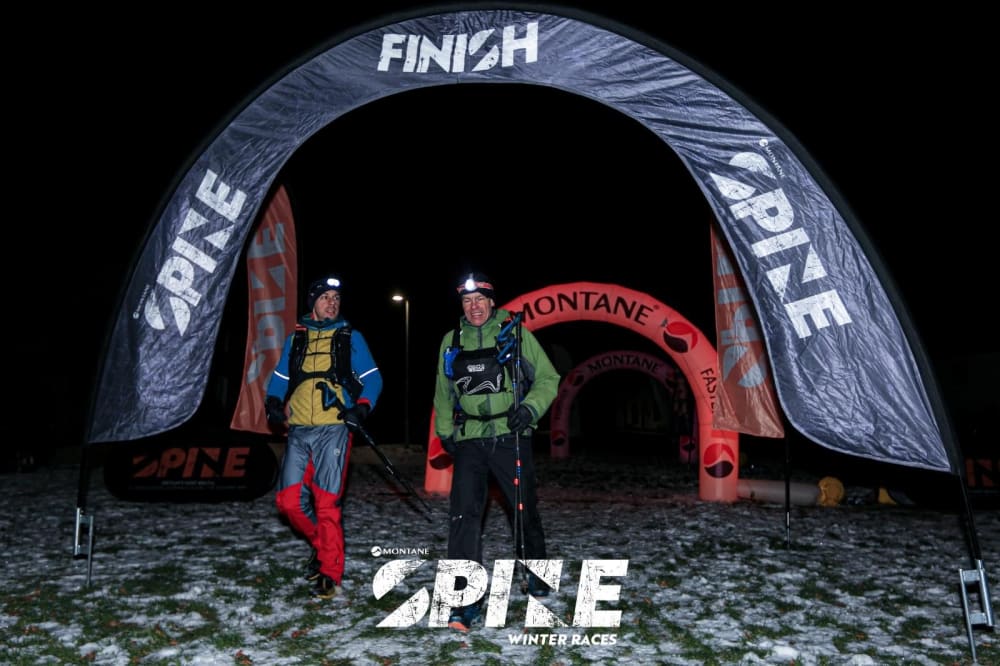
What I've done here is distilled down my experience not just at the Spine but of a nearly two decades of racing in all conditions, utilising a wide range of winter kit over and over again - as well as organising more 100(+) mile ultra distance events than anyone else in the country! I know there will be some people who have no idea of who I am so I have included a short bio at the end of this post.
This kit has been used, not actually mainly in racing but in training and on days out on the hill, in winter. You must get used to using the kit, particularly working out what footwear and what layering systems work for you. I am around 65kg, 5ft7 and without tooting my own horn, tend to move towards the mid to the front of the pack in events. I would say days out over the Wainwrights in winter were a turning point for me. Learning to read the forecast, particularly with regards to wind speeds at height, anticipate clothing requirements, navigate in the dark and mist with map and compass and scramble/ climb very difficult ground - these are the skills that make me feel most comfortable in terrible weather. A lot of my racing might also seem irrelevant but you draw on the experience of everything that has gone before, in events like the Spine. Races/ Rounds I've run that help contribute to choices here include Tor Des Geants, Arc of Attrition, Lakeland 100, Western States, Bob Graham, Paddy Buckley, Charlie Ramsay, Leadville, Lakeland, 4Deserts Series (antarctica being the most cold weather specific). But more so things like the Wainwrights in winter, crossing Iceland on foot and many long days out by myself.
Finally you will find kit suggestions and comments throughout this text which features my own kit. Firstly from two of our team runners - Debbie Martin-Consani who has finished the race twice including a win at the 2022 edition. And Edwina Sutton who finished third in the 2023 race. Finally, from 2023 Mens winner Damian Hall.
All of the below kit meets the criteria for the event.
Footwear:
Clearly, managing your feet is one of the handful of major things to concentrate your energy on. For some time as a team we had been waiting on the La Sportiva Cyklon Cross GTX to come out. We'd sat in a team meeting back in April and Jono Wyatt had pulled a pair out and previous race winner and PW Record Holder - John Kelly - sitting to my right, had asked on the spot if he could possibly just take them home with him. They are effectively an insulated, waterproof, lightweight shoe - that looks like a boot due to the gaiter. The sole unit is La Spo's grippiest rubber. The upper is soft, warm and you can dial it in tight or back it off using the boa system. Then there is a Gore Tex gaiter coming up to ankle height, so effectively there are two waterproof layers to the shoe. This kind of shoe has moved the game on with regards to protection from winter/ very wet or cold conditions. It feels like you are wearing a lightweight shoe, whilst getting the protection of a mountain boot (not crampon compatible as the sole is not rigid enough - great with microspikes of course). Others were still wearing regular trail shoes and asking more of their socks but for me whether you are running up the front or scraping cut offs, this shoe does it all. The other model I had in my armoury was the La Sportiva Blizzard. This is again a Gore-Tex shoe with a debris gaiter, and has a metal stud matrix built into the sole unit - essentially built in nano-spikes so you can run across ice without issue (note these will not pass kit check, you still need a separate set of spikes or yaktrax).
The other component of course, is socks. I hadn't worn waterproof socks since the Last Desert Antarctica in 2008. But I got hold of some Dexshell Compression Longlite socks and quite frankly they became the most important piece of kit I had. They are impermeable to both water, but also to debris. And at knee height you have to be in a very significant bog or river to get water in the top. If that does happen, they then insulate that water like a wetsuit, and keep your feet warm.
I had no liner sock, just the Dexshell. I started in the Cyklon Cross. Because it was minus 2-3 in the valleys and 6-7 on the tops all week, every hard surface was covered in ice so I then used the Blizzards for Day 2 and 3. Before going back to the Cyklon Cross for the last two sections.
All four of the runners mentioned on this post including myself, Debbie, Eddie and Damian all used the same DexShell sock for this race.
2022 Womens race champion Debbie Martin-Consani used a liner sock in combination with the DexShell and had just as much success with her feet - Debbie talked about her foot route in a post-race intstagram post here. Liner socks should be thin, it is well worth experimenting with both options in your training. Damian Hall comments: 'I too use DexShells and tend to wear a toesock as a liner. The only problem I've had is from feet being too warm in conditions less severe'. Again, test them in training.
With the Dexshell Sock, and then the Cyklon Cross/ Blizzard I had zero blisters (i had one small bit of skin come off at the finish because i tore off a bit of preventative tape too soon with wet skin underneath), zero hot spots, never once got cold feet and always had the grip I needed. I took my shoes and socks off in at the 144 mile check point and the medic asked me where I'd washed my feet - they stayed that clean and clear. The Blizzards - after 40 or so hours began to make my feet tender, I think where the sole is more rigid and the spikes less forgivining but they were priceless for the icy rocks, hence the switch back to the Cyklon Cross. I take half a size up in both to allow space for the thicker Dexshell Sock.
So as an N of 1 sure, but if you want to get through the Spine without foot issues, there's a good system to try. This is more of an invidivual area than almost any other part of your race strategy, besides nutrition.
Separate Spikes or Yaktrax are part of mandatory kit. Nanospikes won't pass kit check. I would always carry a Yaktrax for speed and weight, but also have my Kahtoola Microspikes in the drop bag. These are essentials for any winter mountain day anyway, will see plenty of use! I've had my Yaktrax since 2008, still going strong.
La Sportiva Cyklon Cross
La Sportiva Blizzard
Dexshell Mudder Compression Socks
Kahtoola Microspike
Yaktrax
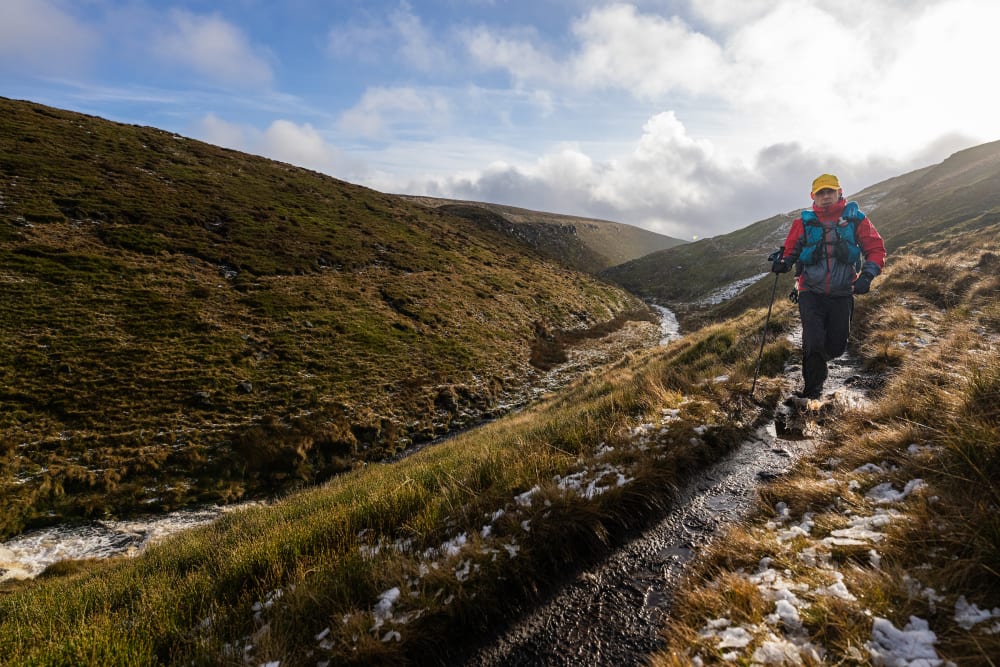
Freezing waterlogged paths - but no water ingress or foot problems.
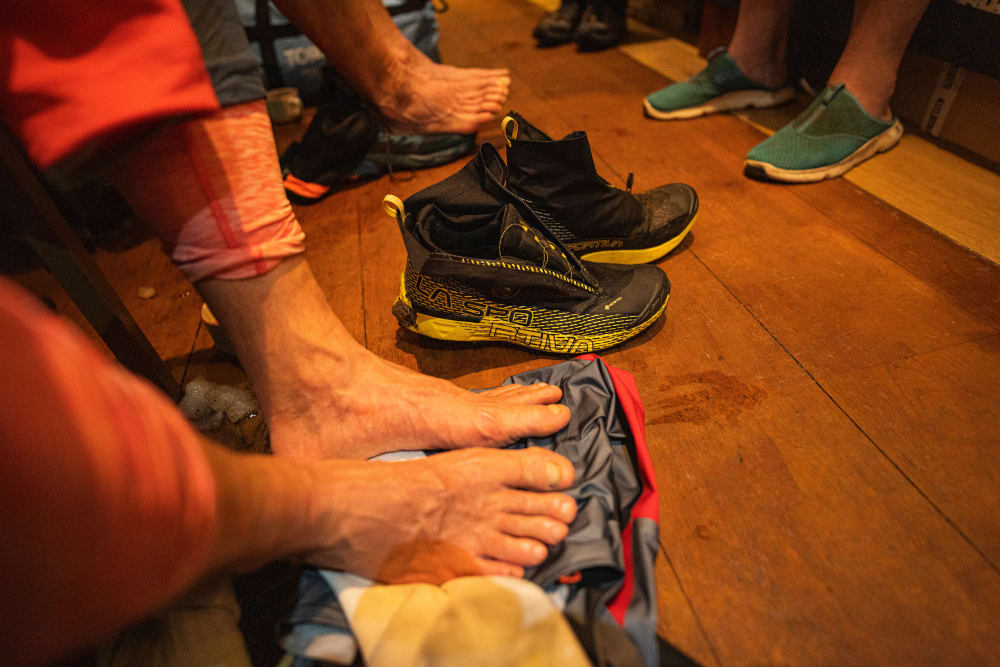
Kirk Yetholm: Completely blister free, dry feet. (Photo c/o Steve Ashworth)
Lower Body:
All through training including in sub zero temperatures for many hours, I'd worn one pair of tights and lightweight waterproof trousers. But in the race this was simply not enough. I ended up putting on a second pair of tights and then a waterproof trouser. I needed two pairs of tights to stay warm enough at the coldest times. Remembering then that these stayed largely dry through the race, I didn't touch my spare/ third pair but you need to carry one additional pair to that which you are wearing. I can't see getting away with less than three pairs of tights is viable, and a fourth would be wise.
As for the trousers, the Drizzle Pant (unisex) is a light, tapered running waterproof trouser, you feel like you can move fast in them. This was good for almost everything, you could put on a heavier Gore-Tex weight trouser in wetter weather however, that could be a very valuable addition - the Montane Spirit Lite is a Gore Tex Paclite Plus offering 28k HH (extremely water resistant) and a more durable.
On the lower half, Damian Hall, moving on the whole much faster (than almost anyone else!) found that one pair of tights was often enough, with a pair of lightweight waterproof trousers over the top just for the very worst sections. But certainly for us slower movers a bit more protection is worth getting used to in training.
Montane Tight / (Womens Edition) - 3 Pairs
La Sportiva Drizzle Pant (unisex)
Montane Spirit Lite Gore-Tex Waterproof Trouser/ Spirit Lite Womens
Upper Body:
This is a huge area, clearly. A good mountain layering system and an understanding of that is worth looking at. I know some runners will simply stick a Buffalo Jacket on and that'll cover almost anything they need. But I prefer the layering because it allows flexibility around conditions.
You should look at having a base layer. Two mid-layers - ideally a breathable fleece type material and a heavier weight fleece jacket, a primaloft jacket and two outer shells - a windproof and a waterproof.
For the majority of the Spine I had on six layers. Base Layer - La Sportiva Jubilee. Mid-weight fleece - the OMM Core Jacket which is super light, breathable and packs suprisingly small. A La Sportiva zip up fleece hoodie / Montane Protium Hooded Fleece. My La Sportiva Primaloft jacket. My Blizzard Windproof. A Montane Gore-Tex Active outer shell which I had on in the wet/ snow showers only. In training, I never had more than three layers on. But thermo-regulation goes out of the window several days in and you need to anticipate wearing far more than you ever will in preparation.
You then also need to have back ups for these layers. They will get wet at some stage. Having spares in your pack and your drop bag, is essential. Here's how and why.
Before a base layer for us men, Eddie Sutton adds 'this sports bra is thick (think free extra warmth) but has no seams and a large surface area to protect back. I had no chafing under arms or on back and it never felt wet so I didn’t get cold.'
A good base layer needs to be able to move moisture away from your body whilst insulating to a high degree here. The truth is at the Spine you are only really sweating up on climbs and even then if you are, you need to look at your effort level. I had several, one on me, one in the bag (that is the mandatory kit rule - one spare base layer not in use) and then a couple in the drop bag.
A good quality Waterproof Jacket is obviously crucial. Whilst a 10k/10k lightweight jacket will pass kit check, it's absolutely inappropriate to start this race with something that lightweight. The minimum level I'd suggest for the race is Gore-Tex Active. Right now we have the privielege of being able to wear a Gore level jacket which weighs close to nothing. The jacket I had for the majority of the race was the Montane Phase Nano. This is the evolution of the Spine Jacket. They are both Gore-Tex Active which translates to much greater protection than any of the other lightweight (10k - 20k range) jackets, durable, adjustable hood and hem and extremely lightweight. The womens edition of the Phase Nano is not out until September 2023. So the Spine jacket for both men and women and then the Phase Nano Mens from Spring and Womens from Autumn 2023 are the pick of the bunch for me.
Eddie Sutton comments 'I had run in a montane spine jacket for a few years size 10 one…then about a month before the race I purchased a size 12 one which I wore for the race and was so pleased I did. It enabled me to wear more layers underneath, I had more mobility and it was easier to get the hood up and down. I then took the size 10 in my drop bag ready to double layer if I needed to but we had a dry year!'
Some will point to needing heavier jackets than this - Gore-Tex Pro, higher denier grade material will stand up longer to bad weather, but that is personal preference - again weight vs packability vs protection - I believe Gore-Tex Active in these latest Montane jackets is the way forward.
You could certainly argue the case for needing one or two spare jackets too - if you are soaked through and keen to leave a check point in a hurry.
I would put a good windproof up there as just as important as a waterproof. There were times during the race where the wind was up to 40mph and on a -6 temperature reduced wind chill to -15. That cuts straight through a waterproof because of the nature of the material, where a windproof offers substantially more warmth/ protection. It still amazes me how a garment I use almost every day is so neglected in the running world. The Montane Featherlite options are nnot much over 100 grams and provide that layer of protection.
Finally the Primaloft or synthetic layer, go for primaloft/ synthetic and not down. Primaloft/ Synthetic still works as an insulating layer when it wets out but down does not. The Montane Fireball Lite is your outer insulating layer.
M&S Reversible Seamless Sports Bra
La Sportiva Jubilee Base Layer (La Sportiva Blaze - Womens Equivalent) x 4
OMM Core Jacket Mens / Womens
Montane Protium Mid-Layer Hooded Fleece Jacket Mens / Womens
Montane Fireball Lite Insulated Jacket Mens / Womens
Montane Phase Nano Mens / Montane Phase Nano Womens
La Sportiva Blizzard Unisex Windproof / Montane Featherlite Windproof Mens/ Montane Featherlite Windproof Womens (Blizzard discontinued)/ (La Sportiva Briza - Womens Equivalent)
Headwear:
The main way you will regulate your temperature during the race is by removing or adding hat/ headwear and hoods. Far simpler and quicker than removing layers. The Core Beanie from OMM is breathable, so you don't get a sweaty head. It weighs next to nothing and is made out of primaloft active.
Another good option is a headband which allows your head to release the heat whilst ensuring you don't get cold ears, which can be a real issue.
Hoods up or down in conjunction with how cold / windy it is - the hood on your windproof being the main one to use.
I also wore a Weather Resistant/ Waterproof Cap for the first day when it rained hardest, just to re-inforce the peaked hood on the waterproof jacket and ensure rain stayed off of my face.
In extreme weather, there will probably be some, then the Montane Balaclava is your go to.
Take plenty of buffs. We all have them. Good for face covering, extra warmth/ neck cover, head cover and of course wiping stuff up!
Montane Protium Balaclava
OMM Core Beanie x 2
OMM Kamleika Waterproof Cap
Centurion Versatile Head and Neck Wear
Gloves
Understanding combinations of gloves based on how cold and wet your hands might get is obviously as important as any other facet of your kit. If you lose operation of your fingers, you can't eat, undo bottle caps, undo zips/ change clothing. Basically somewhere between inconvenient and dangerous. Getting into this situation was the defining factor for me in bailing off of a second Barkley loop in 2019! I got my kit wrong when the weather turned very quickly and couldnt' navigate or do my jacket up.
A liner glove, with fingers is worthwile and worth having several pairs of. I'd start with one on and one in your bag (mandatory kit). Then a couple more spares in your drop bags.
As a warm overmitt, always go for Primaloft over Down, because when they get wet - the primaloft will still work as an insulating layer. The Montane Prism Dryline is their warm Prism Mitt, super soft, comfortable and light, but with a pertex waterproof layer. I had three pairs. One on. A spare in my pack. One in my drop bag.
Then a waterproof outer glove for really harsh conditions - the Minimus overmitt also from Montane. Just one pair of those.
Montane Trail Glove (liner glove) Mens/ Womens x 4
Montane Prism Dryline Mitt or Mens Glove / Womens Glove as per preference x 3
Montane Minimus Waterproof Mitt
Pack/ Belt:
During the race I used 2 different packs. I started out with an old S/Lab Peak 20 which was a skimo pack from 2017 - basically an old faithful. Before I got hold of a Montane Gecko 20. It was a case of using what I was used to. I switched to the Gecko 20 at Middleton when the back zip failed on the Salomon and that must have been fate. Because the comfort level of the Gecko is incredible. For me it is the superior option and I wished I had started in it. The best features in my opinion are the adjustable straps across the front which allow cinching around unknown layers of clothing, and the comfortable waist belt that takes some of the load off of your shoulders. But particularly the soft elastane blended material and side pockets. Unlike almost any other pack you can reach straight into them, just down of your waist but close to the front, and stuff them full of almost anything you might need on the run. Honestly they are like Mary Poppins' bag. The fit is exceptional, so comfortable and despite the weight you barely notice you have it on. For me, there was always ample space in the back - I packed light but then added a complete set of spare clothing on the top for easy access and there was ample room. I also used a Naked Band for additional space early in the race, particularly useful for excess nutrition.
Eddie sutton also used the same back and trained and raced exclusively with it. She comments 'it's a super comfortable pack, I didn’t feel the weight or pack rubbing (but I trained a lot with the pack too!) I brought an extra chest strap from montane and attached that high up which made a huge difference too.'
For further space, the OMM Chest Pod is compatible with almost any vest or pack, by adapating the fastenings that are provided with it - giving you front access to another 4 litres. I have never found I have needed this, but many in the race use this set up.
For greater capacity - if you are someone who plans to carry bulkier jackets, extra food, or less packable sleeping bags etc, then the best 30 litre option is the UD Fastpack 30, or FastpackHer 30. Again with the belt added for more space.
Montane Gecko VP20+
Naked Waist Band
OMM Chest Pod
Ultimate Direction Fastpack 30
Ultimate Direction FastpackHer 30
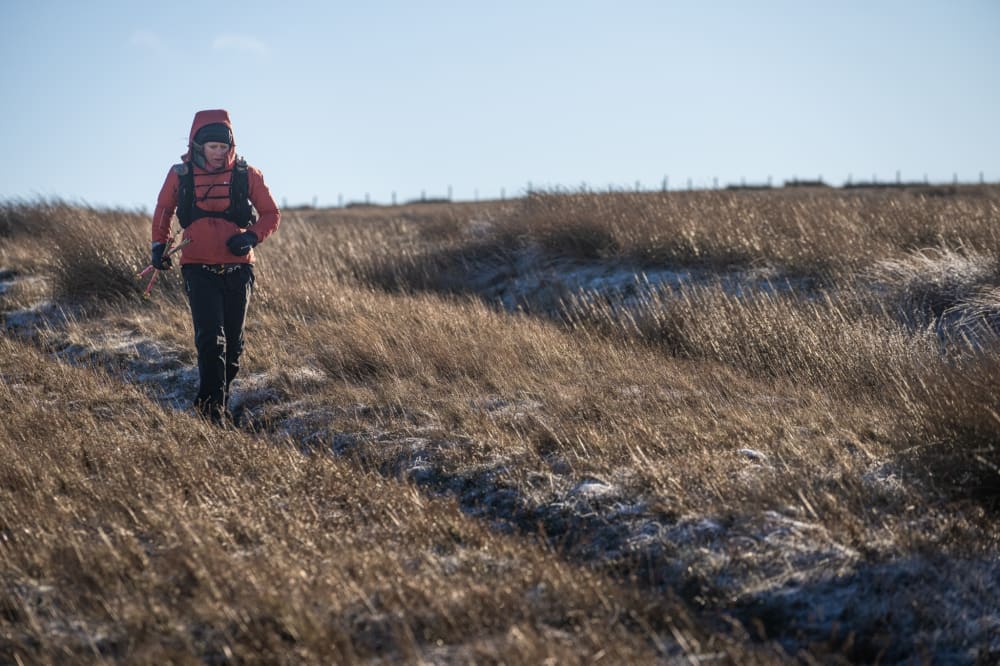
Centurion Coach Eddie Sutton rocking the Montane Gecko VP20+ en route to third place at the 2023 event (Photo: Steve Ashworth)
Lighting:
My go to lamp for the last 3-4 years now has been the Petzl Swift RL. Light, packable, easy to change rechargeable battery, long lasting and plenty of light and power. But. I found out during the first night that the lamp didn't like just how cold it was here. It's not been asked to do that duration in that cold before and because the battery was front mounted on my head, it was more exposed to that cold and seemed to drain quickly. That is anecdotal, lithium batteries should not drain any faster in that level of cold per se but that was my experience here. The batteries were all fully charged.
So I switched to my Petzl Nao RL which is Petzl's newest headlamp offering. On low reactive setting I got tons of light, more than I ever needed, and one fully charged battery lasted over 20 hours. I would only ever choose this lamp again. It's light, the battery is on the back which balances the weight out on your head, and crucially means it is protected from the bitter cold by your hood/ gets less cold.
A rear Red LED is mandatory. Rather than a cheap one which will likely break, I attach a Petzl E+Lite which has the added bonus of being usable as a back up emergency lamp with several other settings.
Petzl Nao RL x 2
Spare Nao RL R1 Batteries - x 4
Petzl E+Lite
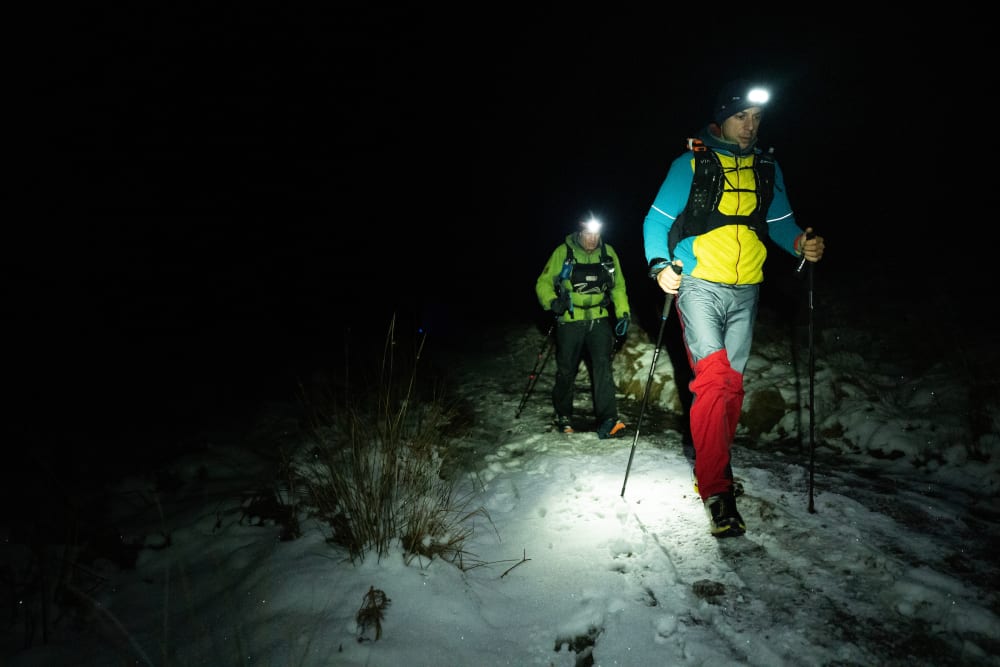
20 hours plus on low reactive setting with the Petzl Nao RL - always enough light to move well. (Photo: Steve Ashworth)
Sleep System:
Full disclosure here, I used this in training and on the freezing cold floor in Bellingham but I did not Bivi out during the race. The Thermarest Hyperion has a comfort rating of 0 degrees C. It is super lightweight, but immensely comfortable and feels substantial despite how small it packs down. It is the minimum rating to pass kit check, but honestly with the Mat, Bivi and Clothing you have, I can never see more than this bag, being required. You can of course find other marginally lighter, extremely expensive alternatives but with performance vs packability vs weight, this is the optimum bag for me.
The sleep pad - I opted for the lightest as once again, I wasn't planning on a bivi unless in emergency - but I am happy having bivi'd on it before that whilst not the most comfortable night, as an insulating layer it does everything you need eg. gets you off of the freezing cold ground which is conducting your body heat away very quickly indeed. The Neo-Air Uberlite*** THIS PRODUCT HAS NOW BEEN DISCONTINUED - IN CONSULTATION WITH SPINE HQ THE EXPED ULTRA R1 MUMMY MAT IS BOTH LIGHTER AND MEETS MANDATORY GEAR REQUIREMENTS***** inflates extremely quickly and is a pass at kit check. Again it feels substantial. To me, the mat is the least important thing. If you try to inflate a mat like this with little or no shelter in high wind in an emergency you may as well be holding onto a kite. You need to get the bivi out first and try to inflate the mat inside of it whilst pinned down and ideally behind shelter. You need to practice these things in training!
With the bivi, I have again gone super lightweight, almost as light as you can go. The less durable bags eg SOL will fail at kit check. This is a waterproof bag with taped seams and perfectly adequate to keep you protected for short sleeps or awaiting assistance. This isn't a bag I'd hang out in year round for comfort - but that isn't why I am carrying it during this event.
Thermarest Hyperion 32F/0C Sleeping Bag
Exped Ultra R1 Mummy Sleeping Mat
Terra Nova Moonlite Bivi
Navigation:
The Pennine Way is not a well marked trail. You will find finger posts and the acorn symbol in lots of places. But nothing it all in much greater amounts. Map and compass are mandatory kit and for good reason. If you'd had your watch die and/ or your OS App jumping all over the place in heavy clag on the high mountains, you need to be able to use them. Again for me it was a hard lesson on top of Red Pike by myself winter in serious conditions when the electronics all failed that forced me to take 'thumbing the map' more seriously. But, I would use the maps as a back up here because you ideally want hands free for poles, eating and gates. So use the excellent GPX trace, uploaded on your watch. It will tell you when you are going off course and when to make a turn. The Coros Vertix 2 has the longest battery life of any watch going, so we stock that to try to ensure least charging time.
The handheld GPS you will see some using as a primary navigation device but more often than not it is a back-up. We used it on the Cam Road section on the longest stretch between check points, when my watch died. The Garmin 66S is easy to use even with big gloves on, takes 3 x AA batteries which are easily changed and is essentially bomb proof navigation. You need to learn to use the funcationality before you head out, you will need to upload the right maps for the Pennine Way - it doesn't come with these built in and you will be best off leaving it switched on, so if you do need to use it it is already there with the route and your position on it, not loading up in harsh conditions as you stand around waiting for it.
Reference a compass, I personally prefer a thumb / orienteering compass, but that won't pass kit check here so get a solid reliable compass like the Silva Ranger instead.
Coros Vertix 2
Pennine Way Harveys Map: North and South
Garmin 66s Handheld GPS
Silva Field Compass
Poles:
I'm not sure if anyone went without poles but I'd be suprised. For stability, for measuring the depth of bogs - seriously, and for more efficient forward movement they have to be considered essential. Whilst I am a huge fan of Leki's Ultratrail FX.One Superlight poles which I used for TDG, I have always used a Black Diamond Carbon Z or FLZ pole when wearing gloves. They are super light, durable, fold down quickly and easily when out of use and most importantly have an easy to adjust hand strap so that I am not trying to squeeze the otherwise excellent Leki Shark Glove system over several layers of changing glove types. The FLZ have the added bonus of being height adjustable on the move.
Poles: Black Diamond Distance Z Poles
Stove/ Cooking / Eating System:
Aim for me is to be able to boil water quickly and simply but for it to be reliable. Whilst meths is lighter and more packable, the chance of a leak and the hassle of the longer burn time don't make it worth it for me. So I like gas options. Stoves are tiny these days and I use an Alpkit Kraku screwed straight into the gas canister, with storm proof matches to light. Remember you can't blow these out! So get used to letting them burn out in your hand like a sparkler! The Bugaboo mug from GSI is titanium so super light and useful obviously for drinks at the CPs - it is also good to use on the stove and boils extremely quickly, the 400ml limit you need to carry for kit - also coincidentally the amount you need for most rehydrated meals. I'd say good going less than 5 minutes to brew. The bugaboo will be HOT when you pick it up, but the handle is separated - so make sure you wear a glove and within a minute or two is fine to hold. Again, I wouldn't use this system day to day but on the spine (the bugaboo is not meant for this, it will eventually start to deform if you burn it for ages and ages) but it's everything I need here and more. The Titanium Spork from Optimus weighs nothing.
For flasks/ water, it's worth carrying insulated soft flasks so that your fluid has less chance of freezing. My flasks froze several times leaving me an issue on those sections. It is also worth carrying a filter bottle which you can then decant, if you choose to or need to fill up from questionable sources.
Alpkit Kraku Stove
GSI 110g Isobutane Gas Compatible with that stove
LifeSystems Storm Proof Matches
GSI Bugaboo Cup
Optimus Spork
Salomon insulated soft flasks x 2
Katadyn Befree Filter Flask 600ml
Medical
Take a decent medical kit with you. Look at what is on the kit list, ensure you have it all but also think - what do I really need to carry? Pre-taping feet and having the right, quick to use tools to do that is something to look at pre-race. I am not a big fan of pre taping, but the conditions at the Spine are unique and by adding tape strategically you can often offset some of the worst problems. Remember, don't get into a check point and rip the tape off. Be careful. Your skin will be moist underneath and will tear more easily, so take extreme care when removing and replacing tape.
Lifesystems Waterproof Micro First Aid Kit
Lifesystems Blister First Aid Kit
Other Mandatory Kit
Lifesystems Hurricane Whistle - far better than the one that came free with your pack. They will make you blow it at kit check!
Swiss Card Knife/ Scissors - This is an expensive option but essentially gives you lots of other useful kit for almost no weight/ size. The blade passes kit check in length. Cheaper replicas are available.
Bolle Safety Goggles - Light and cheap. Tinted expensive ski/ mountain goggles won't pass kit check, you need a clear goggle. These are worth getting used to in training as they need to be adjusted to feel comfortable. Lots of similar options in their range, must have a headband.
GSI Cathole 'Poo' Trowel and Tissues plus poo bags
Food and Drink
This is perhaps the most individual area of all. My advice to you is to consider carrying not just the 3000kcal minimum you are required to have, leaving each check point, but ensure what you have is going to be appealing and easy to consume over very long periods.
In races in the past I have consumed exclusively gels - including at Western States in 2011 where I ate 70 Gu's. For this race I took almost no sports nutrition with the exception of some Maurten 320 CAF 100 drink mix primarily for the caffeine overnight.
The other critical component is thinking about freeze dried meals. You won't need these at the check points which are very well stocked, but you will benefit from them at certain points in between. Either at the 0.5 check points or at the pop up locations with MRT where hot water is given. Or again, if you stop to brew up yourself.
I ate all of these things during the race and these options worked best for me. This is a very individual area however.
Expedition Foods Freeze Dried Meals
Gu Stroopwaffels
Chia Charge Mini Bars
Clif Bar Mini's
Maurten 320 CAF 100
Succeed! S! Caps
Non Mandatory but Borderline!
Battery Packs: I used two larger power banks here in my drop bag, to charge batteries between check points. And then two smaller ones here that I carried on my person. Plug sockets whilst available at some check points are far from guaranteed. This system allowed me to charge everything for 5 days, with plenty of power to spare, without ever needing mains power. My watch, headlamp and phone cables, I carried in my bag to recharge on the go - I only needed to do that between Hebden and Hawes due to the length of that section. But it was nice to know I had that option if I needed.
Lifesystems Ear Plugs - It's noisy in the bunk rooms!
Anti Chafe: Bodyglide
Dry Bags: The Ortlieb 13 litre dry bag fits nicely in the Montane Gecko 20 and is truly waterproof/ hard wearing. I then use lighter Exped Fold Lite Dry bags for other kit and my bags to go inside drop bag bags.
Repair Kit: OMM Waterproof Patches, Cable ties, Duct Tape, KT Tape, bungee. Shoe, pack, pole, clothing repairs are almost certainly going to be required at some stage.
BIO
My Spine Race finish in 2023 came 17 years almost to the day, fter my first ultra.
I began in 2005 and my first big adventure was the MDS. I went on to become the youngest finisher at the time of the 4Deserts Series including multi-stage races across the Gobi, Atacama, Sahara Deserts as well as on Antarctica. In 2009 I began running 100 milers and have finished quite a few of the bigger marquee events to date including:
Western States, Leadville, UTMB, Arc of Attrition, Lakeland, WHW Race, Caesars Camp, Old Dominion, Rocky Raccoon (x 5), Autumn 100 etc.
I've also explored the longer single stage races finishing Badwater, Spartathlon, GUCR, many 24hr races including 2 Silver medals in a GB vest and more recently the Tor Des Geants.
In 2011 I started Centurion Running and we've had a stable of 50 and 100 mile races since that time. I have personally Rd'd over 50 races of 100 miles or more and 30 x 50 milers in that time.
Outside of racing I ran the Bob Graham in 2014, the Paddy Buckley in 2021 and the Charlie Ramsay in 2022 made me the 73rd person to complete the Big 3 in under 24 hours. In 2015, I ran across Iceland with Robbie Britton - a very cold expedition over 7 days/ 200 miles. I completed my Wainwrights journey many years ago with many wonderful solo days out in the hills in all conditions.
In addition I've run 150 marathon+ events with a PB of 2:43 and finished both Ironman and long distance cycling events.
5 Feb 23 by James Elson
Spine Race 2023
The Spine Race is one of the few ultra distance events in the UK that resonates beyond the niche end of the running world that we live in. A lot of that has to do with the time of year, the second week of January is not a bumper time for ultrarunning, for good reason. Most organisers stay well clear of the predictably horrible and potentially hazardous conditions. But the pictures and video we've all seen down the years of bog, snow, ice, rain and frankly misery, somehow captivate, when sat in the warm and the dry as we watch the dots inch closer to the finish at an agonisingly slow rate.
But the main thing I think the media can't convey and really hit home for me running the event this year, was how much darkness there is. You can't shoot that, and for me it ended up being dark for seemingly almost all of the time I was on the trail.
268 miles along the entire Pennine Way, non-stop and in January is a formidable task. I'd entered ten years previously and failed to start and then a clash with my sons birthday each year had always ruled me out. But this year they'd moved the race back a week. It's one of the few races in the UK that I'd consider to be on the very difficult end of the spectrum and one of even fewer I hadn't had a go at so I thought it was time to see what it was all about.
The report is long and specifically aimed at those interested in running the Spine race, or one of the other sister events. There is a lot of focus on some of the practical side. Logistics, admin, kit etc are almost more important than physical preparation for what is ostensibly an adventure race, far more than it is a running event. An expedition is a good way of looking at it. I will go into depth with reference to the more tangible aspects, because as a runner coming into this years' event I found the information was out there but took a good deal of time to collate and even then, there were quite a few suprises on race day. What is the race really about? How much kit do I need? What are the best options for mandatory kit trading off weight for actually needing to use those items in a pinch. How does the race unfold and where will I get support?
As a retailer, as I went through my own kit for the race, I began to reach out to suppliers of the best items that we didn't already have in store- and put together a collection of the best kit, footwear and clothing for this unique event. You can find full details on that below this report and the store collection here.
You can read the full kit list post here, or scroll to the bottom of this report.
This may mean that unless you are planning on running the Spine, some of this is a bit heavy or dull and for that I'm sorry, but I will try to keep the story going.
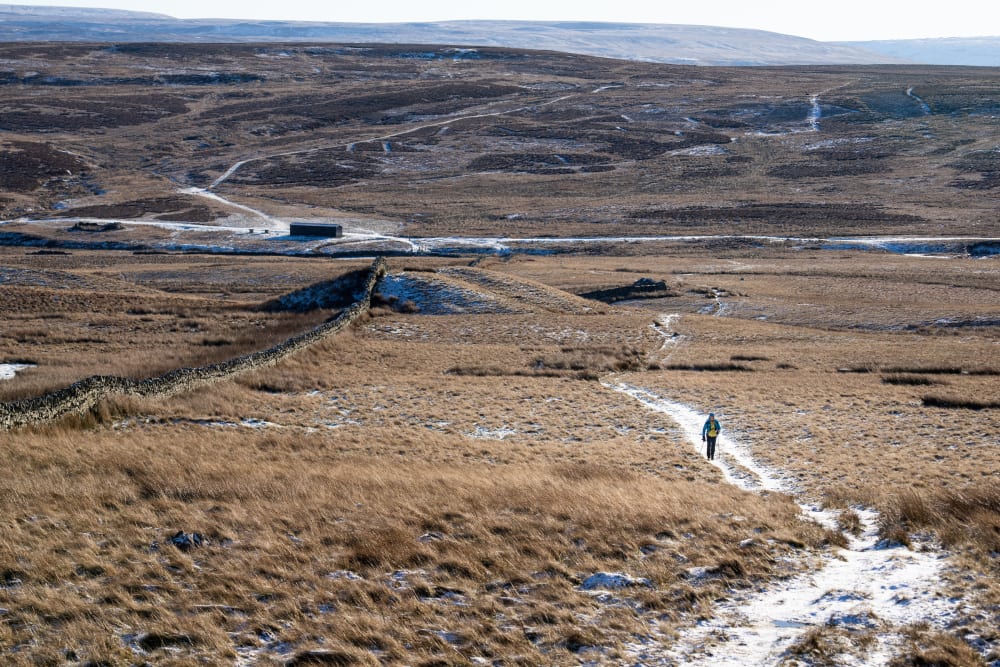
James crossing Cotherstone Moor Mile 135 at the 2023 Spine Race (Photo c/o Steve Ashworth)
Preparation
I am not a great lover of lots of kit, in fact I complained after TDG back in September that I'd had enough of packing a big drop bag and thinking carefully about what I might need 100 hours into a race. Well, let me tell you that only got significantly worse here.
I spent as much time sorting kit out as running and hiking in training for the race.
The physical preparation is easy to cover. I began after a month of rest post-Tor. Two x 200 mile plus races in four months is a big toll and I wouldn't rush to do that again, but it was just how it worked out for me this time. During November I got some steady consistency away, then a big week to start December - with a low key 50km event followed by a four day recce on the second half of the Spine with one of our coaches Eddie Sutton and Jayson & Kim Cavill. It was brilliant fun, a great way to see the course and left me excited about the race in a way I hadn't been before. I'd also run the third section with a friend of mine and five time finisher Matt Neale. And seen various other bits when pacing John Kelly and Damian Hall on their FKT attempts. The only bit I hadn't seen was the first 90 miles. These recce's were most useful for testing kit but particular footwear. I felt I really had that dialled in and you can read a much more in depth look at the footwear solution I found and which worked, at the foot of the report.
And on that note - as a retailer of ultrarunning gear, all that happened as I went sourcing the best kit, was that we started to stock it. Both so I could get it a bit cheaper for me (!!) and so we could pass on a collection of kit that was all in one place for runners interested in the race - with first hand, real world advice. We don't stock it all but we're getting there. All of the links take you to the best place to find each product. It might seem salesy but believe me when I say I think the biggest saving is actually hopefully on people's time trying to find good advice and being able to ask questions about kit/ shop from us at the same time. We're here for the detail.
However, we are not the authority on Spine Race kit. If you have any questions or want to check if what you have meets kit requirements for the race, then you should contact the Spine Race and Lindley Chambers who heads up their kit side of things, via his email [email protected] . You can also read his advice and tips on kit and kit check on this page here.
Back to the story.
The final weeks were a blow for me. I got ill on Christmas Day which wiped out the peak weeks and left me struggling to be fit on the start line. Probably a similar story to most people! But the start line beckoned and I was sure I was well enough to give it a decent shot.
The Start
The start of the race is in Edale, Derbyshire, a lovely village at the foot of the Kinder plateau. To be eligible to start, one must of course pass an epic kit check, see again further down the post for that detail.
Dinner the night before in the Ramblers Inn where we were staying was low key and ideal, the pub is between the start and Registration. The main thing on the agenda was the forecast. It looked like we were going to have a miserable half a day to start, low temps, wet sleet or snow, frozen ground up high and some wind. But after that it just looked bitterly cold. I was delighted which I think was the general consensus....
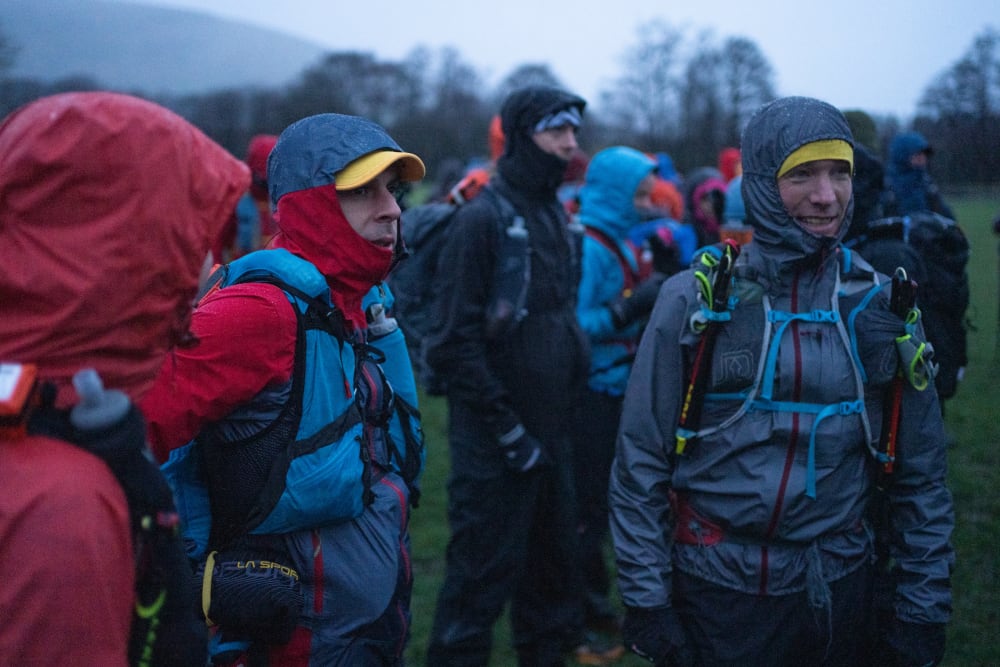
At the start line with Kim Collison and Eddie Sutton. Weather classicly Spine-esque (Photo c/o Steve Ashworth)
The start itself was a muddy wet affair, very Spine like and off we went at 0800 Sunday into the wild.
Day 1 to CP1 at Hebden Bridge is about 46 miles, mostly in daylight for me. It was a bit frenetic as these things always are and whilst the ground was frozen underfoot in places, it was 'a tiny bit wet' in others.
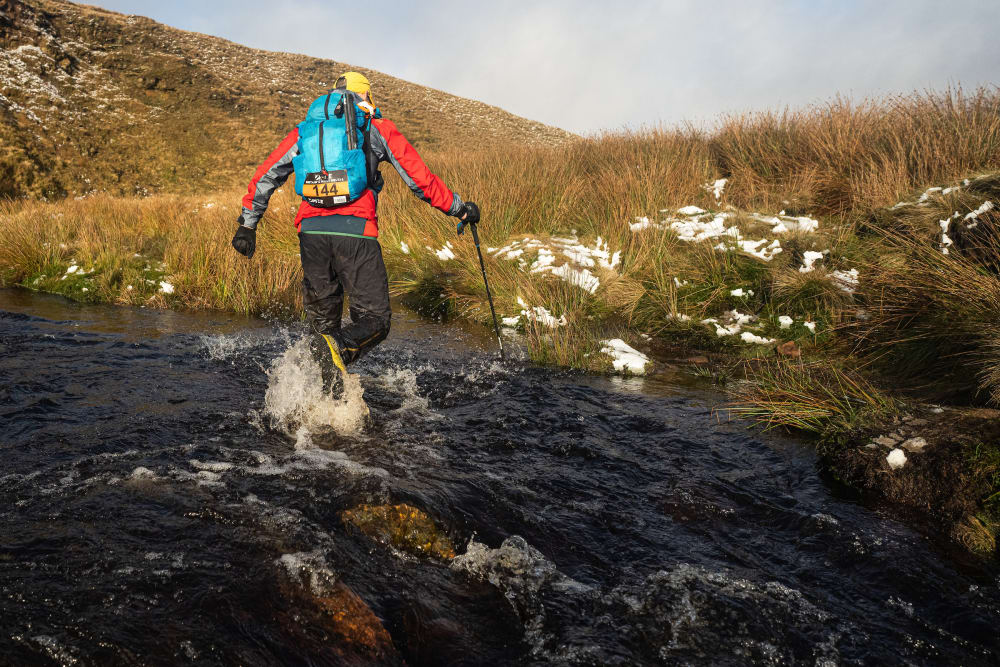
Triple River Crossing at Black Hill on Day One (Photo c/o Steve Ashworth)
It's not an especially hard section, Kinder was a bit of an icy mess but is short lived. The second half of this section is mostly flat and good going so quick time is made. But I felt dreadful as I approached Stoodley Pike, the huge monument marking the end of the tops before the check point. I just felt like the virus hadn't passed, I felt ill. And i couldn't see how that couldn't leave me feeling worse and worse over the coming few days. At Hebden I asked what the protocol was for dropping. I ate a meal served by the wonderful volunteers, decided to go to bed for several hours and just lay there checking train times and moaning on whatsapp to people who probably needed to go to sleep. But then I got up and ate again, with all timings already out of the window I took all of my experience in hand and looked at it logically. I felt shite, but well enough to get to the next check point. It was mostly dry out, in fact it was snowing on the moors which was fine. Let's just go one stage at a time, break it down into tiny sections and take it a bit at a time. See how far I could get, you can't drop at CP1.
Leaving Hebden I motored past half a dozen people, because I was now towards the back of the pack having initially arrived there in 11 hours and leaving in 16. This helped my mental state, unfortunately. Sad as it is when you're moving well versus others around you it makes you feel artificially better than you had before. Then I caught up with Eddie Sutton who was having her own issues, notably with fueling. We formed up and spent much of the next 24 hours together, as we had done in the recce's, just forging ahead to Hawes. We shivered in a tent in Lothersdale with the tri club, trying to stay warm. Enjoyed a breakfast of pain aux chocolat and a coffee on the baby changing table in the toilets at Gargrave. Passed Marco Consani and Graham Connolly having a sleep on the ground. And wend our way to Malham Tarn check point. These small oases in such long sections were welcome. A 30 minute maximum allowed stay time meant a quick freeze dried meal and then off and away. Next up, Fountains Fell and Pen Y Ghent and Eddie was having a harder time moving well on the icy descents. It seemed wise to try to stick together through to Hawes however, certainly more enjoyable and our invisble bungee was just long enough that I'd ping ahead and she'd catch me up before i got cold.
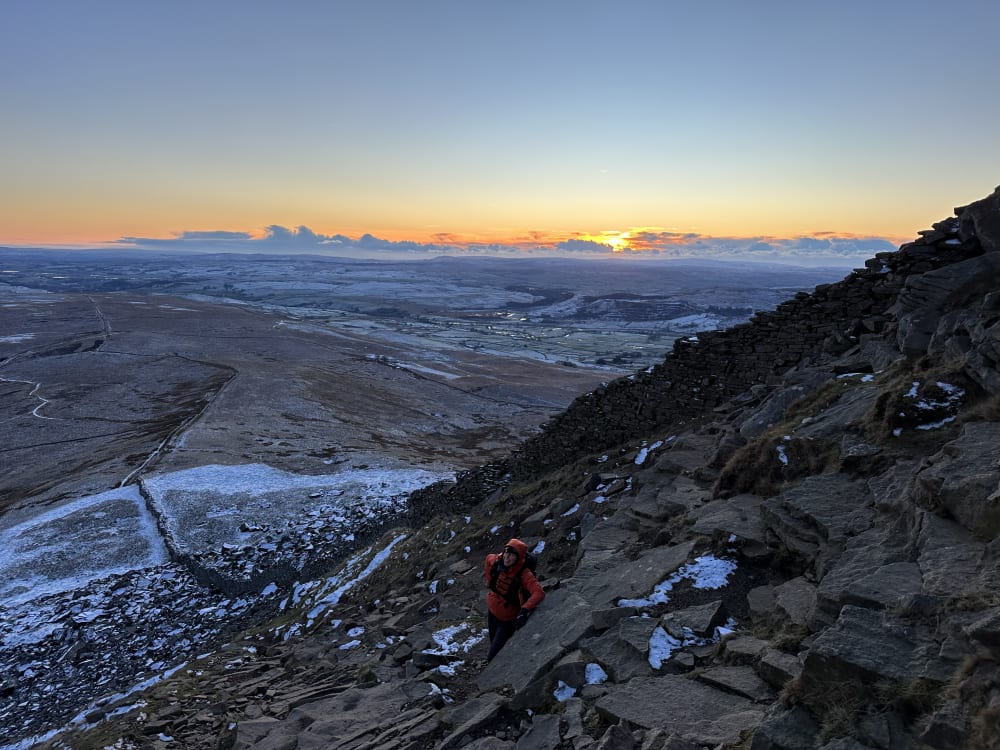
Eddie on the flanks of Pen-Y-Ghent at Sunset
Down into Horton, things got a little uglier as the temperature very tangibly dropped off of a cliff. It had been cold, well below zero but it felt like it fell to a whole new level as the sun disappeared for the next 16 hours. I ran ahead to Horton and started sorting kit and a brew down in the toilet block as a bloke I'd met in the village explained there was no MRT station or check point there. Eddie had some navigation issues, so I went back up the road to find her and then back to the haven of the toilet block. We got all of our kit on, and I mean ALL of it. Before having a couple of hot drinks, getting the remaining food together and setting off for the 15 miles or so to Hawes. 100 metres later we were inside the warm cosy interior of the caving club check point that had been just up the road, drinking coffee and eating a cheese sandwich. Oh well! The Cam High Road sucks. It's a long gradually ascending drag and the cold was real. I was just about the right side of warm enough but that was with a very strong marching pace.
Then the descent to Hawes and with 39 hours elapsed, 108 miles were in the bag. Just 160 to go.
Hawes to the Finish
Four hours at Hawes of which two were broken sleep, then off and up Great Shunner Fell. Eddie left just in front of me and we started the climb together before I pressed on a little over the summit and across to Keld reading room, where David Bone made me a lovely cup of tea. On to Tan Hill I passed Eddie again and made my way across Sleightholme Moor, one of the boggiest least enjoyable sections of the PW, but which on this day was frozen almost solid. The ice was inches thick in places, truly spectacular and I was extremely grateful for that! Then I hit Gods Bridge and Half Way, where Steve Ashworth had popped out to shoot some more of the race and got me attempting to look like a runner past the reservoirs before I motored on to Middleton Check Point.
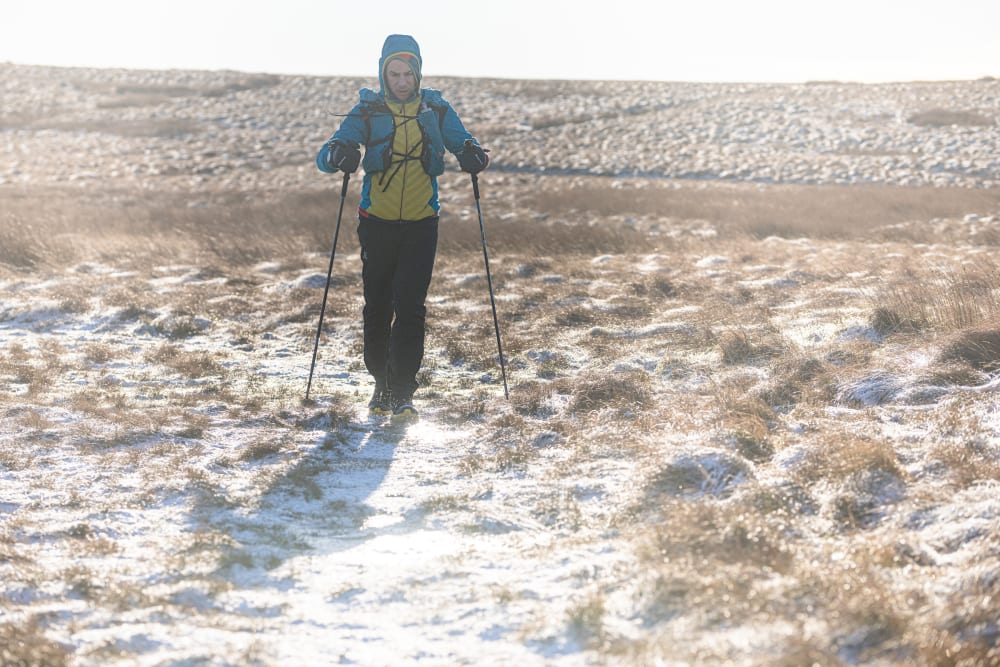
Half Way There Photo: Steve Ashworth
Middleton was the best laid out check point on the course, with big tables to sort gear when you came in, a nice big open room with a fire for eating and resting, and then bunk rooms for some rest. Which by now were quiet. The way the race spaces out even by this stage is pretty dramatic. From the frenetic noisy first two CPs up to this point of total calm. The volunteers here were sensational. From Jess and his crew in the kitchen, to the medics looking at feet and the people helping with kit sort and check out in the main arrival room.
It was at Middleton that I ran in to Matt Neale. We'd been leap frogging the whole way, saying hi and bye at regular intervals. But our races aligned here. I had two hours sleep to Matt's three, we got up, ate a second plate of Jess's chicken korma and decided to head off at the same time into the third night.
We absolutely motored along the flat path past High Force, through the icy rocky mess of Falcon Climts which in my opinion is the best bit of the course. That remote, dead end valley which ends in Cauldron Snout waterfall feels wild and remote and I think it's spectacular. Cauldron Snout was iced up, the rocks were hard to handle and despite Matt and I having a lot of experience in the mountains (huge self pat on the back here as completely coincidentally we happen to be Finishers 72 and 73 of the Big Three UK Rounds), it was sketchy at times and it was easy to imagine some runners having a bit of a melt down in there. We stopped to put more clothing on just the other side in the lee of one of the incredibly remote farms and from there, picked up second placed lady Hannah Rickman who was an absolute pleasure to share the trail with. She was bright and clearly enjoying the adventure with a big smile despite the bitter cold. Over High Cup Nick, the descent to Dufton marking 100 miles to go was the first time the sleep monsters hit hard. The path to Dufton is a big wide open track and I was asleep on my feet. I led down there but I would constantly stop and ask if we were going the right way - Matt was incredulous, 'of course we are there's literally no other path' so on we stumbled. When we hit Dufton, we made our way to the small hall where there's again a 30 minute time limit on your stay. We lay on the floor and woke up 27 minutes into that 30, with a volunteer gently prompting us to get up and get out. This photo may sum up the sensation of that moment.
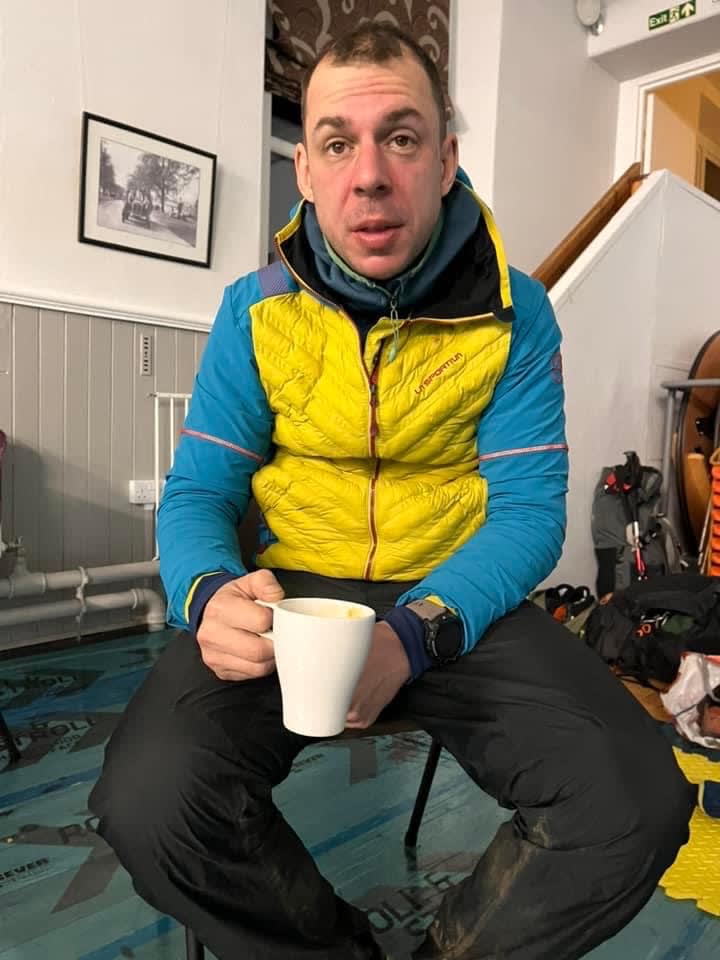
Looking good at Dufton (Photo: Lizzie Faithfull-Davies)
The climb up Cross Fell went ok, but it was so cold up on the plateau and the snow had drifted in to cover all of the slabs so it was tough going. It felt truly wild and Arctic up there, by far the most epic part of the course. Eventually we crested the ridge as the sun rose, and nipped into Gregs Hut for John Bambers incredible spicy noodles and a tea. What an absolute haven that is and everybody is rightly truly grateful to John and his team for manning it. It's a real highlight of the race.
Matt and I ran pretty much the entire 10km descent down the track to 'Annie's house' in Garrigill where we had some tea and toast, she welcomes all of the runners , shoes and all, into her kitchen. WOW. Then the final few miles to Alston we shared with Hannah again. Alston is a real moment I think, you know you are going to be ok from there, it's 80 miles to go but feels like the beginning of the end. A cracking meal and a good sleep for a couple of hours and Matt and I departed again together, via the Spar where we bought a special meat pie to celebrate with in the toilets at Greenhead - because there's nothing else for 40 miles on this section! I'll distill the rest down to the best anecdotes. We moved really well through the remainder, making up many places and not conceding any, overall we'd saved a lot in the first half and that allowed us to really enjoy the second.
At Greenhead we got into the toilets and lay down for a few minutes, grabbed a space on the floor and sorted ourselves out. Some luxury pie was eaten as one of Matt's army mates surprised Matt, hannah and I with some tea in the middle of the night. In a disabled loo. In a deserted car park. On Hadrians Wall. Only in the Spine Race.
The Wall is a stunning section, though tough and we ran that well, but in the woods the other side we started to lose the plot to sleep again. So we lay down in the trees for literally 3 minutes until the cold woke us up. God it was horrendous moving again after that.
Eventually we made Hornystead Farm, four miles out from the last check point where there was some soup on the go and Matt and I enjoyed a lovely nap together on the mattress. I promised I'd never tell, but.... It felt good to finally get some warmth after a bitterly cold 15 or so hours.
We sped on to Bellingham where we planned one more sleep before dealing with the final section. It was absolutely freezing in the check point and the sleeping accomodation was mat and bag on the wooden floor, which was a shame and impacted how much rest we got. But we sorted ourselves out and got off.
The one issue we had over the last two days of the race was that our CP breaks were coinciding with the 8 hours of daylight, so practically the entire second half of the race was done in darkness. That, was hard.
We moved really well to Byrness, it took us four hours to cover nearly 16 miles and we were well pleased at how we were going. We had our final 30 minute limited stay at the check point there with my old friend Duncan Anderson providing some much needed grub having volunteered literally all week - and then up and over the Cheviots. It was seriously cold up there, but beautiful. At times the trail was compacted by runners who had gone before and there were some faster miles, but the snow had drifted in on others and there was no path at all. Knee deep and worse post-holing up the Cheviot itself was truly something special to finish with, maybe a 50 minute mile up there, but then it was almost all down hill and we were still super strong. Matt remarked that if someone had asked us just to crack on and do another stage or two or three we probably could have just fine. It felt like we were right in the rhythm of the race.
Steve Ashworth came out to take some final photos and video a few miles out from the finish. Job done.
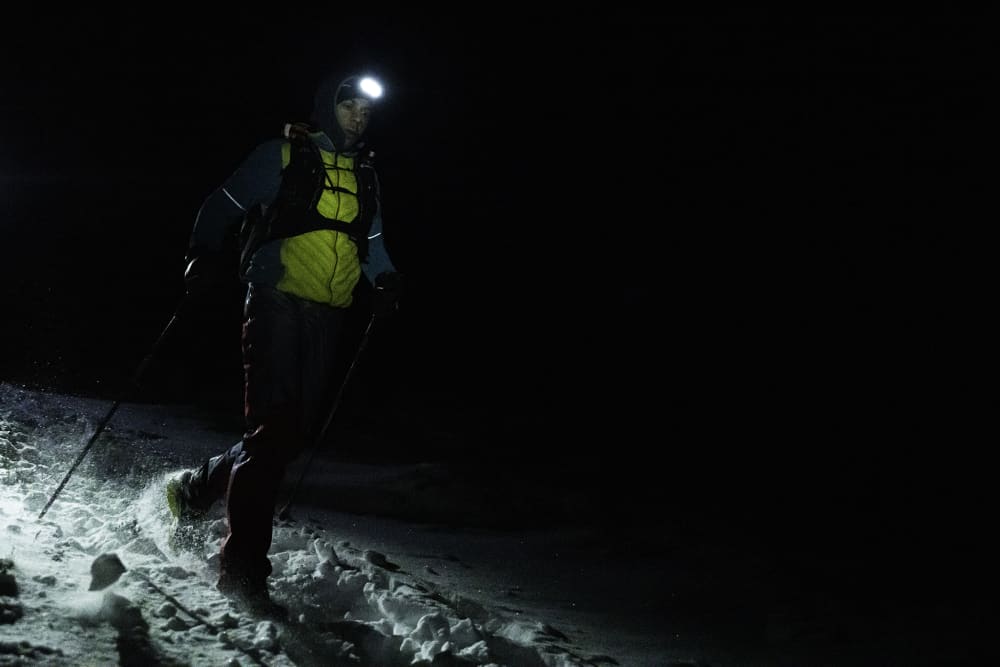
Descending the Schill, the final hill on the course (Photo c/o Steve Ashworth)
And just like that we were in Kirk Yetholm. A low key finish somewhere around 0430 in the morning, a shake of the hand, quick plate of food and back down the motorway to the National Running Show.
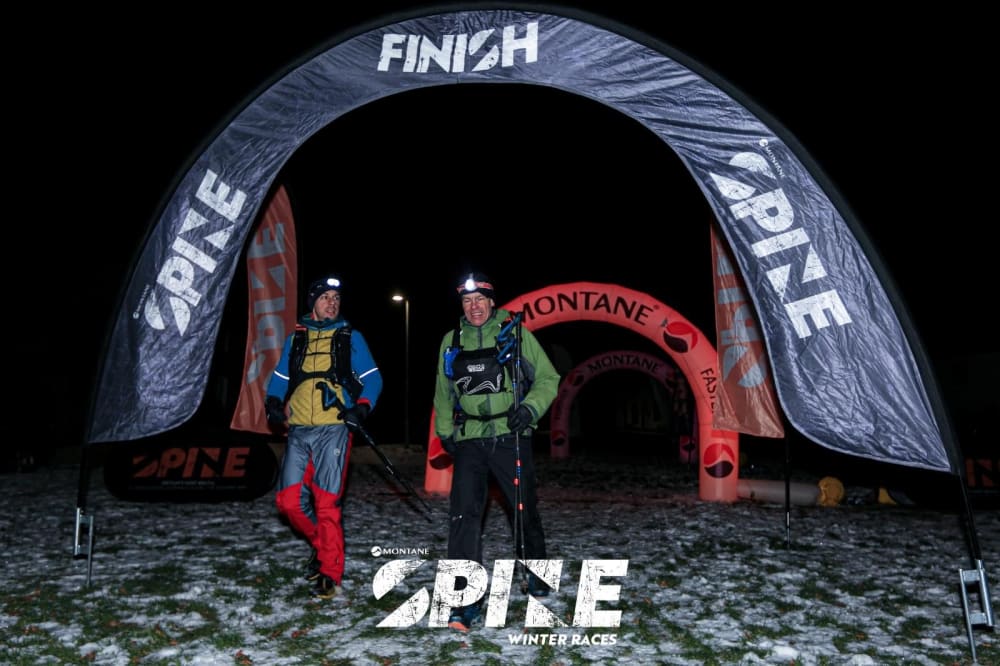
Photo c/o The Spine Race
What's it all about
The questions I have been asked dozens of times at the Run Show and the Arc of Attrition which we worked both of in the 8 days post race, were:
- Have you recovered yet?
I recovered quickly. My feet were good and there were no substantial aches or niggles so I was able to sleep well, straight away, albeit with the regular night sweats in full gear - they are pretty horrible. Each day I napped in the afternoon then slept a full night and was relatively quickly, back a normal routine. We ran out on the coast path on the Saturday, 8 days after finishing and that went relatively well!
Compared to the Tor, the damage was incomparably less. After TDG I had bad blisters, horrendous all body swelling, needed to sleep every 90 minutes or so for about a week, couldn't feel my toes for 3 weeks afterwards and generally felt wrecked.
Perhaps because I expected to be worse this time, and it wasn't so bad, all was a success!
- Would you do it again?
Probably not - never say never but - probably not. Prefaced with I am extremely proud of the finish and it was a true adventure - a rare thing in this world, with an incredible community of people around the race which make it very special indeed. But for me, the joy in running is why I do it, not just the challenge of finishing something. In the last two years I've run the Arc of Attrition 100 twice, the Paddy Buckley, the Charlie Ramsay, TDG and the Spine. They are all up there in the difficulty stakes, and I'd do any one of them again apart from the Spine. Three main reasons. The amount of darkness at the Spine means that you are severely limited in being able to actually enjoy the surroundings. And for us with our CP times falling in daylight hours, my memory of the race is bascially a ten foot bubble of headlamp and my watch gpx trace. Secondly, the amount of kit and terrain underfoot makes running extremely difficult - it is just extremely slow going. Thirdly, the Pennine Way is wildly beautiful in places, but atrociously managed in others. There are far too many low lying field paths that have been destroyed by farming, both animals and vehicles. Lots of very bleak moorland. Sections which you frankly cannot believe are part of our oldest National Trail. Even in summer it is in many places, a mess. There are jewels in her crown, incredible highlights that are up there with the very best scenery and trails we have here, but you miss so many because of the dark and they are at times spaced out by miles and miles of terrible ground.
The reason to do it again would be to be part of the wonderful Spine community. The volunteers were out of this world and clearly the race has a magic feel around it which is second to none. It will mean the world to you if you can finish this one.
- How hard was it?
Very difficult, terrain, weather, amount of kit, amount of darkness, overall distance - all make it extremely hard. Not as hard as the Tor in my opinion. And one must always look at the finisher rate/ times. To finish within 7 days is I believe a reasonable ask. There are runners who struggle to finish our events in 30 hours, who will routinely finish the spine a half a day inside the cut off. But to push it at the Spine, to race it hard, is truly up there in the overall list of things I've personally had a go at.
KIT AND LOGISTICS
This area of the post is specifically designed to look at the detail of all aspects of the kit, footwear, apparel, nutrition and miscellaneous items that you need to think about in order to compete safely and successfully in the Spine Races or indeed, for winter in the mountains.
- Click here to visit the store collection on our website, containing the majority of these products.
- Click here to watch a longform video going into all of the kit for the Spine Race with James Elson (YouTube)
- Click here to read James' race report from 2023.
- Click here to listen to James' recap podcast of the 2023 event.
- Click here to listen to a British Ultrarunning Podcast conversation between James, Dan, five time finisher Matt Neale and 2023 Mens Race Winner Damian Hall.
- Click here to listen to the Tea and Trails podcast with Eddie Sutton on her 2023 Spine Race. Eddie is a Centurion Coach and third place finisher in 2023.
This video accompanies this post, going into further detail on all of the items below as well as the drop bag and how to think about packing for the race.
Clearly a huge caveat needs to be placed at this juncture. Every single person emerging from the Spine will have a different view on kit, how in functions, what minimum requirements are vs what you actually need to carry.
You need to think very carefully about what you need to carry/ have access to and not just what's on the mandatory kit list. The kit list is there as a safety net and often just in case of emergency. What you actually require to stay safe and perform well at the Spine Race goes far beyond it.
We also need to be realistic about cost and what you do and don't need to buy. Some of the kit is very expensive plus there is of course a large energy cost to production and transport in a lot of cases. So consider what you have already that is fit for purpose, what can be borrowed and what can be hired. As time goes on and we are able to put the time and resource into it, hiring kit is something we'd like to get into - many already do this. The facebook group here is a valuable resource in borrowing kit or getting advice on how to look after it.
Cheaper alternatives are available for everything, always look at the compromise though: Weight vs Packability vs Price. We've picked out the best balance of those three things, in our opinion.
And on that note - as a retailer of ultrarunning gear, all that happened as we went sourcing the best kit, was that we started to stock it. So that we could pass on a collection of kit that was all in one place for runners interested in the race - with first hand, real world advice. We don't stock it all but we're getting there. All of the links take you to the best place to find each product. It might seem salesy but believe me when I say I think the biggest saving is actually hopefully on people's time trying to find good advice and being able to ask questions about kit/ shop from us at the same time. We're here for the detail.
However, we are not the authority on Spine Race kit. If you have any questions or want to check if what you have meets kit requirements for the race, then you should contact the Spine Race and Lindley Chambers who heads up their kit side of things, via his email [email protected] . You can also read his advice and tips on kit and kit check on this page here.

What I've done here is distilled down my experience not just at the Spine but of a nearly two decades of racing in all conditions, utilising a wide range of winter kit over and over again - as well as organising more 100(+) mile ultra distance events than anyone else in the country! I know there will be some people who have no idea of who I am so I have included a short bio at the end of this post.
This kit has been used, not actually mainly in racing but in training and on days out on the hill, in winter. You must get used to using the kit, particularly working out what footwear and what layering systems work for you. I am around 65kg, 5ft7 and without tooting my own horn, tend to move towards the mid to the front of the pack in events. I would say days out over the Wainwrights in winter were a turning point for me. Learning to read the forecast, particularly with regards to wind speeds at height, anticipate clothing requirements, navigate in the dark and mist with map and compass and scramble/ climb very difficult ground - these are the skills that make me feel most comfortable in terrible weather. A lot of my racing might also seem irrelevant but you draw on the experience of everything that has gone before, in events like the Spine. Races/ Rounds I've run that help contribute to choices here include Tor Des Geants, Arc of Attrition, Lakeland 100, Western States, Bob Graham, Paddy Buckley, Charlie Ramsay, Leadville, Lakeland, 4Deserts Series (antarctica being the most cold weather specific). But more so things like the Wainwrights in winter, crossing Iceland on foot and many long days out by myself.
Finally you will find kit suggestions and comments throughout this text which features my own kit. Firstly from two of our team runners - Debbie Martin-Consani who has finished the race twice including a win at the 2022 edition. And Edwina Sutton who finished third in the 2023 race. Finally, from 2023 Mens winner Damian Hall.
A link to the full mandatory kit list for 2023 is available here. All of the below kit meets the criteria for the event.
Footwear:
Clearly, managing your feet is one of the handful of major things to concentrate your energy on. For some time as a team we had been waiting on the La Sportiva Cyklon Cross GTX to come out. We'd sat in a team meeting back in April and Jono Wyatt had pulled a pair out and previous race winner and PW Record Holder - John Kelly - sitting to my right, had asked on the spot if he could possibly just take them home with him. They are effectively an insulated, waterproof, lightweight shoe - that looks like a boot due to the gaiter. The sole unit is La Spo's grippiest rubber. The upper is soft, warm and you can dial it in tight or back it off using the boa system. Then there is a Gore Tex gaiter coming up to ankle height, so effectively there are two waterproof layers to the shoe. This kind of shoe has moved the game on with regards to protection from winter/ very wet or cold conditions. It feels like you are wearing a lightweight shoe, whilst getting the protection of a mountain boot (not crampon compatible as the sole is not rigid enough - great with microspikes of course). Others were still wearing regular trail shoes and asking more of their socks but for me whether you are running up the front or scraping cut offs, this shoe does it all. The other model I had in my armoury was the La Sportiva Blizzard. This is again a Gore-Tex shoe with a debris gaiter, and has a metal stud matrix built into the sole unit - essentially built in nano-spikes so you can run across ice without issue (note these will not pass kit check, you still need a separate set of spikes or yaktrax).
The other component of course, is socks. I hadn't worn waterproof socks since the Last Desert Antarctica in 2008. But I got hold of some Dexshell Compression mudder socks and quite frankly they became the most important piece of kit I had. They are impermeable to both water, but also to debris. And at knee height you have to be in a very significant bog or river to get water in the top. If that does happen, they then insulate that water like a wetsuit, and keep your feet warm.
I had no liner sock, just the Dexshell. I started in the Cyklon Cross. Because it was minus 2-3 in the valleys and 6-7 on the tops all week, every hard surface was covered in ice so I then used the Blizzards for Day 2 and 3. Before going back to the Cyklon Cross for the last two sections.
All four of the runners mentioned on this post including myself, Debbie, Eddie and Damian all used the same DexShell sock for this race.
2022 Womens race champion Debbie Martin-Consani used a liner sock in combination with the DexShell and had just as much success with her feet - Debbie talked about her foot route in a post-race intstagram post here. Liner socks should be thin, it is well worth experimenting with both options in your training. Damian Hall comments: 'I too use DexShells and tend to wear a toesock as a liner. The only problem I've had is from feet being too warm in conditions less severe'. Again, test them in training.
With the Dexshell Sock, and then the Cyklon Cross/ Blizzard I had zero blisters (i had one small bit of skin come off at the finish because i tore off a bit of preventative tape too soon with wet skin underneath), zero hot spots, never once got cold feet and always had the grip I needed. I took my shoes and socks off in at the 144 mile check point and the medic asked me where I'd washed my feet - they stayed that clean and clear. The Blizzards - after 40 or so hours began to make my feet tender, I think where the sole is more rigid and the spikes less forgivining but they were priceless for the icy rocks, hence the switch back to the Cyklon Cross. I take half a size up in both to allow space for the thicker Dexshell Sock.
So as an N of 1 sure, but if you want to get through the Spine without foot issues, there's a good system to try. This is more of an invidivual area than almost any other part of your race strategy, besides nutrition.
Separate Spikes or Yaktrax are part of mandatory kit. Nanospikes won't pass kit check. I would always carry a Yaktrax for speed and weight, but also have my Kahtoola Microspikes in the drop bag. These are essentials for any winter mountain day anyway, will see plenty of use! I've had my Yaktrax since 2008, still going strong.
La Sportiva Cyklon Cross
La Sportiva Blizzard
Dexshell Mudder Compression Socks
Kahtoola Microspike
Yaktrax

Freezing waterlogged paths - but no water ingress or foot problems.

Kirk Yetholm: Completely blister free, dry feet. (Photo c/o Steve Ashworth)
Lower Body:
All through training including in sub zero temperatures for many hours, I'd worn one pair of tights and lightweight waterproof trousers. But in the race this was simply not enough. I ended up putting on a second pair of tights and then a waterproof trouser. I needed two pairs of tights to stay warm enough at the coldest times. Remembering then that these stayed largely dry through the race, I didn't touch my spare/ third pair but you need to carry one additional pair to that which you are wearing. I can't see getting away with less than three pairs of tights is viable, and a fourth would be wise.
As for the trousers, the Drizzle Pant (unisex) is a light, tapered running waterproof trouser, you feel like you can move fast in them. This was good for almost everything, you could put on a heavier Gore-Tex weight trouser in wetter weather however, that could be a valuable addition.
On the lower half, Damian Hall, moving on the whole much faster (than almost anyone else!) found that one pair of tights was often enough, with a pair of lightweight waterproof trousers over the top just for the very worst sections. But certainly for us slower movers a bit more protection is worth getting used to in training.
Montane Tight / (Womens Edition) - 3 Pairs
La Sportiva Drizzle Pant
Montane Spirit Lite Gore-Tex Waterproof Trouser
Upper Body:
This is a huge area, clearly. A good mountain layering system and an understanding of that is worth looking at. I know some runners will simply stick a Buffalo Jacket on and that'll cover almost anything they need. But I prefer the layering because it allows flexibility around conditions.
You should look at having a base layer. Two mid-layers - ideally a breathable fleece type material and a heavier weight fleece jacket, a primaloft jacket and two outer shells - a windproof and a waterproof.
For the majority of the Spine I had on six layers. Base Layer - La Sportiva Jubilee. Mid-weight fleece - the OMM Core Jacket which is super light, breathable and packs suprisingly small. A La Sportiva zip up fleece hoodie / Montane Protium Hooded Fleece. My La Sportiva Primaloft jacket. My Blizzard Windproof. A Montane Gore-Tex Active outer shell which I had on in the wet/ snow showers only. In training, I never had more than three layers on. But thermo-regulation goes out of the window several days in and you need to anticipate wearing far more than you ever will in preparation.
You then also need to have back ups for these layers. They will get wet at some stage. Having spares in your pack and your drop bag, is essential. Here's how and why.
Before a base layer for us men, Eddie Sutton adds 'this sports bra is thick (think free extra warmth) but has no seams and a large surface area to protect back. I had no chafing under arms or on back and it never felt wet so I didn’t get cold.'
A good base layer needs to be able to move moisture away from your body whilst insulating to a high degree here. The truth is at the Spine you are only really sweating up on climbs and even then if you are, you need to look at your effort level. I had several, one on me, one in the bag (that is the mandatory kit rule - one spare base layer not in use) and then a couple in the drop bag.
A good quality Waterproof Jacket is obviously crucial. Whilst a 10k/10k lightweight jacket will pass kit check, it's absolutely inappropriate to start this race with something that lightweight. The minimum level I'd suggest for the race is Gore-Tex Active. Right now we have the privielege of being able to wear a Gore level jacket which weighs close to nothing. The jacket I had for the majority of the race was the Montane Phase Nano. This is the evolution of the Spine Jacket. They are both Gore-Tex Active which translates to much greater protection than any of the other lightweight (10k - 20k range) jackets, durable, adjustable hood and hem and extremely lightweight. The womens edition of the Phase Nano is not out until September 2023. So the Spine jacket for both men and women and then the Phase Nano Mens from Spring and Womens from Autumn 2023 are the pick of the bunch for me.
Eddie Sutton comments 'I had run in a montane spine jacket for a few years size 10 one…then about a month before the race I purchased a size 12 one which I wore for the race and was so pleased I did. It enabled me to wear more layers underneath, I had more mobility and it was easier to get the hood up and down. I then took the size 10 in my drop bag ready to double layer if I needed to but we had a dry year!'
Some will point to needing heavier jackets than this - Gore-Tex Pro, higher denier grade material will stand up longer to bad weather, but that is personal preference - again weight vs packability vs protection - I believe Gore-Tex Active in these latest Montane jackets is the way forward.
You could certainly argue the case for needing one or two spare jackets too - if you are soaked through and keen to leave a check point in a hurry.
I would put a good windproof up there as just as important as a waterproof. There were times during the race where the wind was up to 40mph and on a -6 temperature reduced wind chill to -15. That cuts straight through a waterproof because of the nature of the material, where a windproof offers substantially more warmth/ protection. It still amazes me how a garment I use almost every day is so neglected in the running world. The Blizzard and Briza are nnot much over 100 grams and provide that layer of protection.
Finally the Primaloft layer, go for primaloft and not down. Primaloft still works as an insulating layer when it wets out but down does not.
M&S Reversible Seamless Sports Bra
La Sportiva Jubilee Base Layer (La Sportiva Blaze - Womens Equivalent) x 4
OMM Core Jacket Mens / Womens
Montane Protium Lite Mid-Layer Hooded Fleece Mens / Womens
Montane Phase Nano Mens / Montane Spine Jacket Womens
La Sportiva Blizzard Windproof (La Sportiva Briza - Womens Equivalent)
Headwear:
The main way you will regulate your temperature during the race is by removing or adding hat/ headwear and hoods. Far simpler and quicker than removing layers. The Core Beanie from OMM is breathable, so you don't get a sweaty head. It weighs next to nothing and is made out of primaloft active.
Another good option is a headband which allows your head to release the heat whilst ensuring you don't get cold ears, which can be a real issue.
Hoods up or down in conjunction with how cold / windy it is - the hood on your windproof being the main one to use.
I also wore a Weather Resistant/ Waterproof Cap for the first day when it rained hardest, just to re-inforce the peaked hood on the waterproof jacket and ensure rain stayed off of my face.
Take plenty of buffs. We all have them. Good for face covering, extra warmth/ neck cover, head cover and of course wiping stuff up!
OMM Core Beanie x 2
OMM Kamleika Waterproof Cap
Centurion Versatile Head and Neck Wear
Gloves
Understanding combinations of gloves based on how cold and wet your hands might get is obviously as important as any other facet of your kit. If you lose operation of your fingers, you can't eat, undo bottle caps, undo zips/ change clothing. Basically somewhere between inconvenient and dangerous. Getting into this situation was the defining factor for me in bailing off of a second Barkley loop in 2019! I got my kit wrong when the weather turned very quickly and couldnt' navigate or do my jacket up.
A liner glove, with fingers is worthwile and worth having several pairs of. I'd start with one on and one in your bag (mandatory kit). Then a couple more spares in your drop bags.
As a warm overmitt, always go for Primaloft over Down, because when they get wet - the primaloft will still work as an insulating layer. The Montane Prism Dryline is their warm Prism Mitt, super soft, comfortable and light, but with a pertex waterproof layer. I had three pairs. One on. A spare in my pack. One in my drop bag.
Then a waterproof outer glove for really harsh conditions - the Minimus overmitt also from Montane. Just one pair of those.
Montane Trail Glove (liner glove) Mens/ Womens x 4
Montane Prism Dryline Mitt or Mens Glove / Womens Glove as per preference x 3
Montane Minimus Waterproof Mitt
Pack/ Belt:
During the race I used 2 different packs. I started out with an old S/Lab Peak 20 which was a skimo pack from 2017 - basically an old faithful. Before I got hold of a Montane Gecko 20. It was a case of using what I was used to. I switched to the Gecko 20 at Middleton when the back zip failed on the Salomon and that must have been fate. Because the comfort level of the Gecko is incredible. For me it is the superior option and I wished I had started in it. The best features in my opinion are the adjustable straps across the front which allow cinching around unknown layers of clothing, and the comfortable waist belt that takes some of the load off of your shoulders. But particularly the soft elastane blended material and side pockets. Unlike almost any other pack you can reach straight into them, just down of your waist but close to the front, and stuff them full of almost anything you might need on the run. Honestly they are like Mary Poppins' bag. The fit is exceptional, so comfortable and despite the weight you barely notice you have it on. For me, there was always ample space in the back - I packed light but then added a complete set of spare clothing on the top for easy access and there was ample room. I also used a Naked Band for additional space early in the race, particularly useful for excess nutrition.
Eddie sutton also used the same back and trained and raced exclusively with it. She comments 'it's a super comfortable pack, I didn’t feel the weight or pack rubbing (but I trained a lot with the pack too!) I brought an extra chest strap from montane and attached that high up which made a huge difference too.'
For further space, the OMM Chest Pod is compatible with almost any vest or pack, by adapating the fastenings that are provided with it - giving you front access to another 4 litres. I have never found I have needed this, but many in the race use this set up.
For greater capacity - if you are someone who plans to carry bulkier jackets, extra food, or less packable sleeping bags etc, then the best 30 litre option is the UD Fastpack 30, or FastpackHer 30. Again with the belt added for more space.
Montane Gecko VP20+
Naked Waist Band
OMM Chest Pod
Ultimate Direction Fastpack 30
Ultimate Direction FastpackHer 30

Centurion Coach Eddie Sutton rocking the Montane Gecko VP20+ en route to third place at the 2023 event (Photo: Steve Ashworth)
Lighting:
My go to lamp for the last 3-4 years now has been the Petzl Swift RL. Light, packable, easy to change rechargeable battery, long lasting and plenty of light and power. But. I found out during the first night that the lamp didn't like just how cold it was here. It's not been asked to do that duration in that cold before and because the battery was front mounted on my head, it was more exposed to that cold and seemed to drain quickly. That is anecdotal, lithium batteries should not drain any faster in that level of cold per se but that was my experience here. The batteries were all fully charged.
So I switched to my Petzl Nao RL which is Petzl's newest headlamp offering. On low reactive setting I got tons of light, more than I ever needed, and one fully charged battery lasted over 20 hours. I would only ever choose this lamp again. It's light, the battery is on the back which balances the weight out on your head, and crucially means it is protected from the bitter cold by your hood/ gets less cold.
A rear Red LED is mandatory. Rather than a cheap one which will likely break, I attach a Petzl E+Lite which has the added bonus of being usable as a back up emergency lamp with several other settings.
Petzl Nao RL x 2
Spare Nao RL R1 Batteries - x 4
Petzl E+Lite

20 hours plus on low reactive setting with the Petzl Nao RL - always enough light to move well. (Photo: Steve Ashworth)
Sleep System:
Full disclosure here, I used this in training and on the freezing cold floor in Bellingham but I did not Bivi out during the race. The Thermarest Hyperion has a comfort rating of 0 degrees C. It is super lightweight, but immensely comfortable and feels substantial despite how small it packs down. It is the minimum rating to pass kit check, but honestly with the Mat, Bivi and Clothing you have, I can never see more than this bag, being required. You can of course find other marginally lighter, extremely expensive alternatives but with performance vs packability vs weight, this is the optimum bag for me.
The sleep pad - I opted for the lightest as once again, I wasn't planning on a bivi unless in emergency - but I am happy having bivi'd on it before that whilst not the most comfortable night, as an insulating layer it does everything you need eg. gets you off of the freezing cold ground which is conducting your body heat away very quickly indeed. The Neo-Air Uberlite inflates extremely quickly and is a pass at kit check. Again it feels substantial. To me, the mat is the least important thing. If you try to inflate a mat like this with little or no shelter in high wind in an emergency you may as well be holding onto a kite. You need to get the bivi out first and try to inflate the mat inside of it whilst pinned down and ideally behind shelter. You need to practice these things in training!
With the bivi, I have again gone super lightweight, almost as light as you can go. The less durable bags eg SOL will fail at kit check. This is a waterproof bag with taped seams and perfectly adequate to keep you protected for short sleeps or awaiting assistance. This isn't a bag I'd hang out in year round for comfort - but that isn't why I am carrying it during this event.
Thermarest Hyperion 32F/0C Sleeping Bag
Thermarest Neo-Air Uberlite Sleeping Pad
Terra Nova Moonlite Bivi - We will have these in stock from end of March 2023.
Navigation:
The Pennine Way is not a well marked trail. You will find finger posts and the acorn symbol in lots of places. But nothing it all in much greater amounts. Map and compass are mandatory kit and for good reason. If you'd had your watch die and/ or your OS App jumping all over the place in heavy clag on the high mountains, you need to be able to use them. Again for me it was a hard lesson on top of Red Pike by myself winter in serious conditions when the electronics all failed that forced me to take 'thumbing the map' more seriously. But, I would use the maps as a back up here because you ideally want hands free for poles, eating and gates. So use the excellent GPX trace, uploaded on your watch. It will tell you when you are going off course and when to make a turn. The Coros Vertix 2 has the longest battery life of any watch going, so we stock that to try to ensure least charging time.
The handheld GPS you will see some using as a primary navigation device but more often than not it is a back-up. We used it on the Cam Road section on the longest stretch between check points, when my watch died. The Garmin 66S is easy to use even with big gloves on, takes 3 x AA batteries which are easily changed and is essentially bomb proof navigation. You need to learn to use the funcationality before you head out, you will need to upload the right maps for the Pennine Way - it doesn't come with these built in and you will be best off leaving it switched on, so if you do need to use it it is already there with the route and your position on it, not loading up in harsh conditions as you stand around waiting for it.
Reference a compass, I personally prefer a thumb / orienteering compass, but that won't pass kit check here so get a solid reliable compass like the Silva Ranger instead.
Coros Vertix 2
Pennine Way Harveys Map: North and South
Garmin 66s Handheld GPS
Silva Ranger Compass (coming to store soon!)
Poles:
I'm not sure if anyone went without poles but I'd be suprised. For stability, for measuring the depth of bogs - seriously, and for more efficient forward movement they have to be considered essential. Whilst I am a huge fan of Leki's Ultratrail FX.One Superlight poles which I used for TDG, I have always used a Black Diamond Carbon Z or FLZ pole when wearing gloves. They are super light, durable, fold down quickly and easily when out of use and most importantly have an easy to adjust hand strap so that I am not trying to squeeze the otherwise excellent Leki Shark Glove system over several layers of changing glove types. The FLZ have the added bonus of being height adjustable on the move.
Poles: Black Diamond Distance Z Poles
Stove/ Cooking / Eating System:
Aim for me is to be able to boil water quickly and simply but for it to be reliable. Whilst meths is lighter and more packable, the chance of a leak and the hassle of the longer burn time don't make it worth it for me. So I like gas options. Stoves are tiny these days and I use an Alpkit Kraku screwed straight into the gas canister, with storm proof matches to light. Remember you can't blow these out! So get used to letting them burn out in your hand like a sparkler! The Bugaboo mug from GSI is titanium so super light and useful obviously for drinks at the CPs - it is also good to use on the stove and boils extremely quickly, the 400ml limit you need to carry for kit - also coincidentally the amount you need for most rehydrated meals. I'd say good going less than 5 minutes to brew. The bugaboo will be HOT when you pick it up, but the handle is separated - so make sure you wear a glove and within a minute or two is fine to hold. Again, I wouldn't use this system day to day but on the spine (the bugaboo is not meant for this, it will eventually start to deform if you burn it for ages and ages) but it's everything I need here and more. The Titanium Spork from Optimus weighs nothing.
For flasks/ water, it's worth carrying insulated soft flasks so that your fluid has less chance of freezing. My flasks froze several times leaving me an issue on those sections. It is also worth carrying a filter bottle which you can then decant, if you choose to or need to fill up from questionable sources.
Alpkit Kraku Stove
GSI 110g Isobutane Gas Compatible with that stove
LifeSystems Storm Proof Matches
GSI Bugaboo Cup
Optimus Spork
Salomon insulated soft flasks x 2
Katadyn Befree Filter Flask 600ml
Medical
Take a decent medical kit with you. Look at what is on the kit list, ensure you have it all but also think - what do I really need to carry? Pre-taping feet and having the right, quick to use tools to do that is something to look at pre-race. I am not a big fan of pre taping, but the conditions at the Spine are unique and by adding tape strategically you can often offset some of the worst problems. Remember, don't get into a check point and rip the tape off. Be careful. Your skin will be moist underneath and will tear more easily, so take extreme care when removing and replacing tape.
Lifesystems Waterproof Micro First Aid Kit
Lifesystems Blister First Aid Kit
Other Mandatory Kit
Lifesystems Hurricane Whistle - far better than the one that came free with your pack. They will make you blow it at kit check!
Swiss Card Knife/ Scissors - This is an expensive option but essentially gives you lots of other useful kit for almost no weight/ size. The blade passes kit check in length. Cheaper replicas are available.
Bolle Safety Goggles - Light and cheap. Tinted expensive ski/ mountain goggles won't pass kit check, you need a clear goggle. These are worth getting used to in training as they need to be adjusted to feel comfortable. Lots of similar options in their range, must have a headband.
GSI Cathole 'Poo' Trowel and Tissues plus poo bags
Food and Drink
This is perhaps the most individual area of all. My advice to you is to consider carrying not just the 3000kcal minimum you are required to have, leaving each check point, but ensure what you have is going to be appealing and easy to consume over very long periods.
In races in the past I have consumed exclusively gels - including at Western States in 2011 where I ate 70 Gu's. For this race I took almost no sports nutrition with the exception of some Maurten 320 CAF 100 drink mix primarily for the caffeine overnight.
The other critical component is thinking about freeze dried meals. You won't need these at the check points which are very well stocked, but you will benefit from them at certain points in between. Either at the 0.5 check points or at the pop up locations with MRT where hot water is given. Or again, if you stop to brew up yourself.
I ate all of these things during the race and these options worked best for me. This is a very individual area however.
Expedition Foods Freeze Dried Meals
Gu Stroopwaffels
Chia Charge Mini Bars
Clif Bar Mini's
Maurten 320 CAF 100
Succeed! S! Caps
Non Mandatory but Borderline!
Battery Packs: I used two larger power banks here in my drop bag, to charge batteries between check points. And then two smaller ones here that I carried on my person. Plug sockets whilst available at some check points are far from guaranteed. This system allowed me to charge everything for 5 days, with plenty of power to spare, without ever needing mains power. My watch, headlamp and phone cables, I carried in my bag to recharge on the go - I only needed to do that between Hebden and Hawes due to the length of that section. But it was nice to know I had that option if I needed.
Lifesystems Ear Plugs - It's noisy in the bunk rooms!
Anti Chafe: Bodyglide
Dry Bags: The Ortlieb 13 litre dry bag fits nicely in the Montane Gecko 20 and is truly waterproof/ hard wearing. I then use lighter Exped Fold Lite Dry bags for other kit and my bags to go inside drop bag bags.
Repair Kit: OMM Waterproof Patches, Cable ties, Duct Tape, KT Tape, bungee. Shoe, pack, pole, clothing repairs are almost certainly going to be required at some stage.
BIO
My Spine Race finish in 2023 came 17 years almost to the day, fter my first ultra.
I began in 2005 and my first big adventure was the MDS. I went on to become the youngest finisher at the time of the 4Deserts Series including multi-stage races across the Gobi, Atacama, Sahara Deserts as well as on Antarctica. In 2009 I began running 100 milers and have finished quite a few of the bigger marquee events to date including:
Western States, Leadville, UTMB, Arc of Attrition, Lakeland, WHW Race, Caesars Camp, Old Dominion, Rocky Raccoon (x 5), Autumn 100 etc.
I've also explored the longer single stage races finishing Badwater, Spartathlon, GUCR, many 24hr races including 2 Silver medals in a GB vest and more recently the Tor Des Geants.
In 2011 I started Centurion Running and we've had a stable of 50 and 100 mile races since that time. I have personally Rd'd over 50 races of 100 miles or more and 30 x 50 milers in that time.
Outside of racing I ran the Bob Graham in 2014, the Paddy Buckley in 2021 and the Charlie Ramsay in 2022 made me the 73rd person to complete the Big 3 in under 24 hours. In 2015, I ran across Iceland with Robbie Britton - a very cold expedition over 7 days/ 200 miles. I completed my Wainwrights journey many years ago with many wonderful solo days out in the hills in all conditions.
In addition I've run 150 marathon+ events with a PB of 2:43 and finished both Ironman and long distance cycling events.














